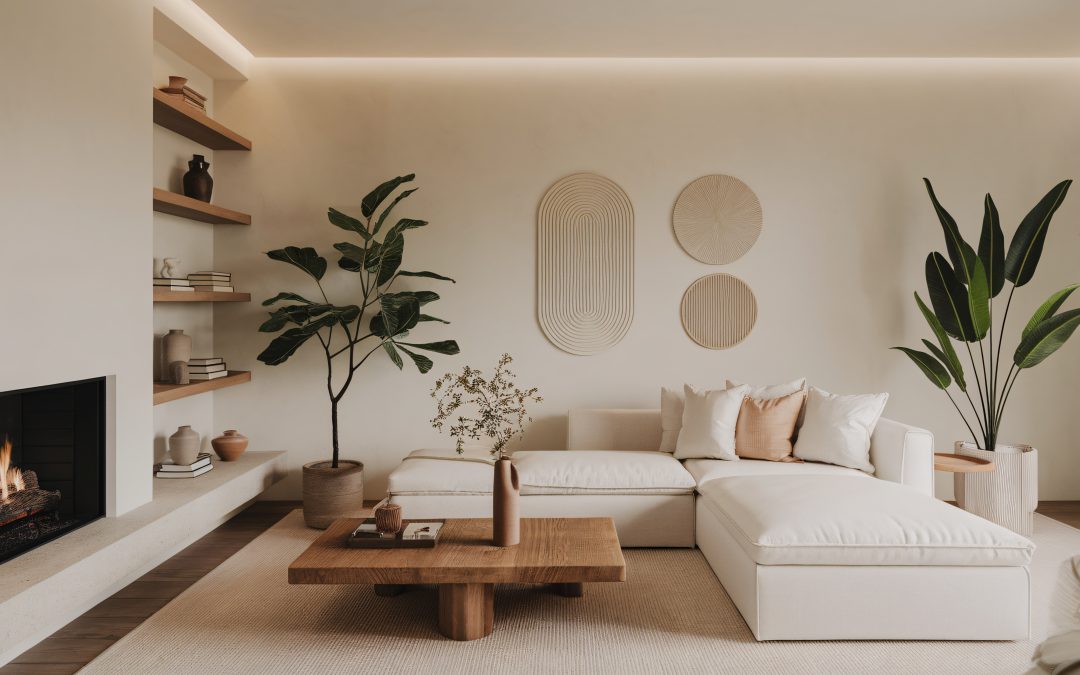
by Kesaa Interiors | DECOR & DIY, DESIGN GUIDES, Furniture & Layout Guides, Living Room, ROOMS, Small Space Hacks
Looking for tips to take your cozy living room decor in your small apartment to the next level? You have come to the right place!
Living in a small apartment doesn’t mean you have to sacrifice style or comfort. In fact, creating cozy living room decor in a small apartment can be a really fun challenge! It’s all about making smart choices and getting creative with your space.
I’m excited to share some of my favorite tips and tricks for maximizing every square inch and creating a stylish and inviting living room, perfect for those of us dealing with limited square footage. Get ready to transform your small space into a cozy haven!
The Best Cozy Living Room Decor for Small Apartment!
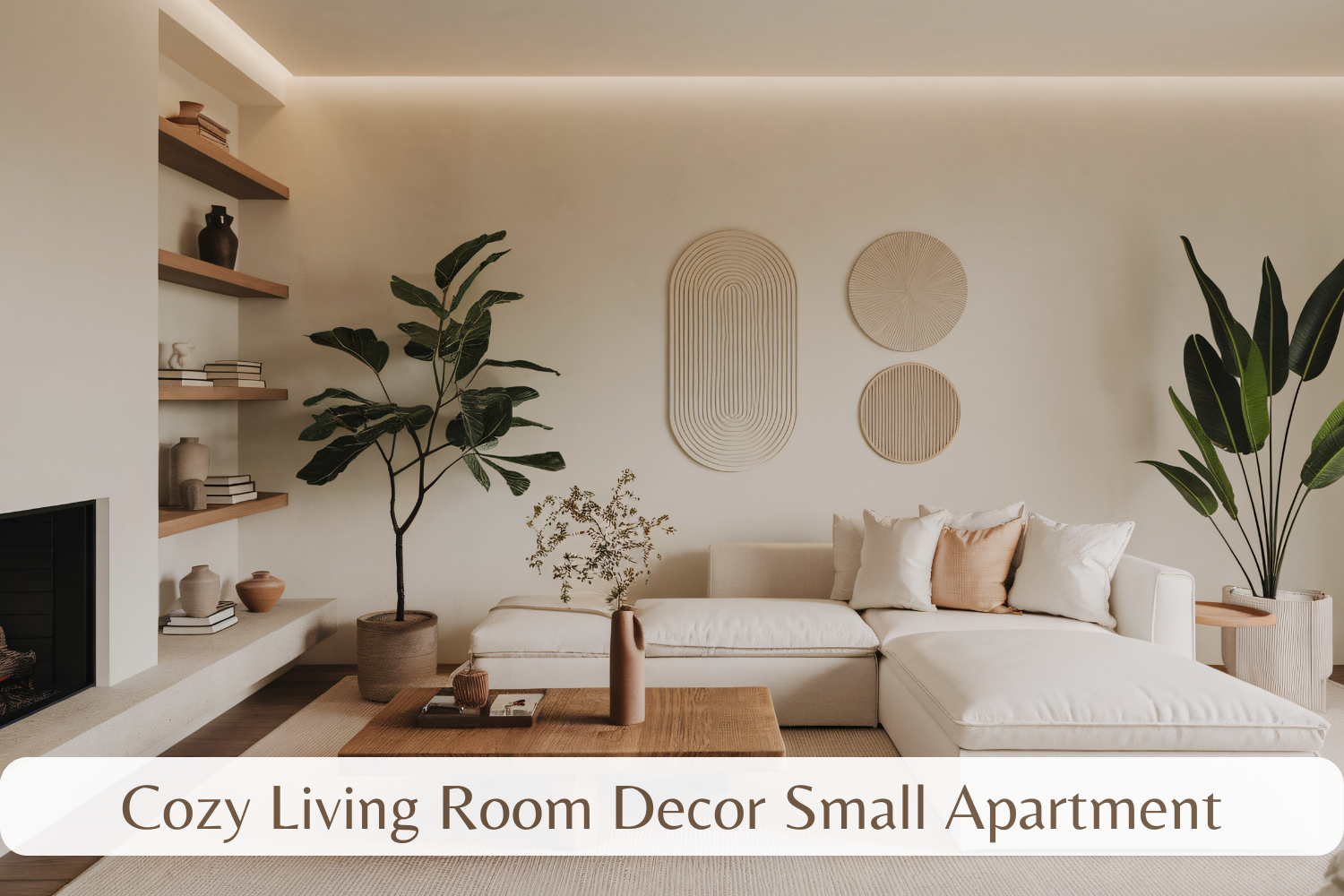
Furniture that Fits Your Footprint
When it comes to cozy living room decor for a small apartment, choosing the right furniture is absolutely crucial. It’s easy to get carried away with a beautiful sofa or a comfy armchair, but if it’s too big for your space, it’s going to make your living room feel cramped and cluttered. Here’s how to choose furniture that will make your small living room feel bigger and more inviting:
-
Scale is Key: Before you even start looking at furniture, grab a measuring tape and get to work! Seriously, measuring your living room is the first and most important step in creating cozy living room decor for a small apartment. This will help you determine the maximum size of furniture you can comfortably fit without overwhelming the space. Think apartment-sized sofas, loveseats instead of large sectionals, and slimline chairs. For example, a standard sofa might be 84 inches long, but a loveseat is typically around 60 inches, saving you valuable floor space. Choosing appropriately scaled furniture is the foundation for successful cozy living room decor in a small space.
-
Multi-Functional Marvels: In a small apartment, every piece of furniture needs to pull its weight. Look for pieces that serve double duty, like a sofa bed with built-in storage underneath for bedding. This is a game-changer for overnight guests! An ottoman with a hidden compartment for blankets and pillows is another great way to sneak in extra storage without sacrificing style. A coffee table that lifts to become a dining table is another fantastic option for maximizing functionality in a small apartment living room, especially if you don’t have a separate dining area. Think creatively about how each piece can serve multiple purposes.
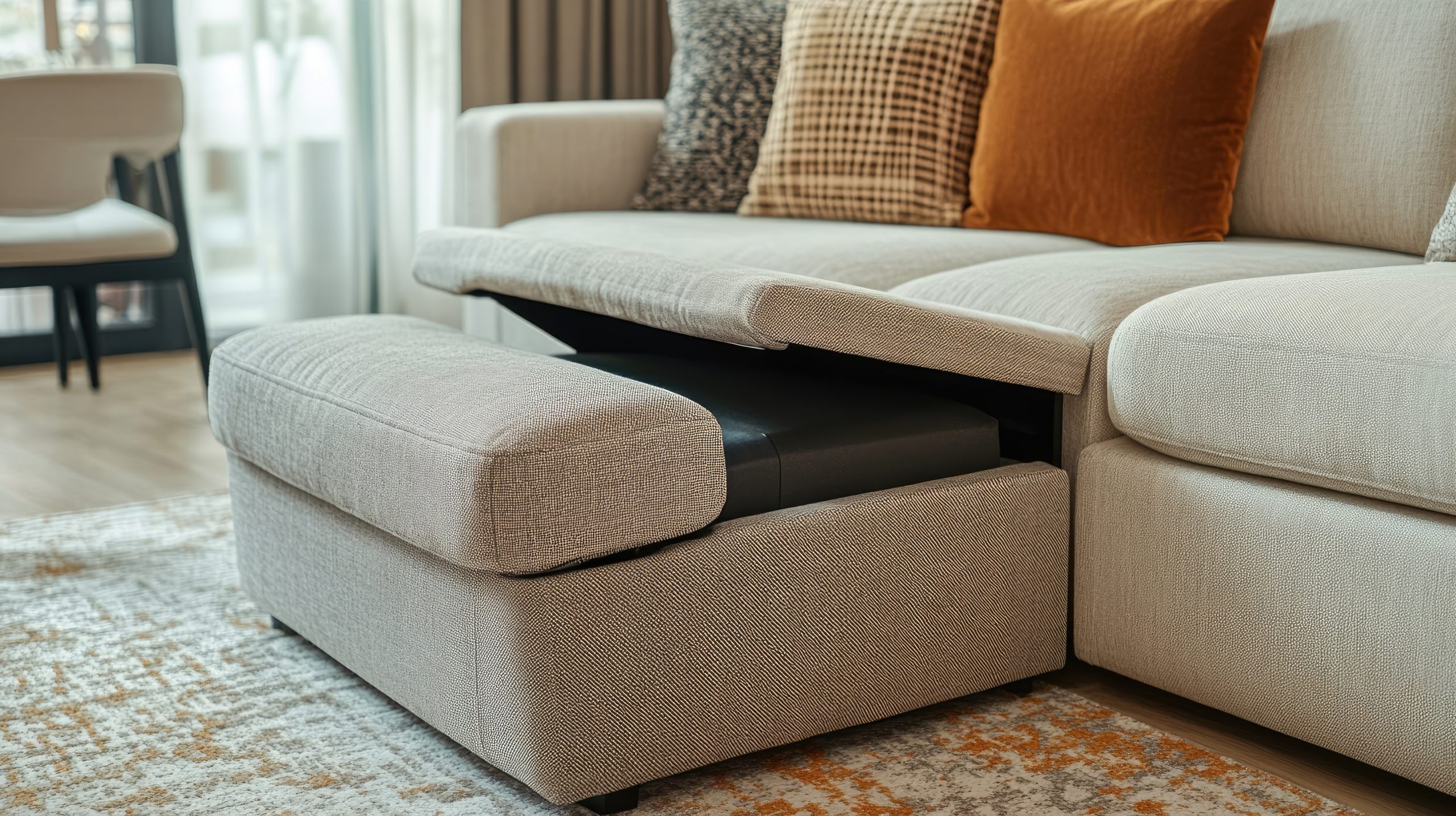
-
Measure Twice, Buy Once: I can’t stress this enough – measure your space before you buy any furniture! It’s so much easier to measure than to try and squeeze a too-large sofa through your apartment door, trust me! Creating a simple floor plan sketch can also be incredibly helpful when planning your living room decor. You can even use online tools or apps to create a virtual floor plan and experiment with different furniture arrangements.
-
Leggy Looks: Furniture with legs creates a sense of airiness and visual space, which is essential in a small living room. The light can flow underneath the furniture, making the room feel less cluttered and more open. When you’re aiming for cozy living room perfection, consider opting for sofas, armchairs, and coffee tables with raised legs. Even a small elevation can make a big difference in how spacious your living room feels. Think sleek, tapered legs for a modern look, or ornately carved legs for a more traditional feel.
- Vertical Space is Your Best Friend: Don’t forget to look up! In a small living room, vertical space is prime real estate. Tall, narrow bookshelves or wall-mounted units are a great way to add storage and display decorative items without taking up valuable floor space. Styling these shelves with a mix of books, plants, and personal items can really elevate your living room decor. Consider using wall-mounted shelves to display artwork or create a mini indoor herb garden – it’s a great way to add personality and functionality to your space.
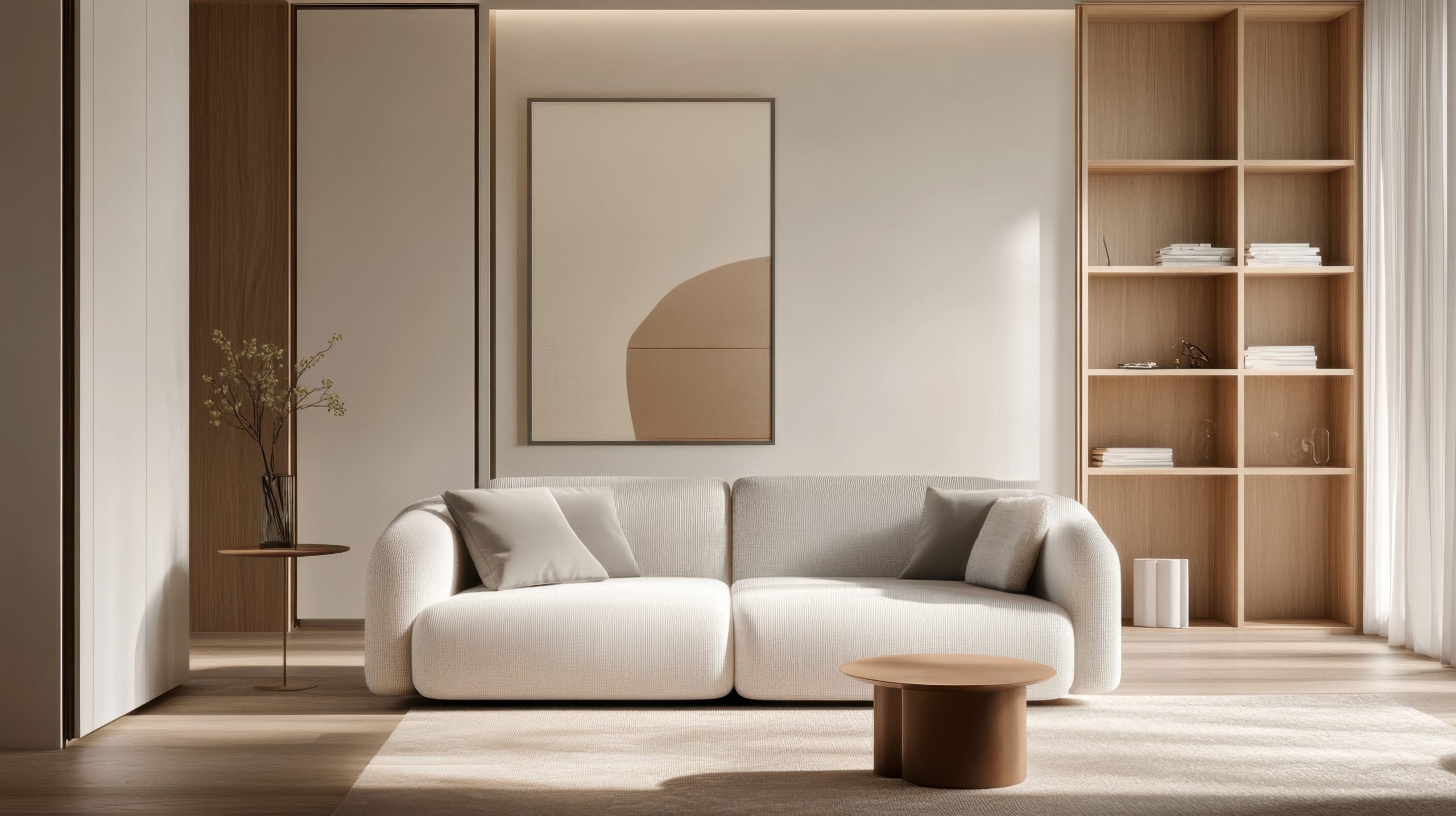
-
Clear the Clutter: Less is definitely more in a small space. Be mindful of how much furniture you bring into your living room. Avoid overcrowding the space, and focus on a few key pieces that are both functional and stylish. A minimalist approach can work wonders for creating a cozy living room in a small apartment. Regularly decluttering and getting rid of items you no longer need or use will help keep your living room feeling open and inviting. Consider incorporating stylish storage solutions, like baskets and decorative boxes, to keep clutter at bay. A clutter-free space is key to achieving a truly cozy and relaxing atmosphere.
Creating a Cozy Atmosphere with Textiles
Textiles are the secret weapon for creating a truly cozy living room, especially in a small apartment. They add warmth, texture, and personality, transforming a plain space into a welcoming haven. When considering cozy living room decor, small apartment style, think beyond just functionality – textiles offer a powerful way to enhance the ambiance and express your personal style.
-
Texture is King: In a small living room, texture is paramount. It adds depth and dimension, fooling the eye and making the space feel larger and more inviting. Think beyond smooth surfaces and incorporate a variety of tactile elements. A chunky knit throw draped over the arm of your sofa instantly adds a sense of warmth and comfort. Plush velvet cushions invite you to sink in and relax. A soft, shaggy rug underfoot creates a luxurious and inviting feel. Don’t be afraid to mix and match different textures – a nubby wool throw paired with a smooth velvet cushion creates a dynamic and interesting look. Consider the seasons too – lighter, breathable linens for summer and heavier wools and faux furs for winter can enhance the cozy factor.
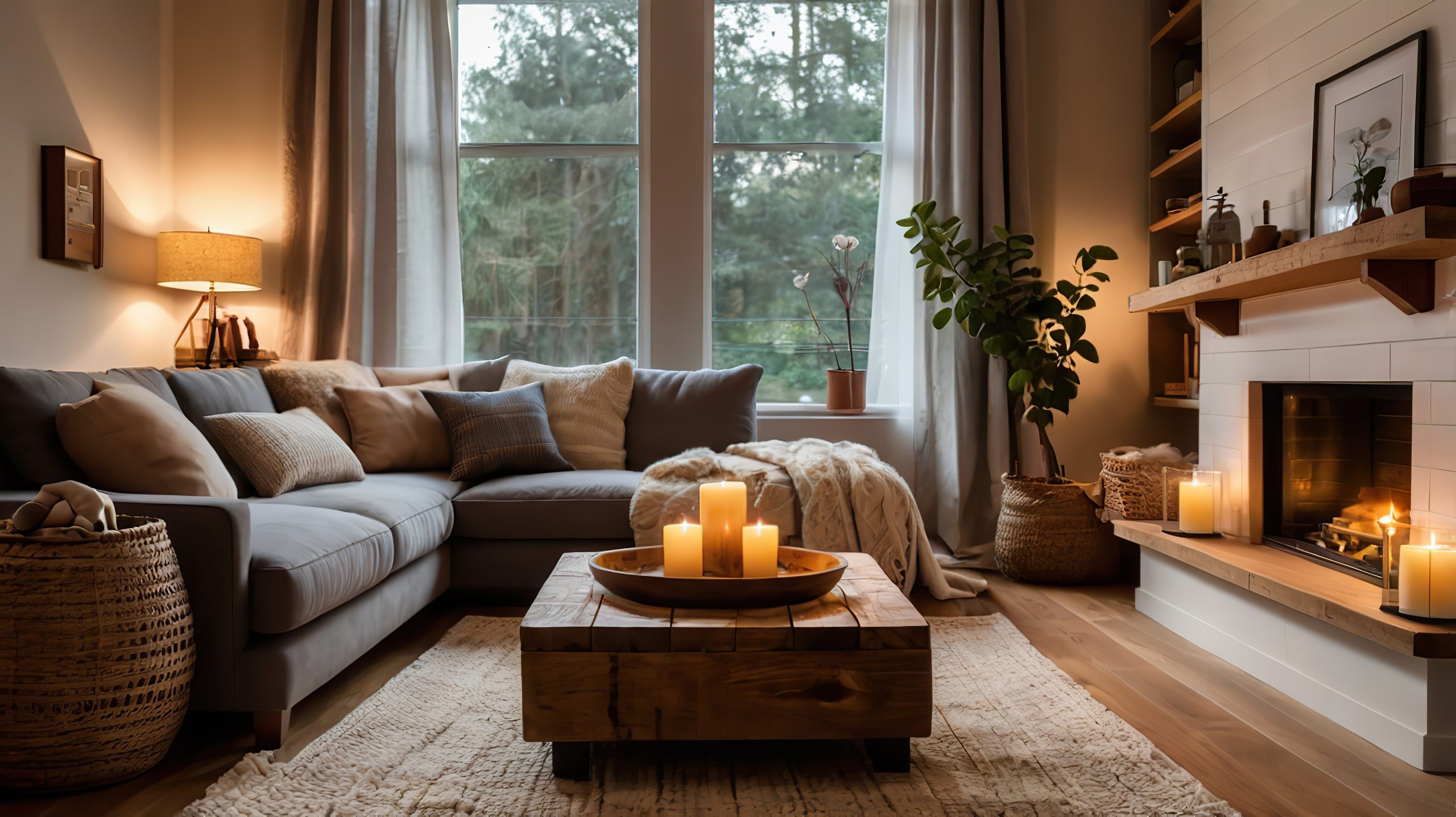
-
Natural Beauty: Natural materials like wool, cotton, and linen are not only soft and comfortable against the skin, but they also offer inherent breathability, which is crucial in a small apartment. These materials also bring a touch of organic elegance to your living room decor. A chunky hand-knit wool throw draped over the back of your sofa adds a touch of rustic charm, while a crisp linen cushion introduces a sense of understated sophistication. Look for natural fiber rugs like jute or sisal to add texture and warmth underfoot.
-
Color Psychology: Color has a profound impact on mood and atmosphere. For a cozy living room decor in a small apartment, lean towards warm, inviting colors that create a sense of intimacy and comfort. Soft neutrals like cream, beige, and gray provide a calming backdrop, while earthy tones like terracotta, olive green, and warm brown evoke a sense of groundedness and tranquility. Rich jewel tones like emerald green, sapphire blue, or ruby red can add a touch of opulence and warmth without overwhelming the space. Consider using a color palette of two or three complementary colors to create a cohesive and harmonious look.
-
Layering for Depth: Layering textiles is a designer’s trick for adding visual interest and depth to a small living room. Start with a base layer, like a rug, and then build upon it with throws, cushions, and even curtains. Don’t be afraid to mix and match different patterns and textures – a geometric patterned rug paired with a solid-colored throw and a textured cushion creates a dynamic and inviting look. Layering also allows you to easily change the look and feel of your living room by swapping out different textiles with the seasons or your changing tastes.
-
Rugs Define the Space: In a small apartment, a rug is essential for visually defining the living area and adding warmth underfoot. Choose a rug that is large enough to anchor the main furniture pieces, such as the sofa and armchairs, but not so large that it overwhelms the room. Ideally, the front legs of your furniture should rest on the rug, creating a sense of connection and cohesion. A rug can also introduce a pop of color or pattern to your cozy small living room decor, tying the space together and adding personality.
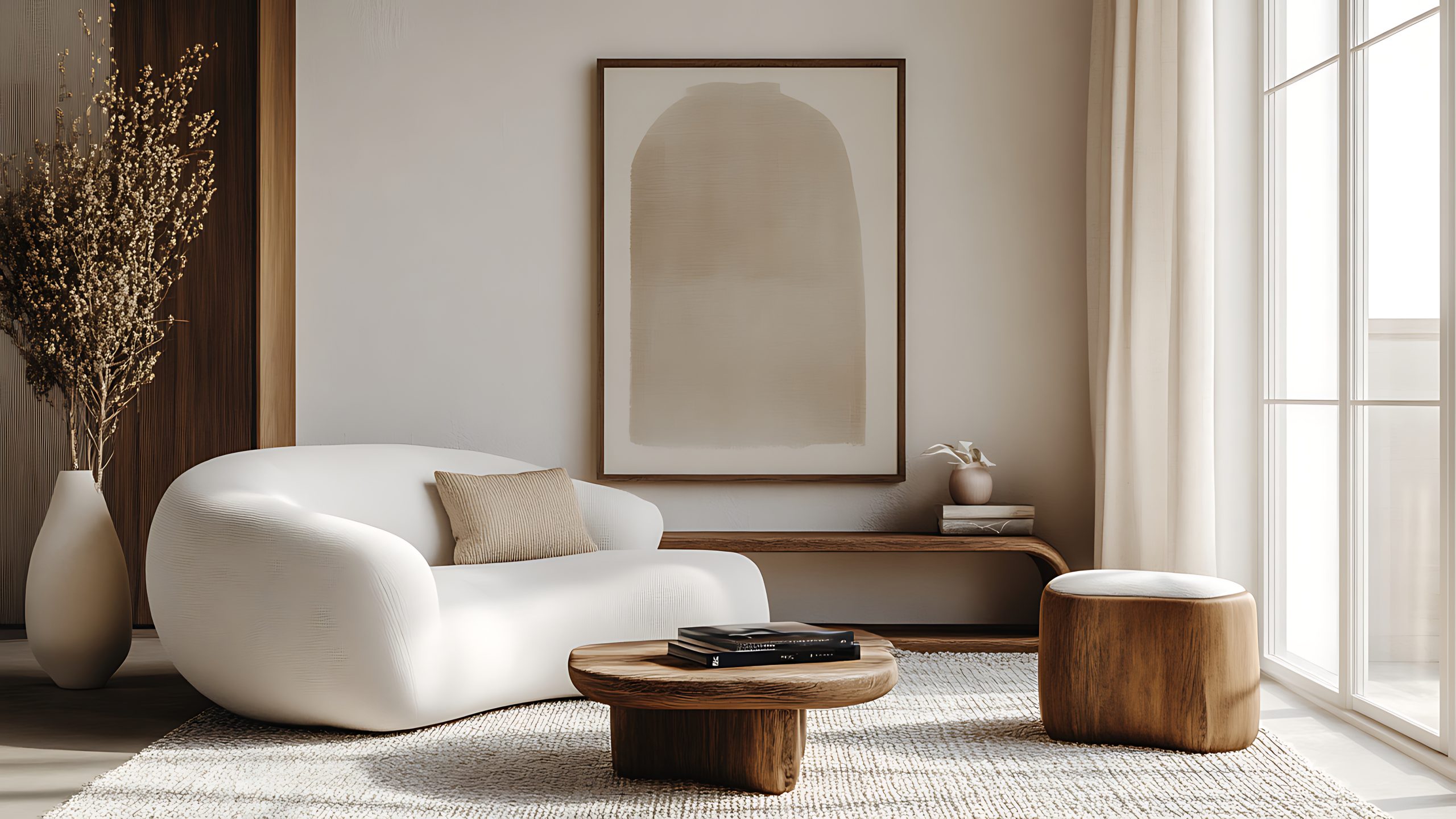
Lighting Up Your Small Space
Lighting is a critical element in any cozy living room decor for a small apartment. It sets the mood, enhances functionality, and can even make the space feel larger. Here’s how to light up your small living room for maximum coziness:
-
Natural Light is Your Friend: Natural light is a precious commodity in a small apartment. Maximize it by keeping window treatments light and airy. Sheer curtains or blinds allow natural light to filter through while still providing privacy. Avoid heavy drapes or blinds that block light and make the space feel smaller. Consider using mirrors strategically to reflect natural light deeper into the room.
-
Layered Lighting Magic: Creating a warm and inviting atmosphere relies on layered lighting. Combine ambient lighting (general overhead lighting), task lighting (for reading or working), and accent lighting (to highlight specific features) for a well-lit and functional space. A floor lamp next to your reading chair provides focused light for reading, while a table lamp on a side table creates a soft, ambient glow. Pendant lights over the coffee table add a touch of style and provide focused light for conversations or games. Dimmer switches allow you to adjust the brightness of your lighting to suit different moods and activities.
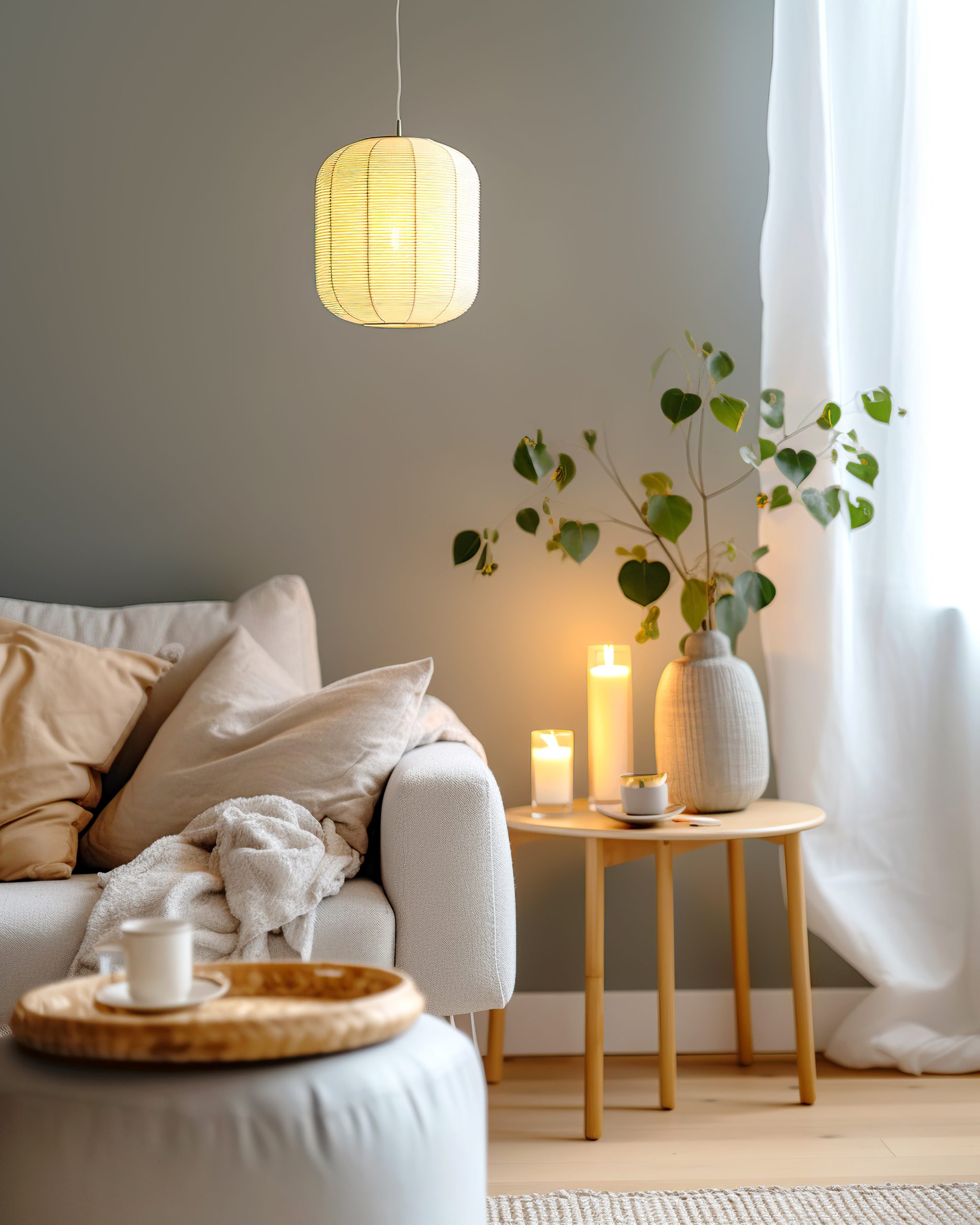
-
Light and Bright Color Schemes: Light and bright wall colors can significantly impact how spacious your small living room feels. Opt for shades of white, cream, or light gray to create a neutral backdrop that reflects light and makes the space feel open and airy. You can then add pops of color with your textiles and accessories. A light and airy color scheme is essential for successful cozy living room decor in a small apartment.
-
Statement Lighting Fixtures: A statement light fixture can be the jewelry of your living room, adding personality and style without taking up valuable floor space. Choose a fixture that complements your overall decor and provides adequate lighting for the space. A unique pendant light over the coffee table or a stylish chandelier can become a focal point and elevate the entire room. Consider the scale of the fixture – a large, oversized fixture can overwhelm a small space, while a smaller, more delicate fixture can add a touch of elegance without feeling overpowering.
- Mirror, Mirror on the Wall: Mirrors are a small space decorator’s best friend. They reflect light, creating the illusion of more space and making your living room feel larger and brighter. A large statement mirror above the sofa can visually double the size of the room, while a gallery wall of smaller mirrors adds a touch of eclectic style and reflects light from multiple angles. Consider placing a mirror opposite a window to maximize natural light reflection.
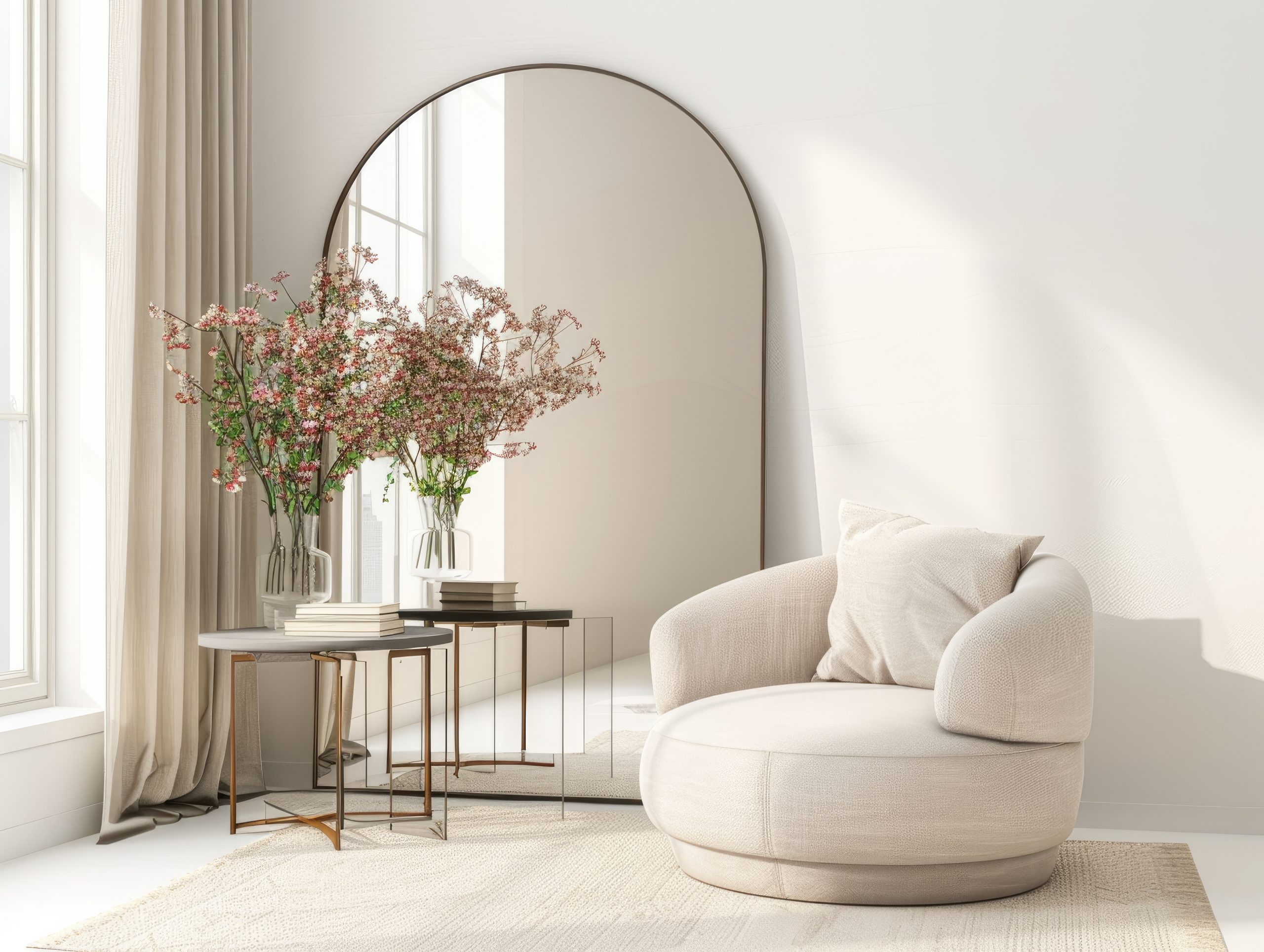
Decorative Touches for a Stylish Space
Decorative touches are what truly personalize your space and make it feel like home. In a small apartment, it’s important to be selective and intentional with your decor choices to avoid cluttering the space. Here’s how to add style and personality to your cozy living room decor:
-
Curated Collections: Resist the urge to fill every surface with decorative objects. Instead, choose a few carefully curated pieces that you truly love and that reflect your personal style. This could include a collection of vintage books, a grouping of framed family photos, a few treasured travel souvenirs, or a small display of handcrafted pottery. Grouping similar items together creates a more impactful visual statement than scattering individual items around the room. Consider using trays or decorative bowls to display smaller items and keep surfaces looking organized.
-
Focal Point Focus: Every living room needs a focal point – a visual anchor that draws the eye and gives the space a sense of purpose. In a small living room, the focal point can be a fireplace, a piece of statement art, a gallery wall, a large window with a beautiful view, or even a striking piece of furniture. Once you’ve identified your focal point, arrange your furniture and decor to highlight it. For example, if your focal point is a fireplace, arrange your seating area to face it.
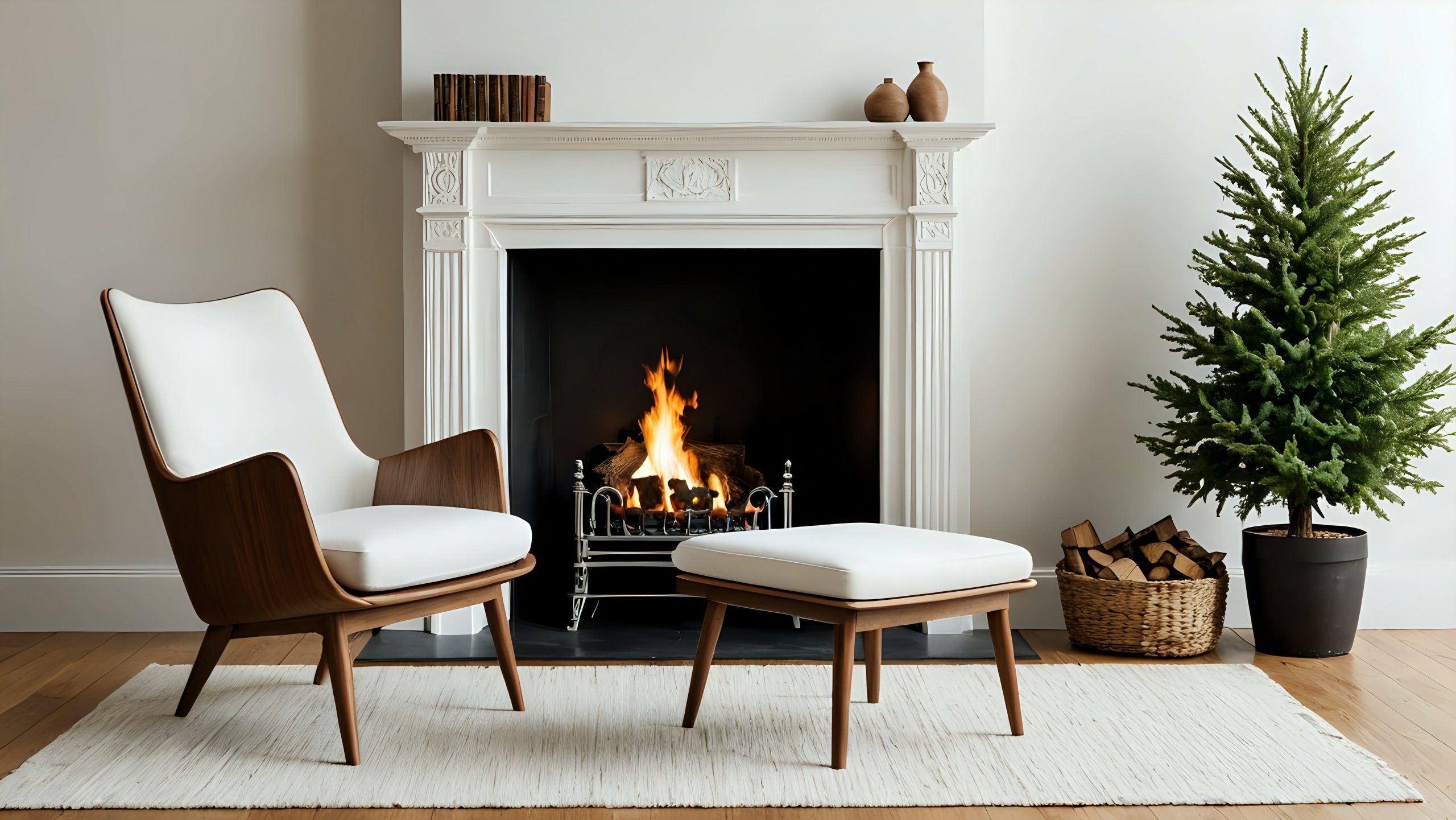
-
Decluttering is Key: Clutter is the enemy of coziness, especially in a small apartment. Regularly declutter your living room, getting rid of anything you no longer need, use, or love. A clutter-free space feels more open, airy, and inviting. Invest in stylish storage solutions, such as baskets, decorative boxes, and ottomans with hidden storage, to keep clutter contained and out of sight. Make decluttering a regular habit to maintain a sense of calm and order in your living room.
-
Greenery Brings Life: Plants add a touch of life and vibrancy to any space, and they’re especially beneficial in a small living room. They can help to purify the air, improve indoor air quality, and create a more calming and inviting atmosphere. Choose low-maintenance plants that thrive in indoor environments, such as snake plants, pothos, or spider plants. Place plants strategically around the room to add pops of color and texture. A tall, leafy plant in a corner can visually expand the space, while a small succulent on a coffee table adds a touch of natural beauty.
-
Personal Touches: The most important decorative touches are the ones that reflect your personality and make your space feel like home. Don’t be afraid to display items that have special meaning to you, whether it’s a collection of vintage postcards, a framed concert ticket, or a handmade quilt from your grandmother. These personal touches are what truly make your space unique and special.
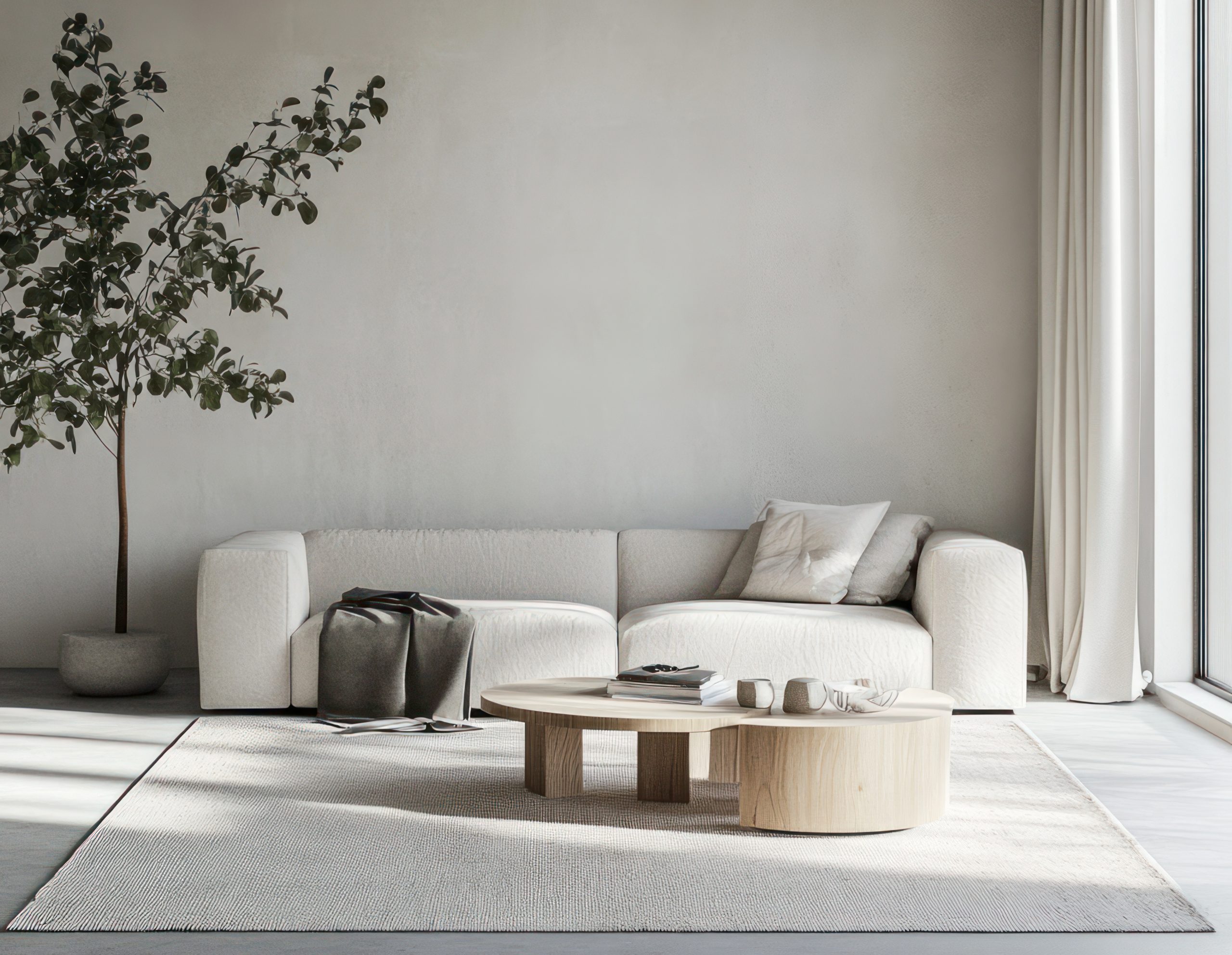
Making the Most of Vertical Space
In a small apartment, maximizing vertical space is essential for creating a functional and stylish living room. Think upwards and utilize every inch of wall space to your advantage. Here’s how to make the most of your vertical real estate:
-
Think Vertical: Train your eye to look up! Before adding furniture or decor, consider how you can utilize the vertical space in your living room. This might involve installing shelves, hanging artwork, or using tall furniture to draw the eye upwards and create the illusion of height.
-
Floating Shelves: Floating shelves are a versatile and stylish way to add storage and display decorative items without taking up valuable floor space. Install them above the sofa, next to the TV, or in any other awkward corner. Use floating shelves to display books, plants, framed photos, or small decorative objects. Arrange items in a visually appealing way, leaving some negative space to avoid a cluttered look.
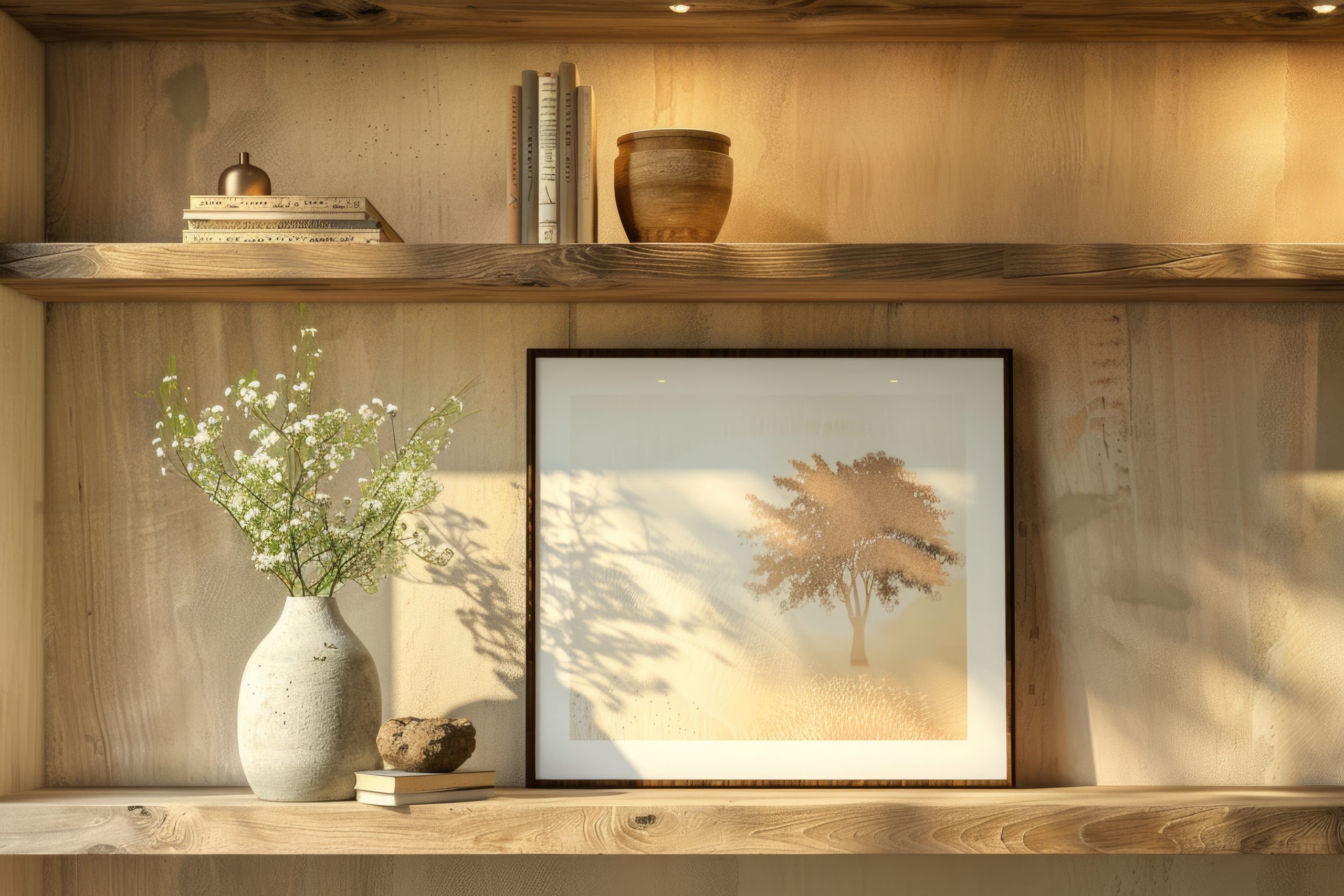
-
Bookcase Bliss: Tall, narrow bookcases are a classic way to maximize storage and display books, decorative objects, and even small plants. They can also add a touch of elegance and sophistication to your living room. Choose a bookcase that complements your existing furniture and decor. Arrange books and objects in a visually appealing way, mixing horizontal and vertical stacks to create visual interest.
-
Wall-Mounted Magic: Explore other wall-mounted options beyond shelves and bookcases. Hanging planters can add a touch of greenery without taking up floor space. Wall-mounted sconces provide ambient lighting and free up valuable surface area on tables and shelves. Hanging artwork or a large mirror can create a focal point and add personality to your space. Consider mounting your TV on the wall to also free up space on a media console.
-
Vertical Stripes: Incorporating vertical stripes, whether in wallpaper, rugs, or curtains, can visually elongate the room and make your ceilings appear higher. This is a subtle but effective trick for maximizing visual space in a small living room. Choose a stripe pattern that complements your existing decor and doesn’t overwhelm the space. Vertical stripes can add a touch of classic elegance or a more modern, graphic feel, depending on the color and width of the stripes.
By following these tips and focusing on maximizing space, incorporating cozy textiles, layering lighting, adding personal touches, and utilizing vertical space, you can transform your small apartment living room into a stylish and inviting sanctuary. Remember, cozy living room decor for a small apartment is all about creating a space that feels comfortable, personal, and perfectly suited to your needs and aesthetic.
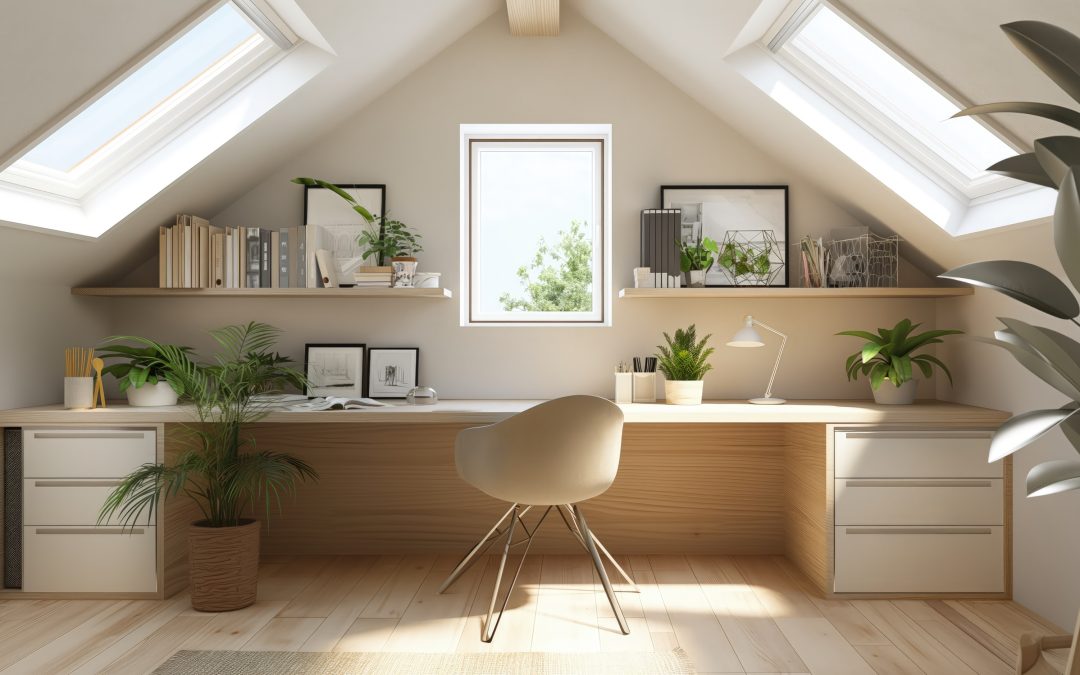
by Kesaa Interiors | DECOR & DIY, DESIGN GUIDES, DIY Projects, Furniture & Layout Guides, Home Office, ROOMS
Want to know how to create the perfect ergonomic home office? You have come to the right place!
With more and more of us embracing the work-from-home lifestyle, the need for a dedicated and productive workspace has never been greater. But simply having a desk and chair isn’t enough. To truly thrive while working remotely, you need an ergonomic home office – a space designed to support your physical well-being and boost your productivity.
This post will guide you through creating an ergonomic home office that not only feels fantastic but looks stunning too. We’ll cover everything from choosing the right furniture to incorporating stylish décor, ensuring your workspace is a haven of both comfort and inspiration.
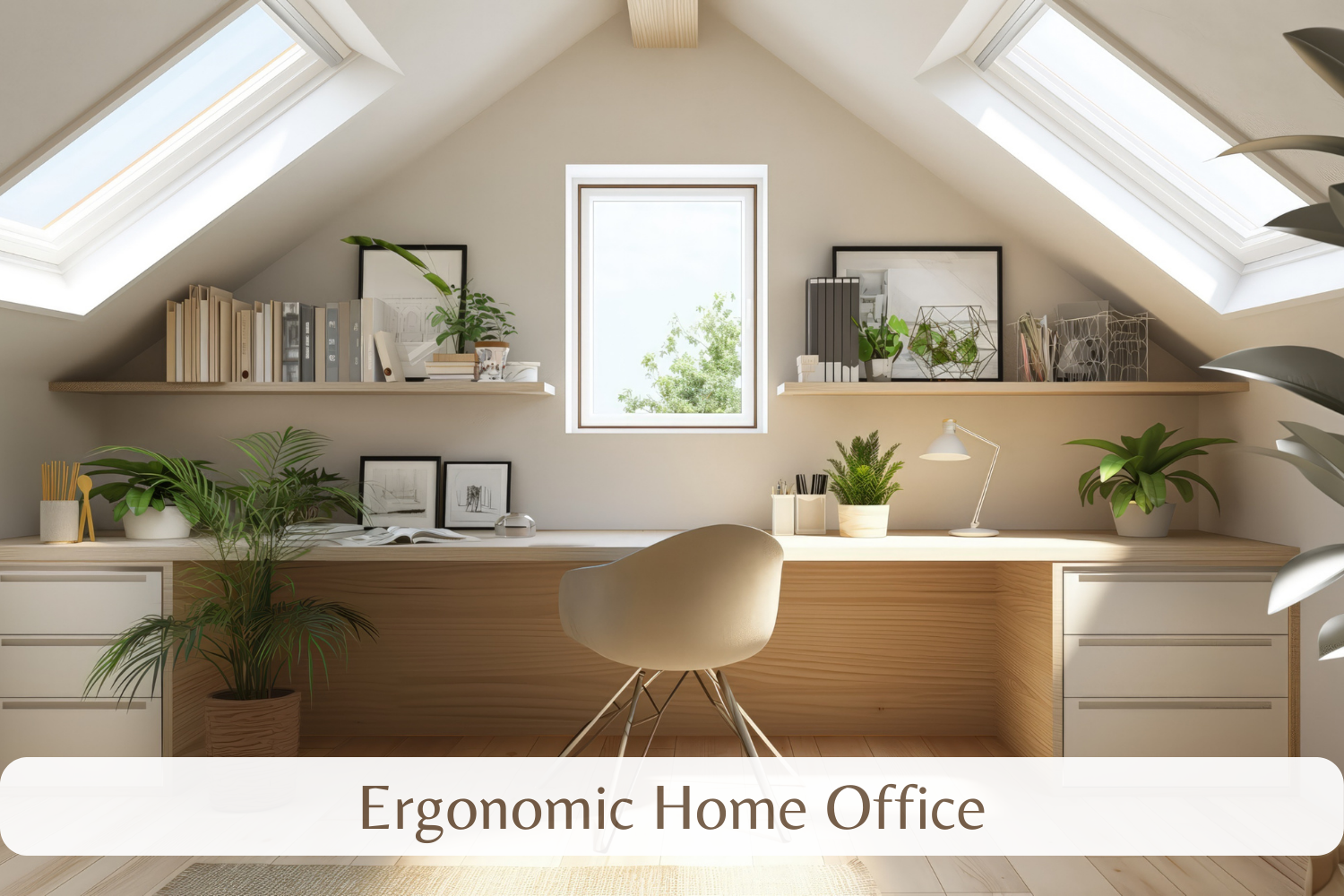
Best Ergonomic Home Office Tips!
Location, Location, Location: Choosing the Right Spot for Your Ergonomic Home Office
Creating the perfect ergonomic home office starts with selecting the right location. Where you choose to set up shop can significantly impact your focus, comfort, and overall productivity. Consider these key factors when deciding on the optimal spot for your ergonomic home office:
- Natural Light: Positioning your ergonomic home office near a window allows you to harness the power of natural light. Natural light not only reduces eye strain but also boosts mood and energy levels, contributing to a more positive and productive work experience.
- Noise Levels: Minimize distractions by choosing a location that’s relatively quiet. If your home is bustling with activity, consider a room away from high-traffic areas or invest in noise-cancelling headphones to maintain focus in your ergonomic home office.
- Privacy: A dedicated workspace free from interruptions is crucial for concentration. If possible, select a room with a door that can be closed to create a private and productive ergonomic home office environment. Even a strategically placed room divider can help establish a sense of separation and minimize distractions.
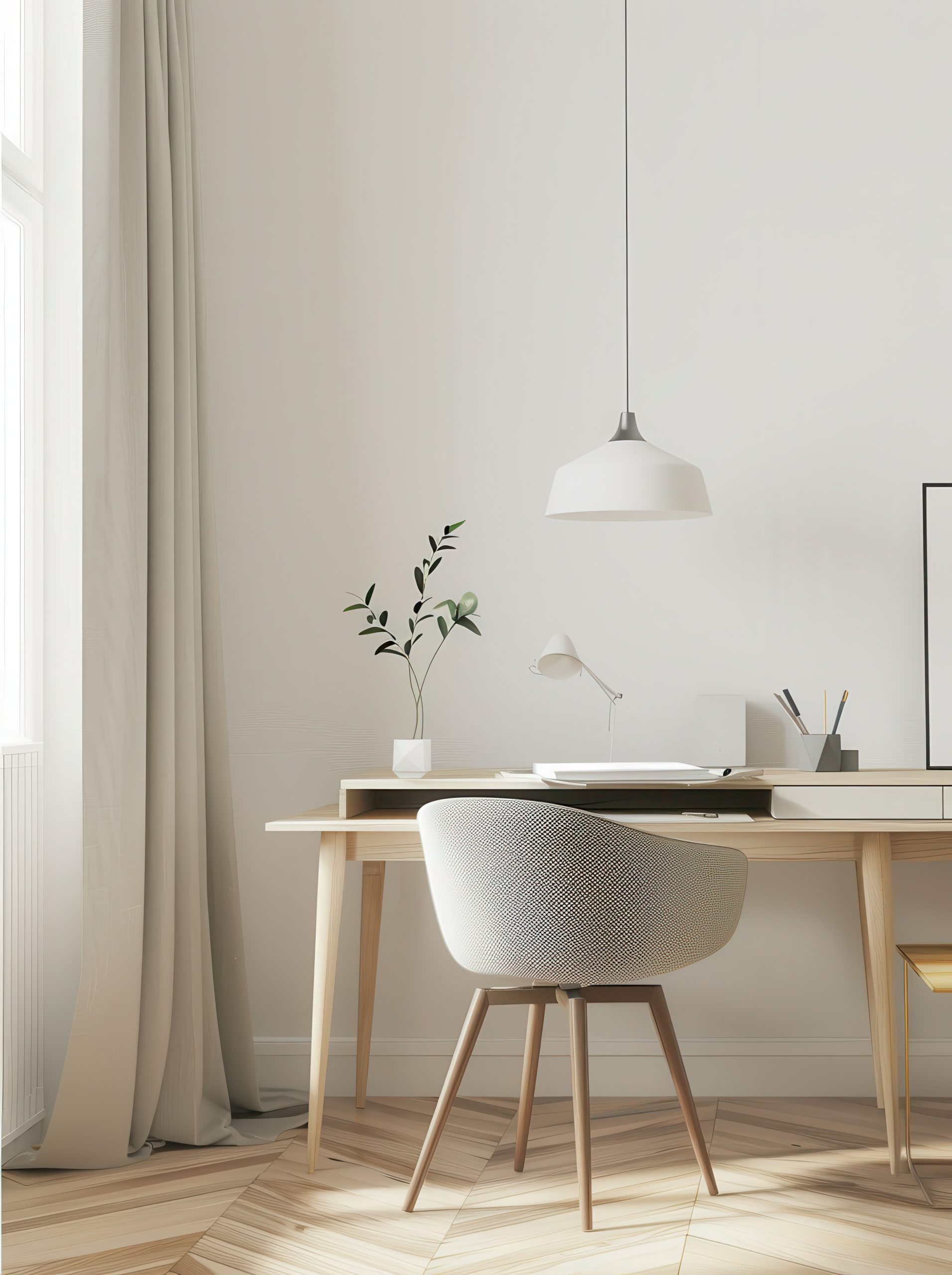
Space Planning: Maximizing Your Home Office Footprint for an Ergonomic Setup
Once you’ve chosen the perfect location for your ergonomic home office, it’s time to optimize the space itself. Careful planning is essential for creating a functional and comfortable work environment. Here’s how to maximize your home office footprint:
- Measure and Map: Before purchasing any furniture, meticulously measure your available space. This will help you determine the appropriate size and scale of furniture pieces, ensuring a comfortable fit and avoiding a cramped or cluttered ergonomic home office. Sketching a floor plan can be invaluable in visualizing the layout and optimizing traffic flow.
- Designated Zones: Consider dividing your ergonomic home office into distinct zones for different activities. For example, you might have a primary work zone centered around your desk, a secondary zone for reading or brainstorming, and a storage zone for files and supplies. This helps maintain organization and promotes efficient workflow.
- Traffic Flow: Ensure there’s ample space to move around comfortably within your ergonomic home office. Avoid placing furniture in a way that obstructs pathways or creates tight squeezes. Easy movement contributes to a more comfortable and less stressful work environment.
- Future Growth: While planning your ergonomic home office layout, anticipate future needs. Consider whether you might need to accommodate additional equipment, storage, or even another workspace down the line. Planning for potential expansion can save you headaches and remodeling efforts in the future.

The Ergonomic Chair: Your Throne of Productivity in Your Ergonomic Home Office
Investing in a high-quality ergonomic chair is arguably the most crucial step in creating a truly ergonomic home office. You’ll be spending a significant amount of time seated, so a chair that supports your body and promotes good posture is essential for your long-term health and well-being. Look for these key features when choosing your new chair:
- Adjustable Height: The ability to adjust the seat height is paramount. Your feet should rest flat on the floor with your knees bent at a 90-degree angle. An adjustable height ensures proper posture and reduces strain on your legs and back.
- Lumbar Support: Adequate lumbar support is crucial for maintaining the natural curve of your spine. Look for a chair with adjustable lumbar support that can be customized to fit your individual needs. This helps prevent back pain and promotes a healthy posture while working in your home office.
- Armrests: Adjustable armrests are another important feature. They should allow your arms to rest comfortably at your sides with your elbows bent at a 90-degree angle. This reduces strain on your shoulders and neck.
- Seat Depth and Width: The seat should be deep enough to support most of your thighs while leaving a small gap behind your knees. The width should allow you to sit comfortably without feeling restricted.
- Material and Breathability: Choose a chair with breathable fabric to prevent overheating and discomfort during long work sessions. Consider materials like mesh or high-quality fabric upholstery.
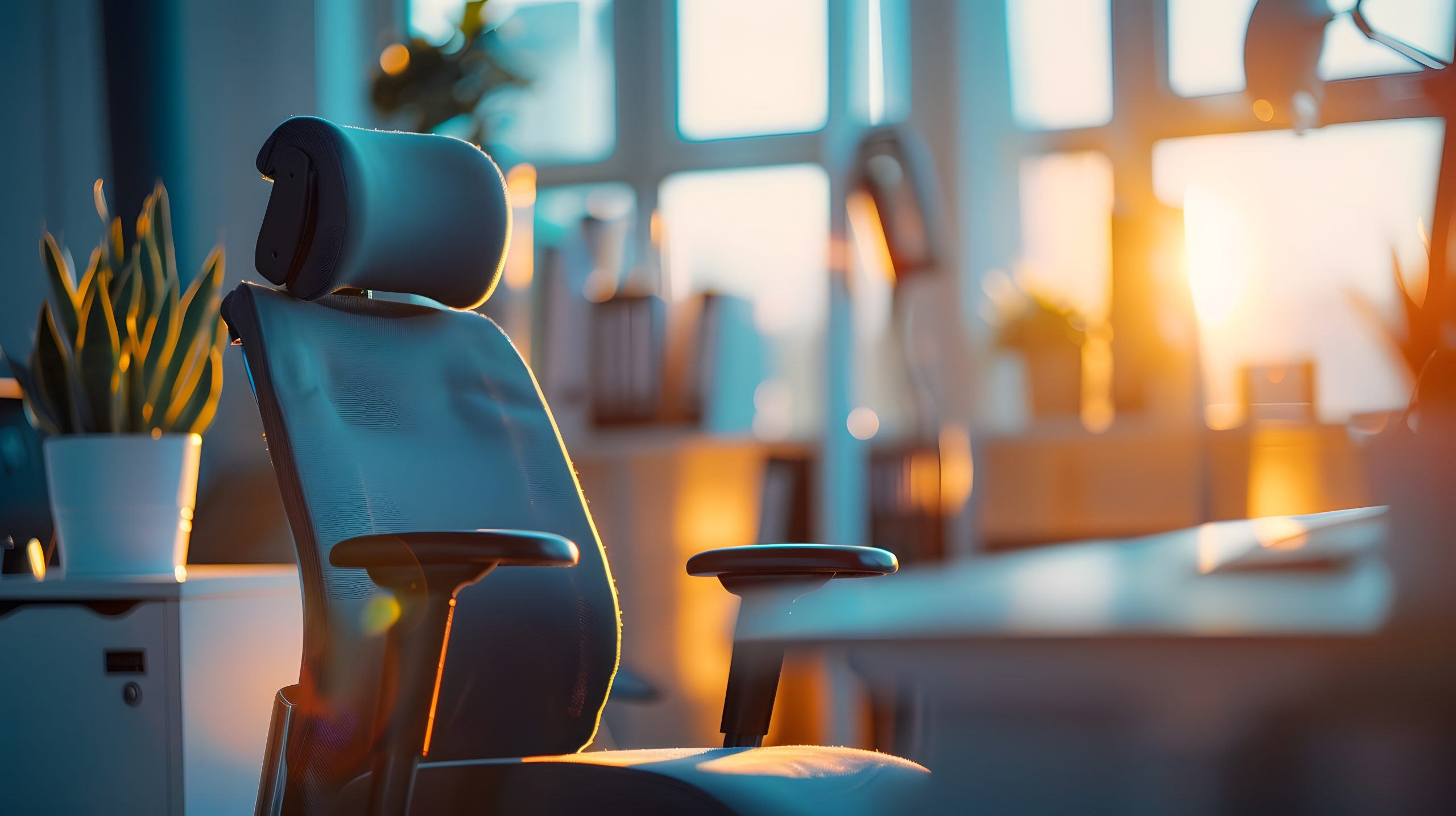
Desk Duty: Selecting the Perfect Desk for Your Ergonomic Home Office
The right desk is just as important as the right chair in your ergonomic home office setup. It provides the foundation for your workspace and significantly impacts your comfort and productivity. Here’s a breakdown of different desk types and how to choose the perfect one for your needs:
- Standing Desks: Standing desks have gained immense popularity for their health benefits. They allow you to alternate between sitting and standing, promoting better circulation, reducing back pain, and boosting energy levels. If you opt for a standing desk, ensure it’s height-adjustable to accommodate both sitting and standing positions within your home office.
- Adjustable Height Desks (Sit-Stand Desks): These desks offer the best of both worlds, allowing you to seamlessly transition between sitting and standing throughout the day. They are a great investment for creating a truly flexible and ergonomic home office.
- Traditional Desks: If you prefer a traditional desk, ensure it’s the correct height for your stature. Your elbows should be at a 90-degree angle when typing, and your wrists should be straight. Consider using a keyboard tray to achieve the optimal ergonomic position in your ergonomic home office.
- Desk Size and Shape: Choose a desk size and shape that accommodates all your essential equipment and provides ample workspace. Consider an L-shaped desk for maximizing corner space or a U-shaped desk for a more expansive work area within your home office.
- Material and Style: Select a desk material and style that complements your overall home office décor. Options range from classic wood to modern glass and metal.
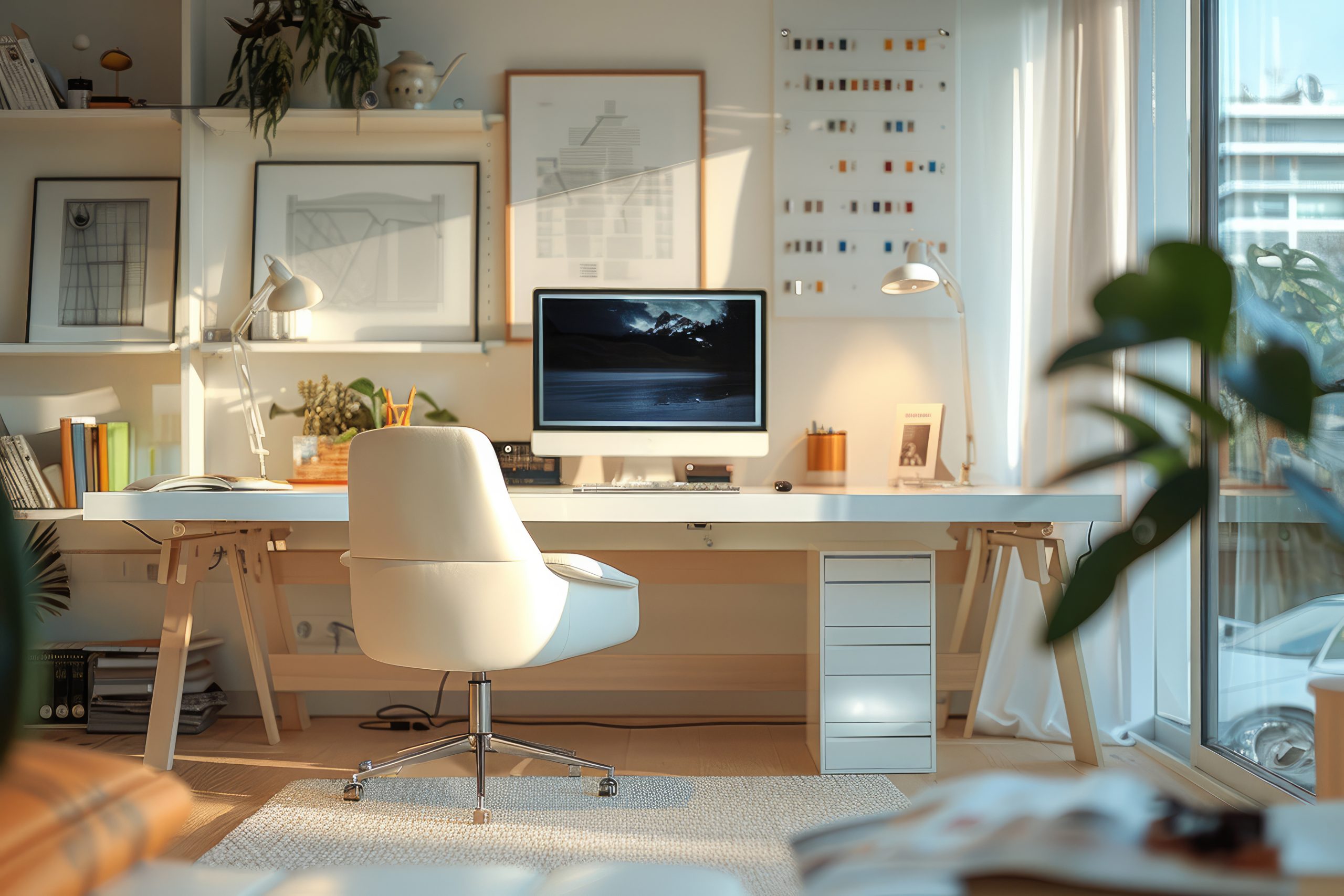
Storage Solutions: Taming the Clutter Monster in Your Ergonomic Home Office
A clutter-free workspace is essential for a productive and ergonomic home office. Disorganization can lead to distractions, stress, and wasted time. Implement these storage solutions to keep your home office tidy and efficient:
- Vertical Storage: Maximize vertical space with shelves, drawers, and filing cabinets. This keeps items off your desk surface, freeing up valuable workspace and contributing to a cleaner, more home office environment.
- Desk Organizers: Utilize desk organizers for pens, pencils, paperclips, and other small items. This keeps your desktop tidy and prevents clutter from accumulating.
- Cable Management System: Implement a cable management system to keep cords and wires organized and out of sight. This not only improves the aesthetics of your home office but also prevents tripping hazards.
- Hidden Storage: Utilize hidden storage solutions, such as ottomans with storage compartments or drawers under your desk, to maximize space and maintain a clean, minimalist look in your home office.
- Labeling: Labeling drawers, shelves, and boxes makes it easy to find what you need quickly, saving you time and reducing frustration in your home office.
- Regular Decluttering: Schedule regular decluttering sessions to purge unnecessary items and maintain an organized and efficient home office.
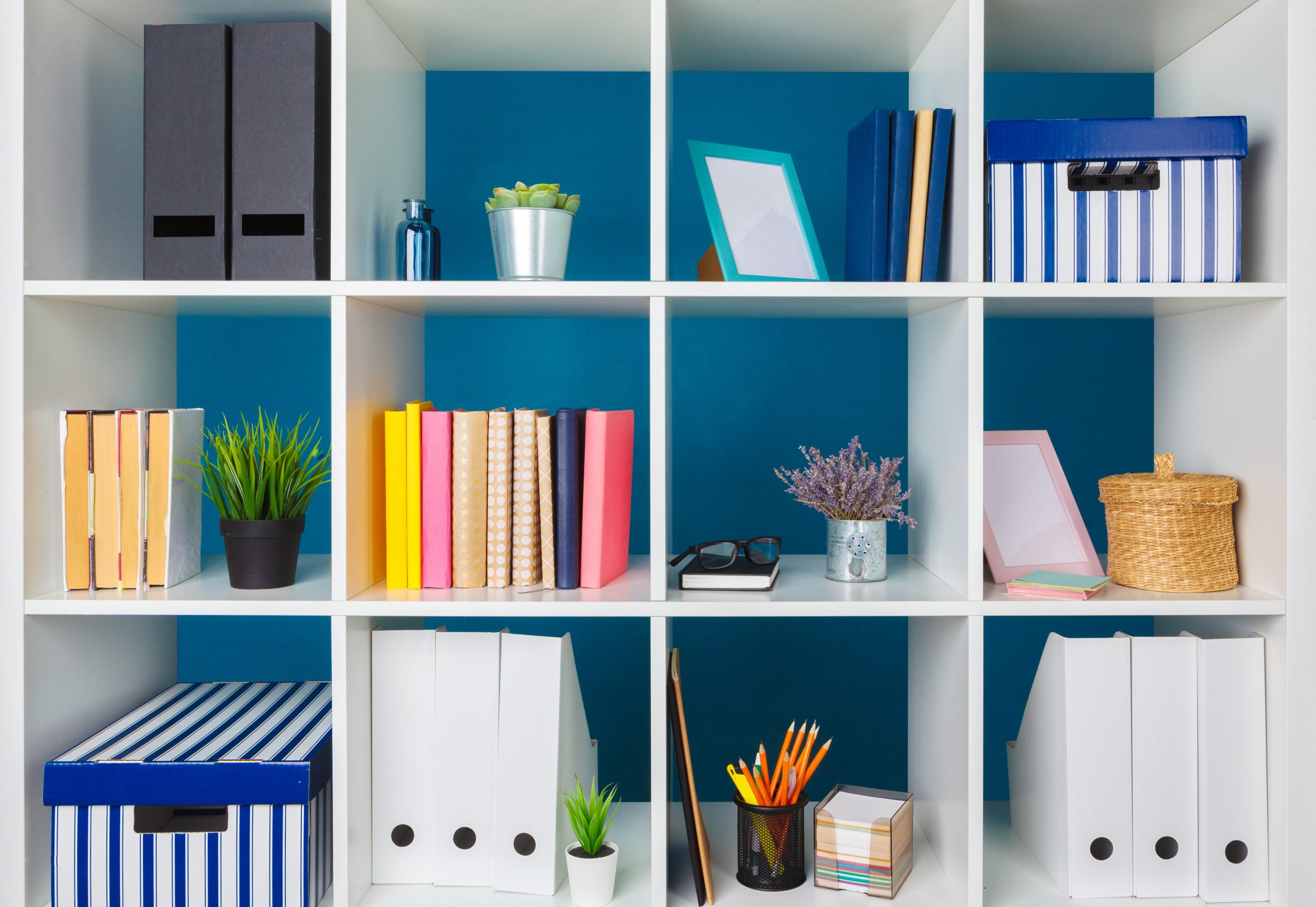
Monitor Placement: Protecting Your Precious Eyesight in Your Ergonomic Home Office
Correct monitor placement is crucial for preventing eye strain, neck pain, and headaches, all of which can significantly impact your productivity and well-being in your ergonomic home office. Follow these guidelines for optimal monitor placement:
- Arm’s Length Distance: Position your monitor an arm’s length away from your eyes. This reduces eye strain and allows for a comfortable viewing distance.
- Eye Level or Slightly Below: The top of your monitor should be at or slightly below eye level. This prevents you from craning your neck upwards, which can lead to discomfort and pain. Proper monitor placement is a cornerstone of a truly ergonomic home office.
- Center Your Monitor: Center your monitor directly in front of you to avoid twisting your neck or body. This promotes a neutral posture and reduces strain.
- Angle for Glare Reduction: Angle your monitor slightly upwards to minimize glare from overhead lights or windows. Glare can cause eye strain and make it difficult to focus, hindering your productivity.
- Multiple Monitors: If you use multiple monitors, arrange them in a slight curve around you to maintain a comfortable viewing angle for each screen in your setup.
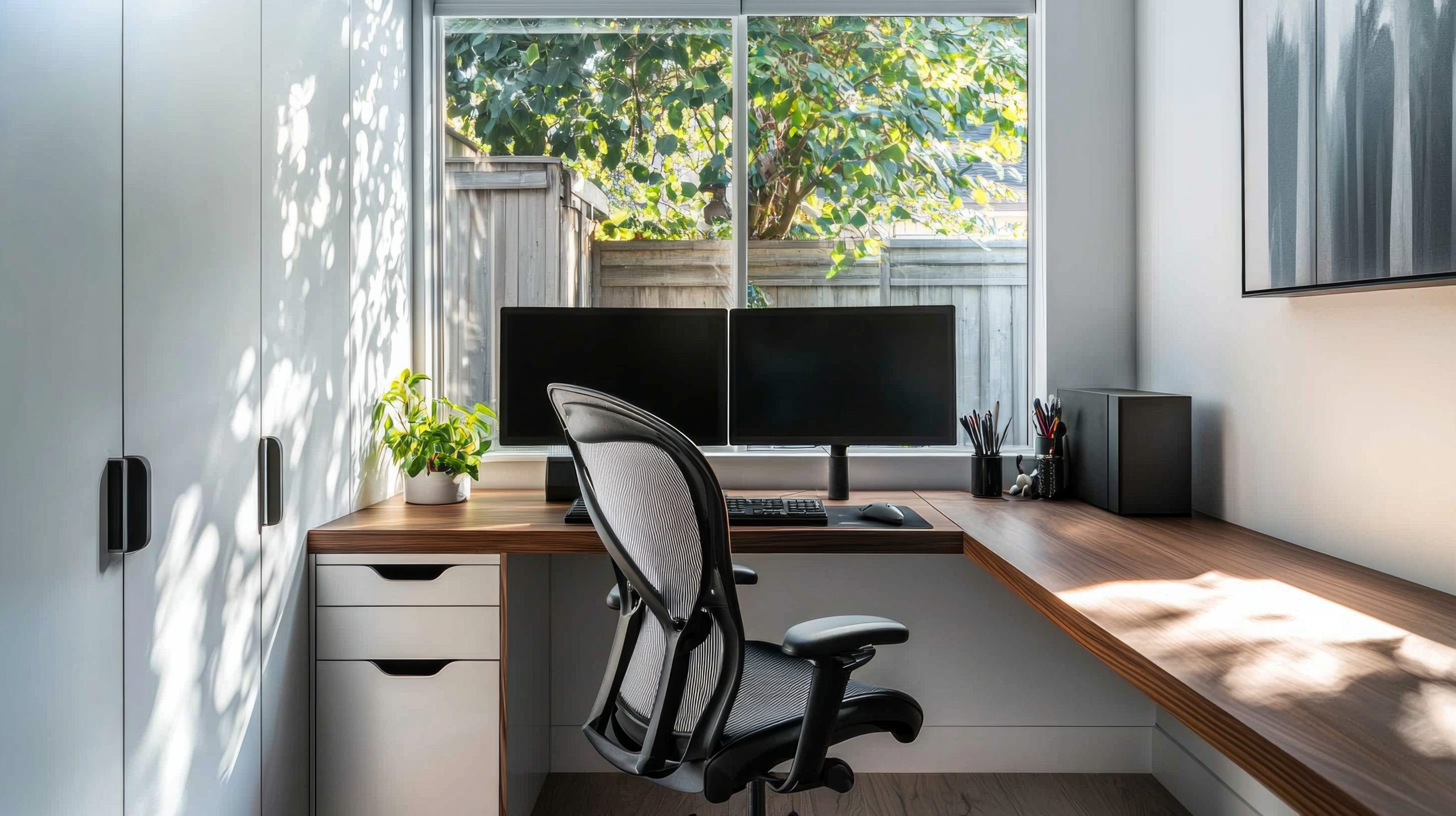
Keyboard and Mouse: Small Adjustments, Big Impact on Your Ergonomic Home Office
While seemingly minor, the positioning of your keyboard and mouse plays a significant role in your overall comfort and the ergonomics of your home office. Incorrect placement can lead to wrist pain, carpal tunnel syndrome, and other repetitive strain injuries. Follow these tips for optimal keyboard and mouse positioning:
- Keyboard Placement: Position your keyboard directly in front of you, ensuring your elbows are bent at a 90-degree angle and your wrists are straight. Avoid reaching or twisting to access your keyboard. This central placement is key for working efficiently.
- Mouse Placement: Place your mouse next to your keyboard, close enough to avoid reaching. Keep your wrist straight and avoid resting your wrist on hard surfaces.
- Ergonomic Keyboard and Mouse: Consider investing in an ergonomic keyboard and mouse. Ergonomic keyboards are designed to promote a more natural wrist position, while ergonomic mice reduce strain on your hand and wrist. These are valuable additions to any ergonomic home office.
- Mouse Pad with Wrist Support: A mouse pad with wrist support can provide additional cushioning and help maintain a neutral wrist position.
- Micro-breaks: Take frequent micro-breaks to stretch your hands and wrists. Even short breaks can help prevent stiffness and discomfort.
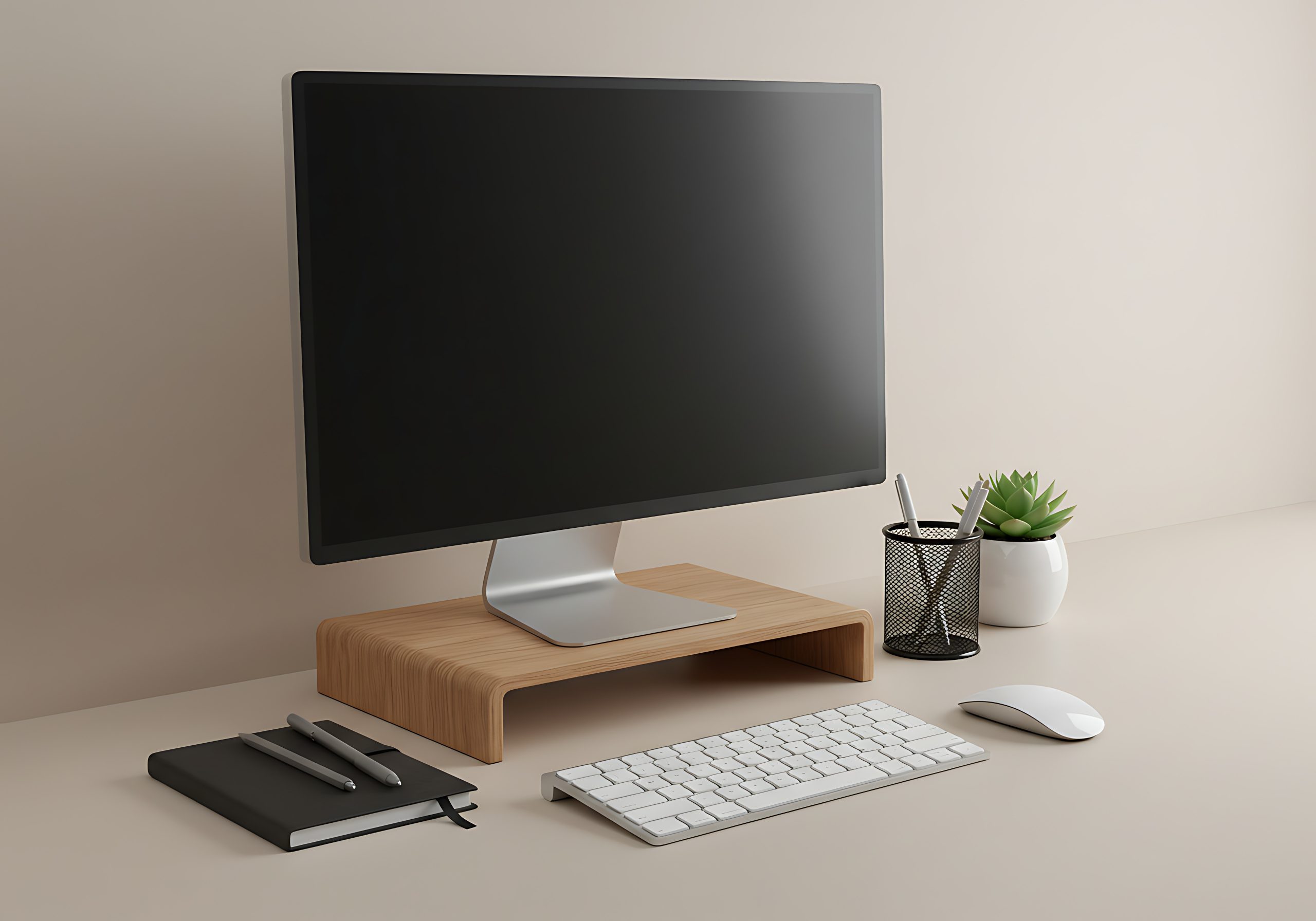
Lighting: Illuminating Your Workspace for Productivity in Your Ergonomic Home Office
Proper lighting is essential for a productive and comfortable home office. Poor lighting can lead to eye strain, headaches, and fatigue, hindering your ability to focus and work effectively. Follow these tips to optimize your home office lighting:
- Natural Light is King: Maximize the use of natural light by positioning your desk near a window. Natural light is not only beneficial for your eyesight but also boosts mood and productivity. It’s a key element of a truly ergonomic home office.
- Layer Your Lighting: Combine natural light with artificial light sources for optimal illumination. Use a combination of ambient lighting (general lighting for the room), task lighting (focused light for specific tasks), and accent lighting (decorative lighting to enhance the ambiance) to create a balanced and comfortable lighting scheme in your home office.
- Task Lighting: A desk lamp with an adjustable arm is ideal for task lighting. Position the lamp so it illuminates your work surface without creating glare on your monitor.
- Avoid Harsh Overhead Lighting: Harsh overhead lighting can cause glare and shadows, leading to eye strain. Opt for softer, diffused lighting or use a dimmer switch to control the intensity.
- Color Temperature: Choose light bulbs with a color temperature that promotes focus and productivity. Cool white or blue light is generally recommended for workspaces, while warm white light is better suited for relaxation areas. Consider the impact of color temperature when designing your ergonomic home office.
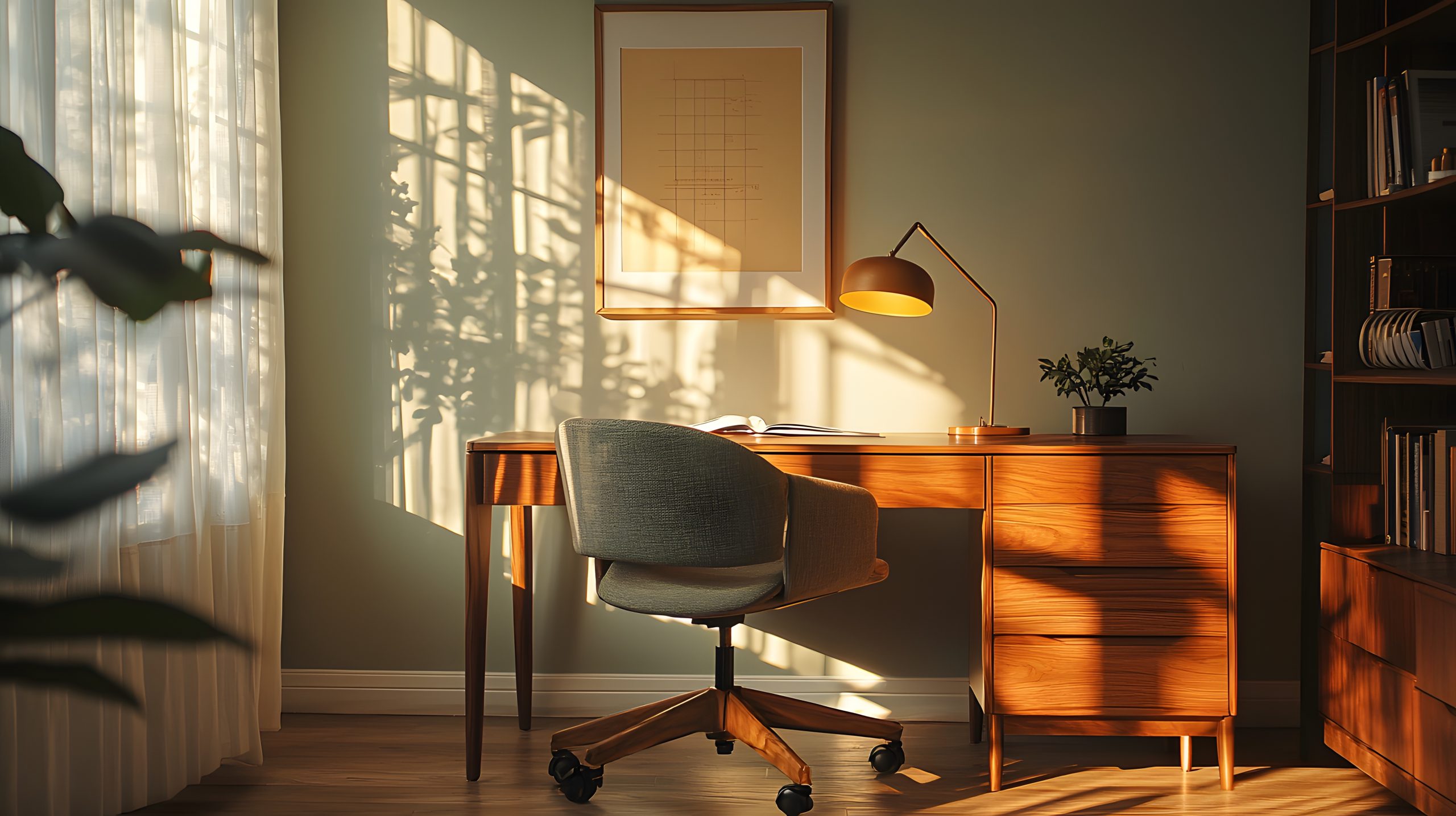
Styling Your Space: Infusing Personality into Your Ergonomic Home Office
Creating an ergonomic home office doesn’t mean sacrificing style. In fact, a visually appealing and inspiring workspace can boost your mood, creativity, and productivity. Here’s how to infuse personality into your home office while maintaining functionality:
- Color Psychology: Consider the impact of color on mood and productivity. Blues and greens are known for their calming and focusing effects, while yellows and oranges can spark creativity. Incorporate these colors strategically into your ergonomic home office design.
- Plants: Introduce plants into your workspace to bring life and vibrancy to your home office. Plants not only purify the air but also create a more calming and inviting atmosphere.
- Artwork and Accessories: Personalize your space with artwork, photographs, and decorative accessories that reflect your interests and style. These personal touches can make your home office feel more inviting and inspiring.
- Textiles: Add warmth and texture with rugs, curtains, and cushions. Choose fabrics and patterns that complement your overall design scheme.
- Wall Decor: Utilize wall space to display artwork, inspirational quotes, or even a vision board. This can add personality and motivation to your home office.
- Balance: Strive for a balance between functionality and aesthetics. While incorporating decorative elements, ensure they don’t clutter your workspace or interfere with your workflow.
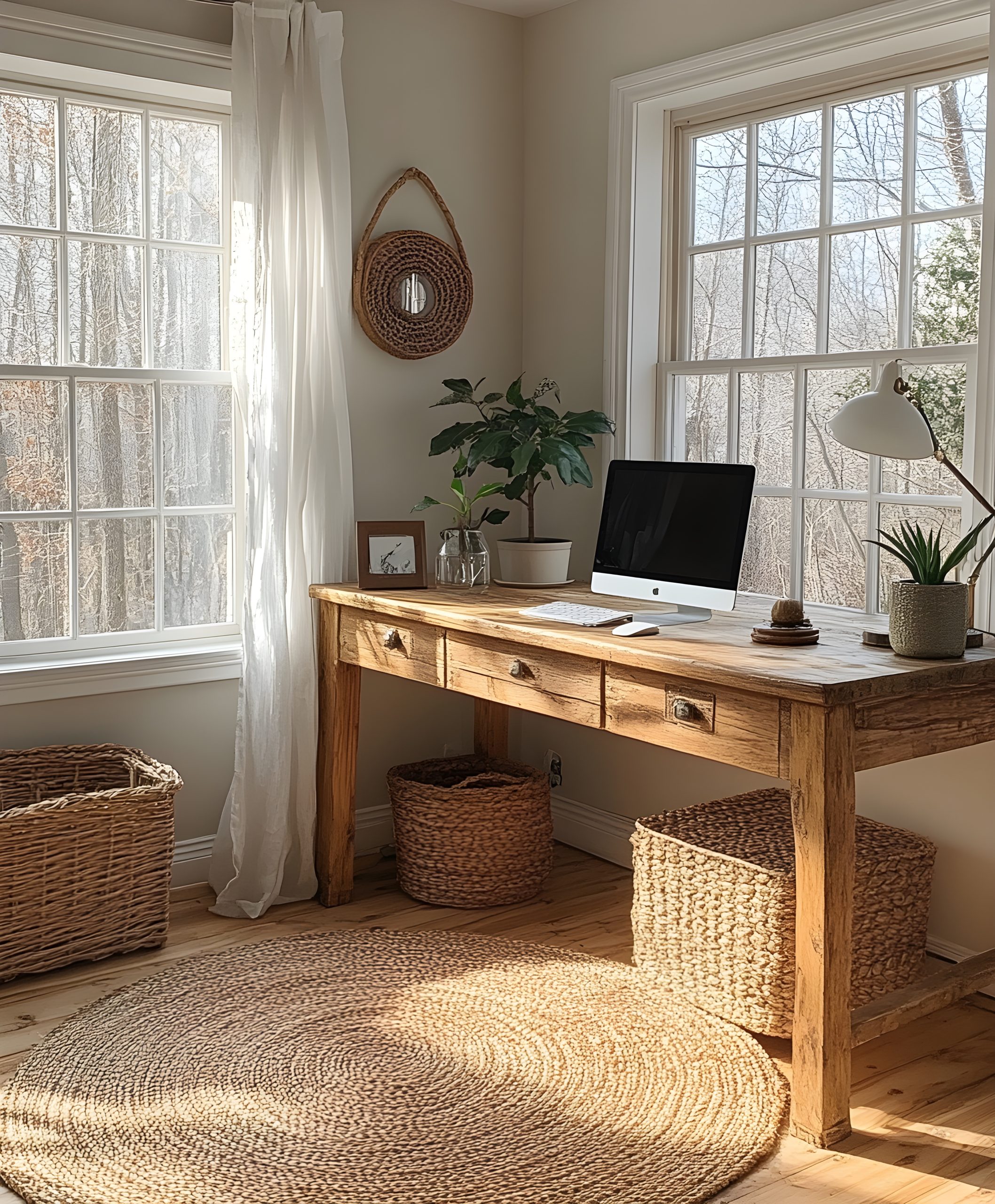
Cable Management: Hiding the Digital Jungle in Your Ergonomic Home Office
Tangled cables and wires can quickly turn a tidy home office into a chaotic mess. Effective cable management not only improves the aesthetics of your workspace but also prevents tripping hazards and makes it easier to clean. Implement these strategies to tame the digital jungle:
- Cable Ties and Clips: Use cable ties or clips to bundle cords together and keep them organized. This prevents them from tangling and creates a cleaner look.
- Cable Trays and Sleeves: Conceal cables under your desk or along walls using cable trays or sleeves. This keeps them out of sight and creates a more streamlined appearance.
- Wireless Devices: Whenever possible, opt for wireless devices such as keyboards, mice, and printers. This minimizes the number of cables cluttering your home office.
- Designated Power Strip: Use a designated power strip to plug in all your electronic devices. This keeps cords organized and makes it easier to manage power consumption.
- Labeling: Label your cables to identify which device they belong to easily. This is especially helpful if you need to troubleshoot or disconnect a specific device.
- Regular Maintenance: Regularly check your cable management system and make adjustments as needed. This prevents cables from becoming tangled and maintains a tidy home office space.
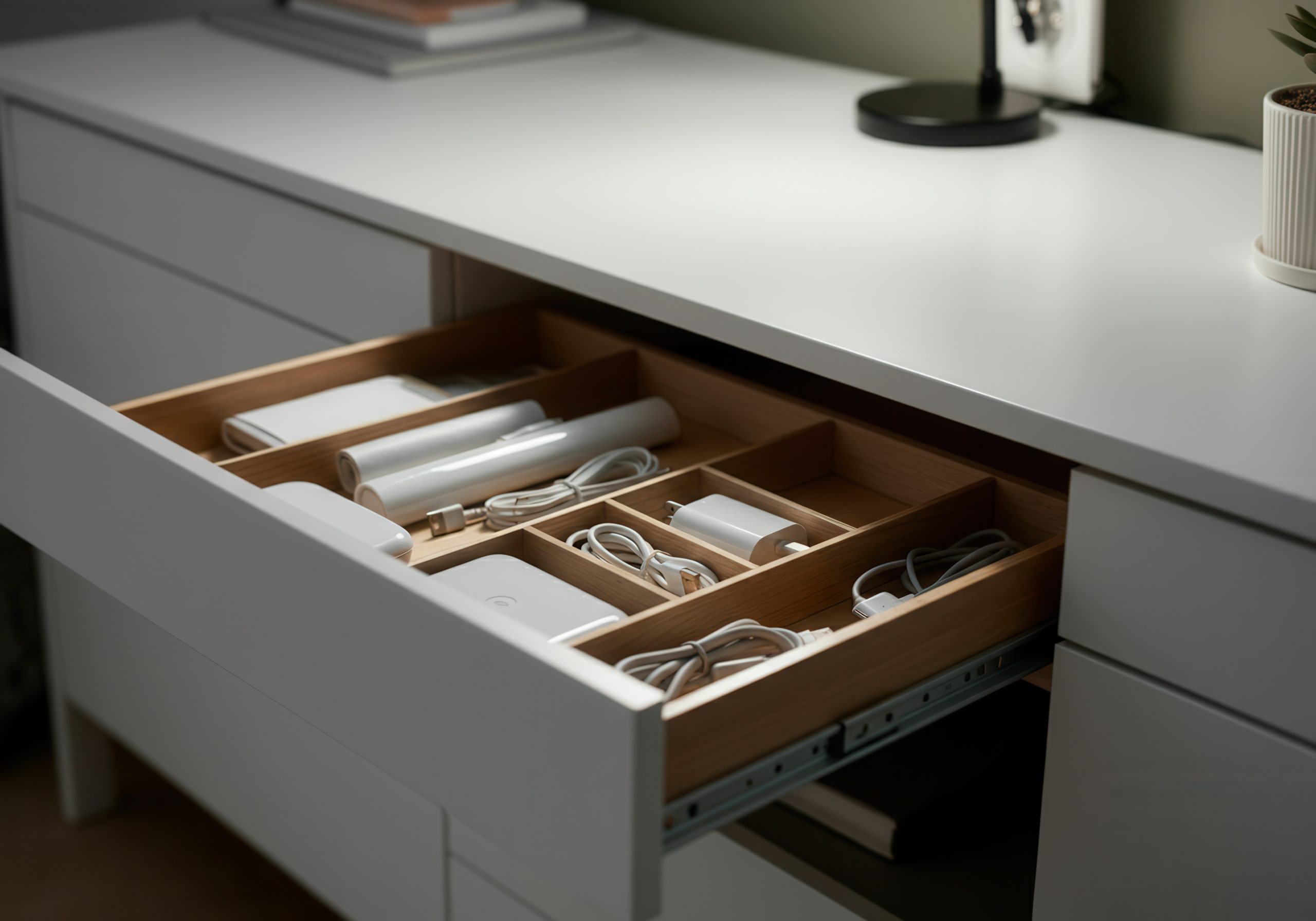
Maintenance: Keeping Your Ergonomic Haven in Tip-Top Shape
Creating an ergonomic home office is an ongoing process, not a one-time event. Regular maintenance is essential for ensuring your workspace remains comfortable, functional, and conducive to productivity. Here are some key maintenance tips:
- Regular Breaks: Take frequent breaks throughout the day to stretch, move around, and rest your eyes. This helps prevent stiffness, fatigue, and eye strain, all crucial for maintaining a truly ergonomic home office. Set reminders to ensure you take breaks regularly.
- Cleaning and Dusting: Regularly clean and dust your workspace to maintain a healthy and hygienic environment. Dust can accumulate on keyboards, monitors, and other surfaces, impacting both the aesthetics and functionality of your home office.
- Equipment Check-ups: Periodically check your equipment for wear and tear. Ensure your chair, desk, keyboard, and mouse are functioning properly and providing adequate support. Addressing issues promptly helps maintain the ergonomics of your home office.
- Re-evaluate Your Setup: As your needs and work habits evolve, re-evaluate your ergonomic home office setup. Make adjustments to your chair, desk, monitor placement, and other elements to ensure they continue to support your comfort and productivity.
- Organization: Regularly declutter and organize your workspace to prevent clutter from accumulating. A tidy and organized ergonomic home office promotes focus and efficiency.

Creating an ergonomic home office that is both functional and aesthetically pleasing is an investment in your well-being and productivity. By implementing the tips outlined in this post, you can transform your workspace into a haven of comfort and inspiration.
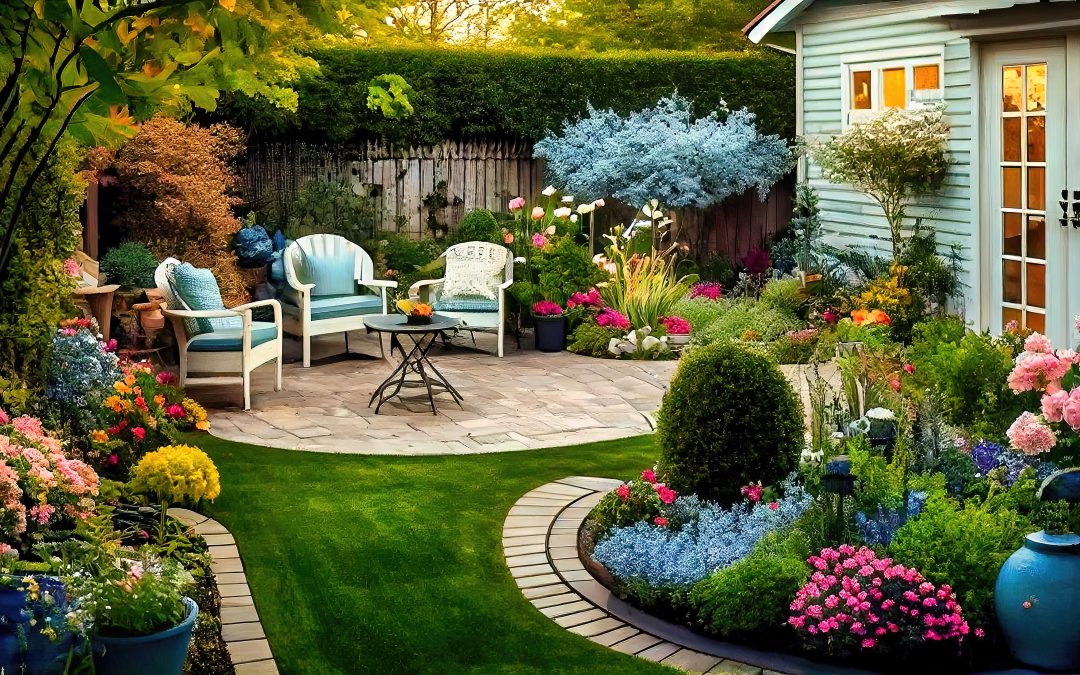
by Kesaa Interiors | Backyard & Patio, Beginner Design Guides, DESIGN GUIDES
Read along for the ultimate garden planning guide.

Imagine stepping into your backyard and being greeted by a vibrant oasis of colour and fragrance. A well-designed garden can be a source of immense joy, providing a peaceful retreat and a connection to nature. But achieving this idyllic scene doesn’t happen by chance. Effective garden planning is the key to transforming your outdoor space into the beautiful yard you’ve always dreamed of.
This comprehensive guide will equip you with the knowledge and tools you need to embark on your garden planning journey, covering everything from assessing your space to choosing the right plants and maintaining your garden’s beauty for years to come.
The Best Garden Planning Tips!
1: Assessing Your Space and Resources for Effective Garden Planning
Understanding Your Canvas
Before you even consider picking up a trowel, the first step in garden planning is to thoroughly assess your existing space and resources. Understanding your yard’s unique characteristics will lay the foundation for a successful and thriving garden. This initial phase of garden planning might seem tedious, but it’s crucial for making informed decisions down the line.
Begin by analysing the sunlight exposure in different areas of your yard. Some plants thrive in full sun, while others prefer shade. Observe how the sunlight moves across your yard throughout the day. A simple sun map can be incredibly helpful during the garden planning process.
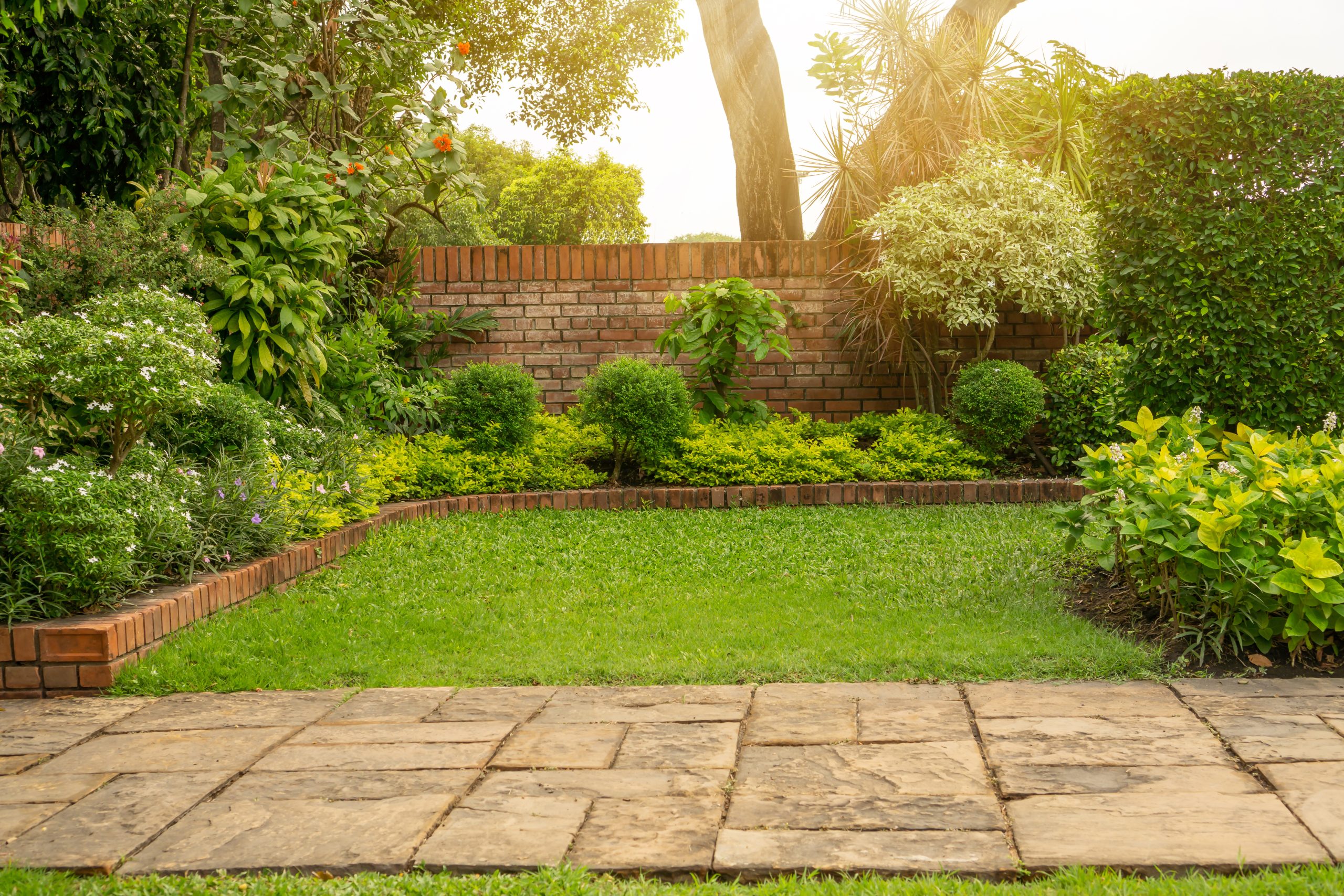
Next, evaluate your soil type and drainage. Different plants have different soil preferences. Is your soil sandy, clay-like, or loamy? Does the water pool after rain, or does it drain quickly? Knowing the answers to these questions will guide your plant selection and garden planning decisions.
Accurate measurements are essential for effective garden planning. Measure the available space for planting, taking into account existing features like trees, fences, and structures. This will help you determine how many plants you can accommodate and how to arrange them effectively.
Finally, consider your budget and available time for garden maintenance. Garden planning should be realistic. Choose plants that fit your lifestyle and resources. A low-maintenance garden might be ideal if you have limited time. Careful garden planning from the outset will prevent frustration and ensure a garden you can enjoy for years to come.
2: Defining Your Garden Style and Purpose
Visualising Your Dream Garden
With a clear understanding of your yard’s characteristics, the next stage of garden planning involves defining your garden’s style and purpose. This is where you let your creativity bloom and envision the garden of your dreams. What kind of atmosphere do you want to create? What do you hope to achieve with your garden?
Explore different garden styles to find one that resonates with you. Do you prefer the structured elegance of a formal garden, the charming informality of a cottage garden, or the clean lines of a contemporary garden? Researching various styles will provide inspiration and help you narrow down your preferences.
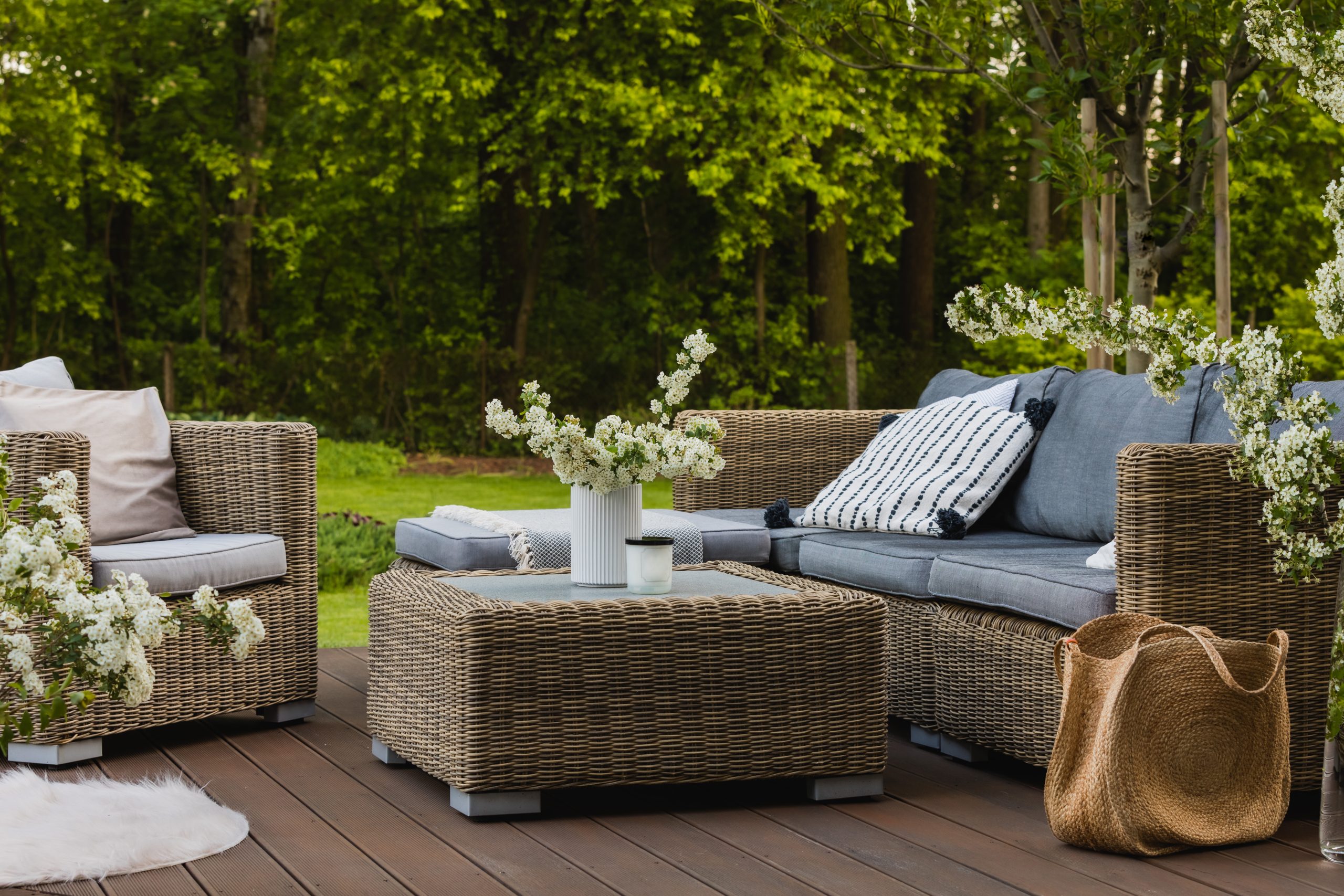
Consider the primary purpose of your garden. Are you primarily interested in growing colorful flowers for visual appeal? Do you envision a bountiful vegetable garden to provide fresh produce for your table? Or perhaps you seek a tranquil retreat for relaxation and contemplation? Defining your garden’s purpose is a crucial element of garden planning.
Your personal preferences and lifestyle should also play a significant role in your garden planning process. Do you enjoy spending time outdoors tending to your plants, or do you prefer a low-maintenance garden? Think about how you plan to use your garden space. Will it be a place for entertaining guests, or a private sanctuary for quiet enjoyment? Effective garden planning aligns your garden with your individual needs and desires.
3: Choosing the Right Plants for Your Garden Plan
Selecting Your Green Companions
Now comes the exciting part of garden planning: choosing the plants that will bring your vision to life! With countless plant varieties available, it’s essential to select plants that are well-suited to your specific climate, soil conditions, and garden style.
Thorough research is key to successful garden planning. Consult local gardening resources, nurseries, or online databases to identify plants that thrive in your region. Consider factors such as average temperatures, rainfall, and frost dates. Choosing plants adapted to your local climate will significantly increase their chances of survival and minimise the need for extensive care.
When selecting plants, pay attention to their size, growth habit, and flowering season. Do you want tall, stately plants or low-growing groundcovers? Do you prefer plants with vibrant blooms or interesting foliage? Consider the timing of their flowering periods to ensure a continuous display of colour throughout the growing season.
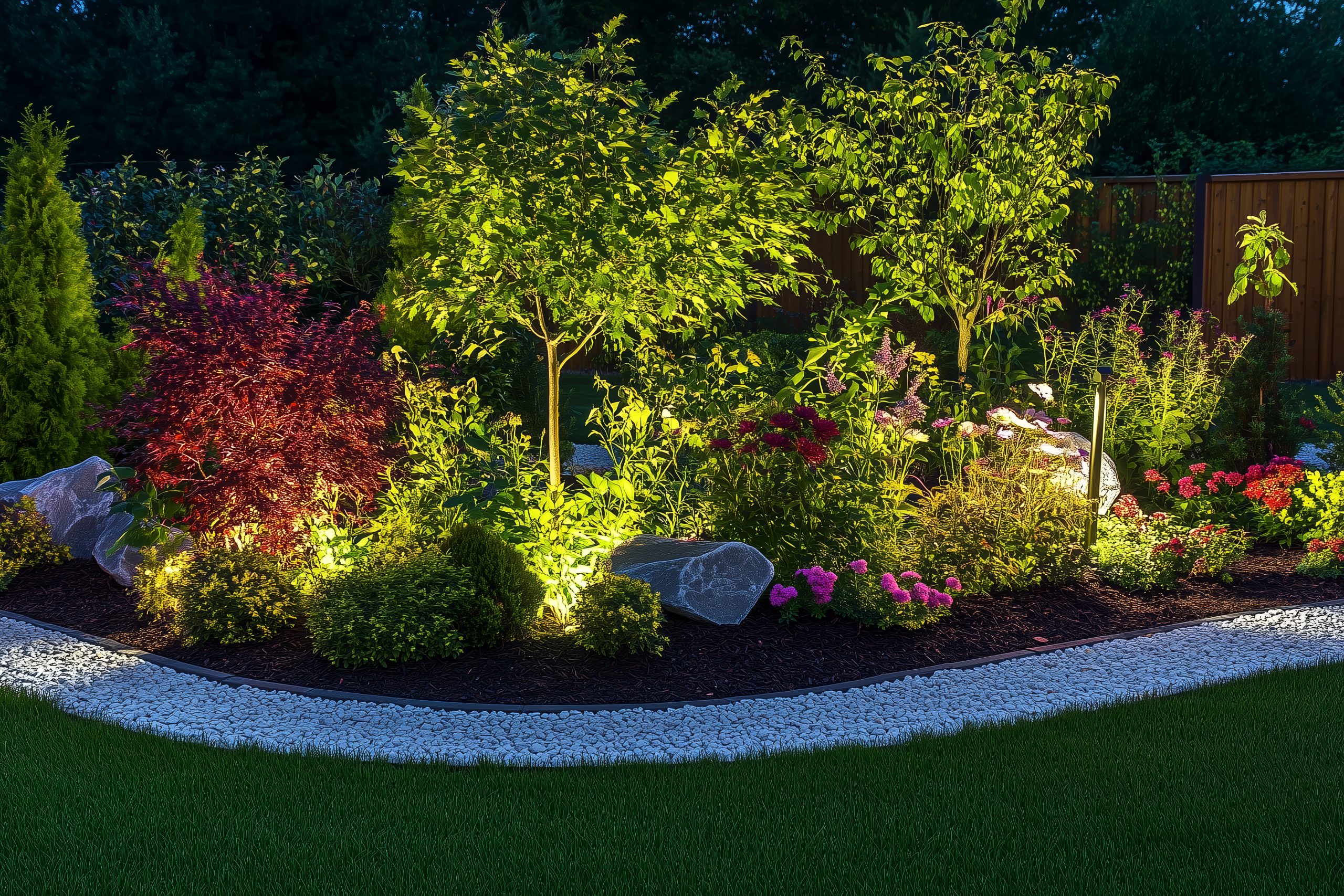
A diverse selection of plants is essential for a healthy and visually appealing garden. Incorporating a variety of species not only adds interest but also promotes biodiversity and resilience. Think about companion planting, a technique where certain plants are grown together to benefit each other. Some combinations can deter pests, improve soil health, or even enhance the flavor of vegetables. Successful garden planning involves considering these ecological interactions.
4: Creating a Functional and Aesthetic Garden Layout
Designing Your Garden’s Blueprint
With your plant selection finalised, the next phase of garden planning involves creating a functional and aesthetically pleasing layout. This is where you’ll determine the precise placement of each plant and other elements within your garden space.
Start by sketching a garden plan on paper or using online garden planning tools. This visual representation will help you organise your thoughts and ensure that all the elements work together harmoniously. Indicate the location of existing features like trees, fences, and structures, and then begin placing your chosen plants within the available space.
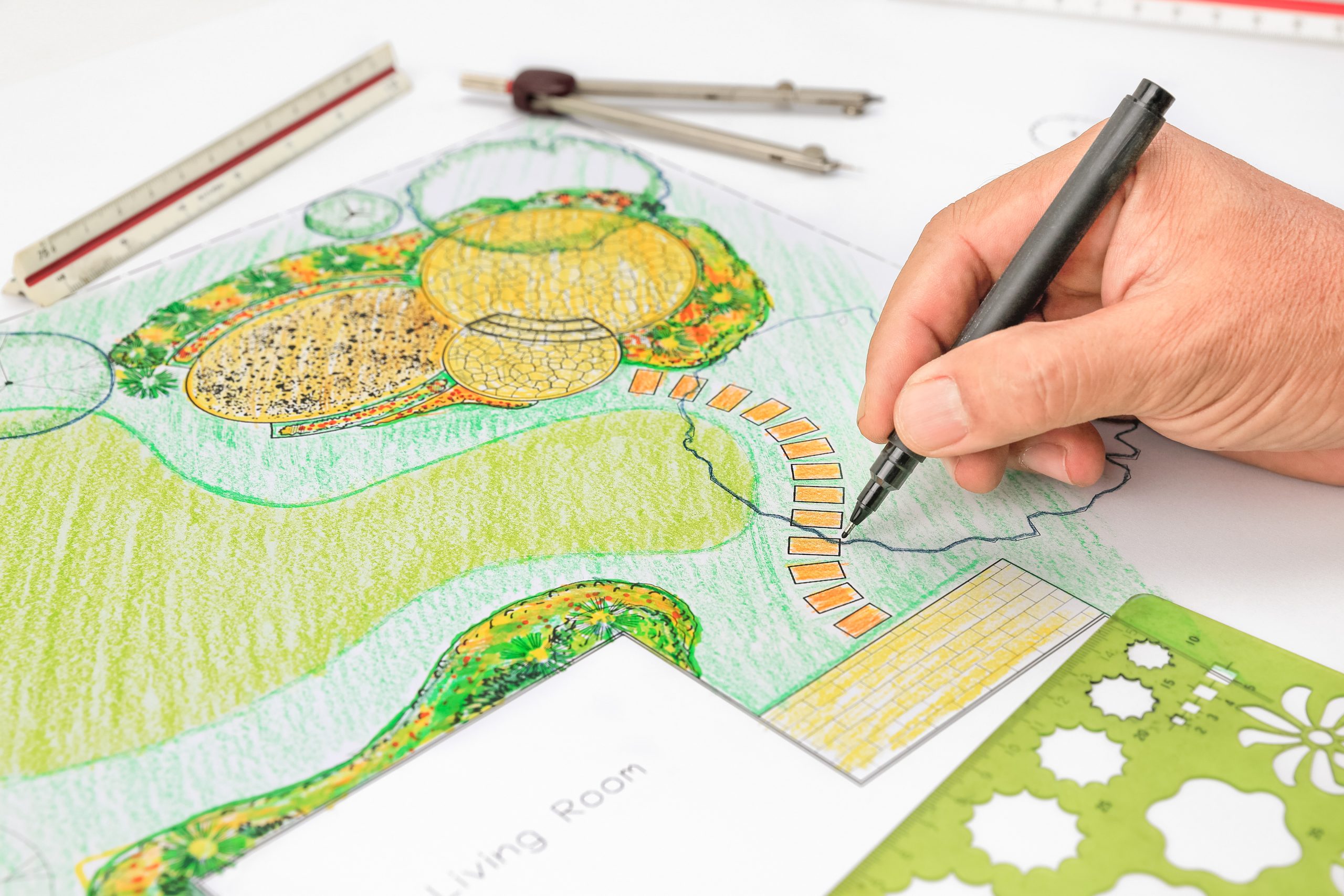
Consider the flow and accessibility of different areas within your garden. Create pathways that allow you to easily navigate through the space and access different sections for maintenance. Think about how you want to move through the garden and where you might want to pause and enjoy the scenery.
Focal points and visual pathways are essential elements of effective garden planning. A focal point can be a striking plant, a sculpture, or a water feature that draws the eye and creates a sense of visual interest. Visual pathways, created through the arrangement of plants and hardscaping elements, guide the eye through the garden and create a sense of depth and perspective.
Hardscaping elements such as paths, patios, and retaining walls play a crucial role in defining the structure and functionality of your garden. These features not only enhance the aesthetic appeal but also provide practical benefits like improved drainage and erosion control. Incorporate hardscaping elements strategically into your garden plan to create distinct areas and enhance the overall design.
5: Preparing the Soil and Planting Your Garden
Bringing Your Garden to Life
With your garden plan in place, it’s time to get your hands dirty and start preparing the soil for planting. This crucial step in garden planning ensures that your plants have the best possible start and sets the stage for healthy growth.
Amend the soil with compost or other organic matter to improve its structure, fertility, and drainage. This is a fundamental aspect of garden planning, as healthy soil is the foundation of a thriving garden. Spread a layer of compost over the planting area and work it into the existing soil using a garden fork or tiller.

Follow proper planting techniques for different plant types. Some plants prefer to be planted in shallow holes, while others require deeper planting. Pay attention to the spacing recommendations for each plant to avoid overcrowding and ensure adequate air circulation.
Water thoroughly after planting to help the roots establish themselves in the new soil. Consistent watering is especially important during the first few weeks after planting. Mulch around plants to retain moisture, suppress weeds, and regulate soil temperature. Mulching is a valuable garden planning technique that reduces maintenance and promotes healthy plant growth.
6: Maintaining Your Garden’s Beauty
Nurturing Your Garden’s Growth
Once your garden is planted, ongoing maintenance is essential for preserving its beauty and ensuring its long-term health. This final stage of garden planning involves developing a regular routine to provide your plants with the care they need to thrive.
Develop a watering schedule based on plant needs and weather conditions. Some plants require frequent watering, while others are more drought-tolerant. Monitor the soil moisture regularly and adjust your watering schedule accordingly.
Fertilise plants regularly to provide them with the nutrients they need for optimal growth. Choose a fertiliser that is appropriate for the types of plants in your garden. Follow the instructions on the fertiliser packaging carefully to avoid over-fertilising, which can harm your plants.
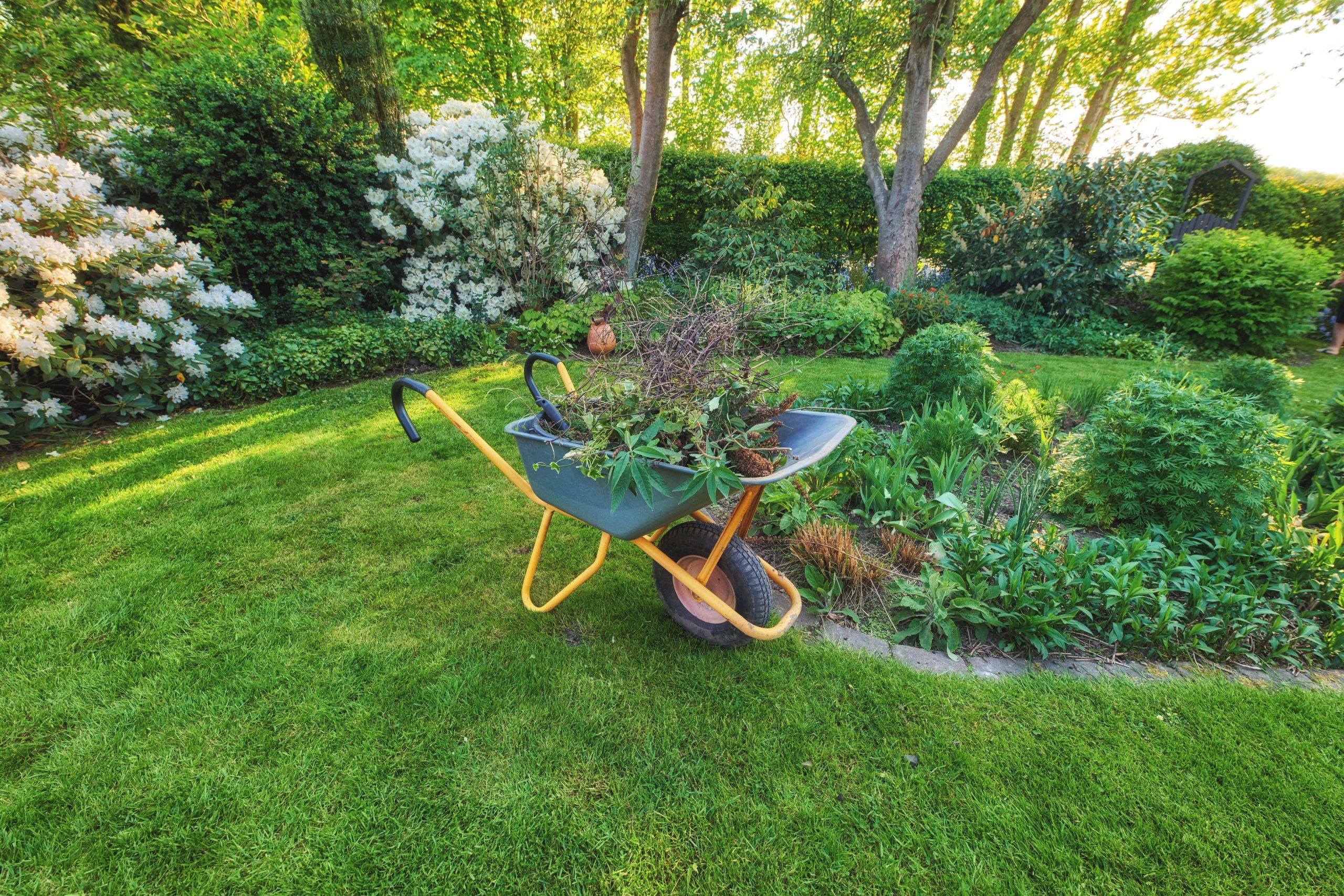
Prune plants to maintain their shape, encourage flowering, and remove dead or diseased branches. Pruning is an important aspect of garden planning, as it helps to keep your plants healthy and looking their best.
Regularly monitor your garden for pests and diseases. Early detection is key to preventing widespread infestations or infections. Take appropriate action if you notice any signs of pests or diseases, such as using organic pest control methods or removing affected plant parts. Ongoing garden planning is essential for long-term success.
7: Adapting Your Garden Plan Over Time
Embracing the Evolution of Your Garden
One of the most important things to remember about garden planning is that gardens are dynamic and ever-changing. As your plants grow and mature, your garden will evolve, and your garden planning should evolve along with it. Embrace this process of change and be prepared to adapt your garden plan over time.
Acknowledge that some plants may grow larger than anticipated, while others may not perform as well as expected. Be prepared to relocate plants, divide overgrown perennials, or even remove plants that are not thriving. Flexibility is key to successful long-term garden planning.
Consider the seasonal changes and adapt your maintenance accordingly. Different seasons require different approaches to watering, fertilising, and pest control. Incorporate seasonal tasks into your garden planning, such as preparing your garden for winter or planting spring bulbs.

Don’t be afraid to experiment with new plants and design ideas. As you gain experience with garden planning, you may discover new plants that you love or develop new design preferences. Be open to trying new things and incorporating them into your garden plan. A garden is a living canvas, and garden planning is an ongoing process of learning and experimentation.
Creating a beautiful and thriving garden is a rewarding journey that begins with careful garden planning. By following the steps outlined in this guide, you can transform your outdoor space into a haven of beauty and tranquility. Remember that successful garden planning involves understanding your space, choosing the right plants, creating a functional layout, and providing ongoing maintenance.
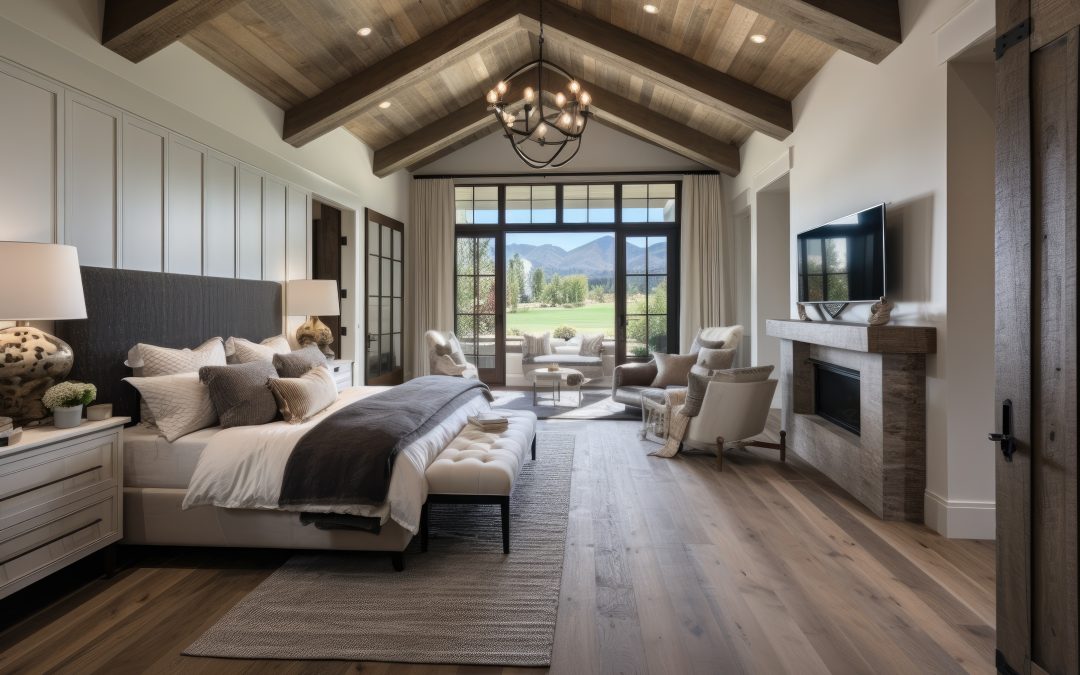
by Kesaa Interiors | Bedroom, DESIGN GUIDES, How-To Guides, ROOMS
Create the perfect retreat to relax and unwind, follow along with these tips and tricks to come home to a master suite design you love.
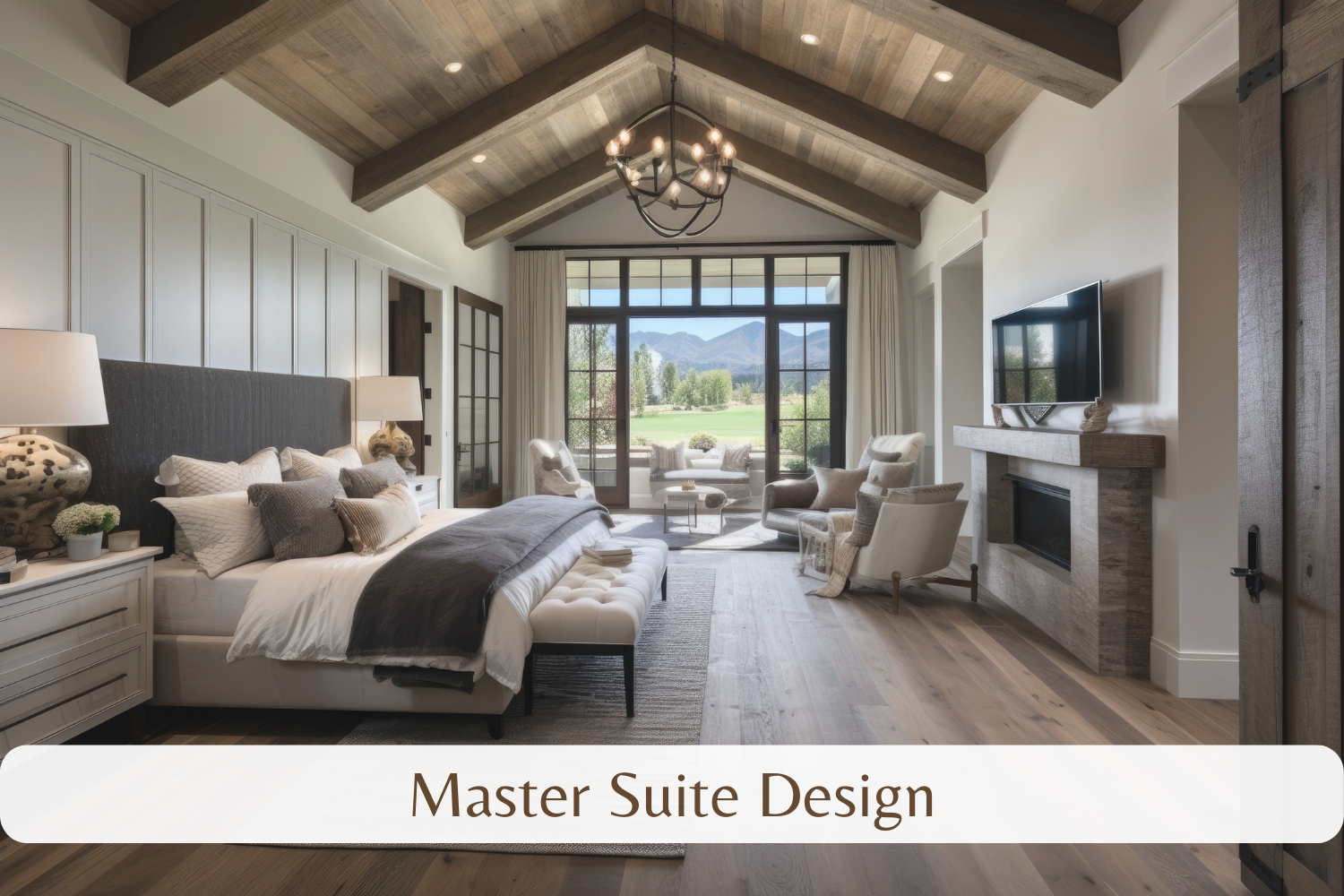
Transform your master suite into a haven of tranquillity and luxury. Your master suite should be more than just a bedroom; it should be a personal sanctuary where you can relax and rejuvenate.
This post will explore actionable tips and inspiring ideas to elevate your master suite design, creating a luxurious retreat you’ll never want to leave.
1: The Blueprint for Your Dream Master Suite Design
Initial Planning and Considerations
Embarking on a master suite design project requires careful planning to ensure the final result aligns perfectly with your vision. Before diving into paint swatches and furniture catalogues, take the time to consider the foundational elements of your master suite design.
Understanding your lifestyle, needs, and budget is crucial for a successful outcome. Do you envision a serene minimalist space or a more opulent and glamorous retreat? How will the space be used – primarily for sleep, or will it also serve as a dressing room, home office, or reading nook? Establishing a realistic budget will guide your choices throughout the design process and prevent overspending.
Equally important is the flow and layout of your master suite. Consider the placement of furniture, the traffic flow within the room, and the connection to adjoining spaces like the master bathroom. A well-planned master suite design maximises functionality and creates a harmonious environment.
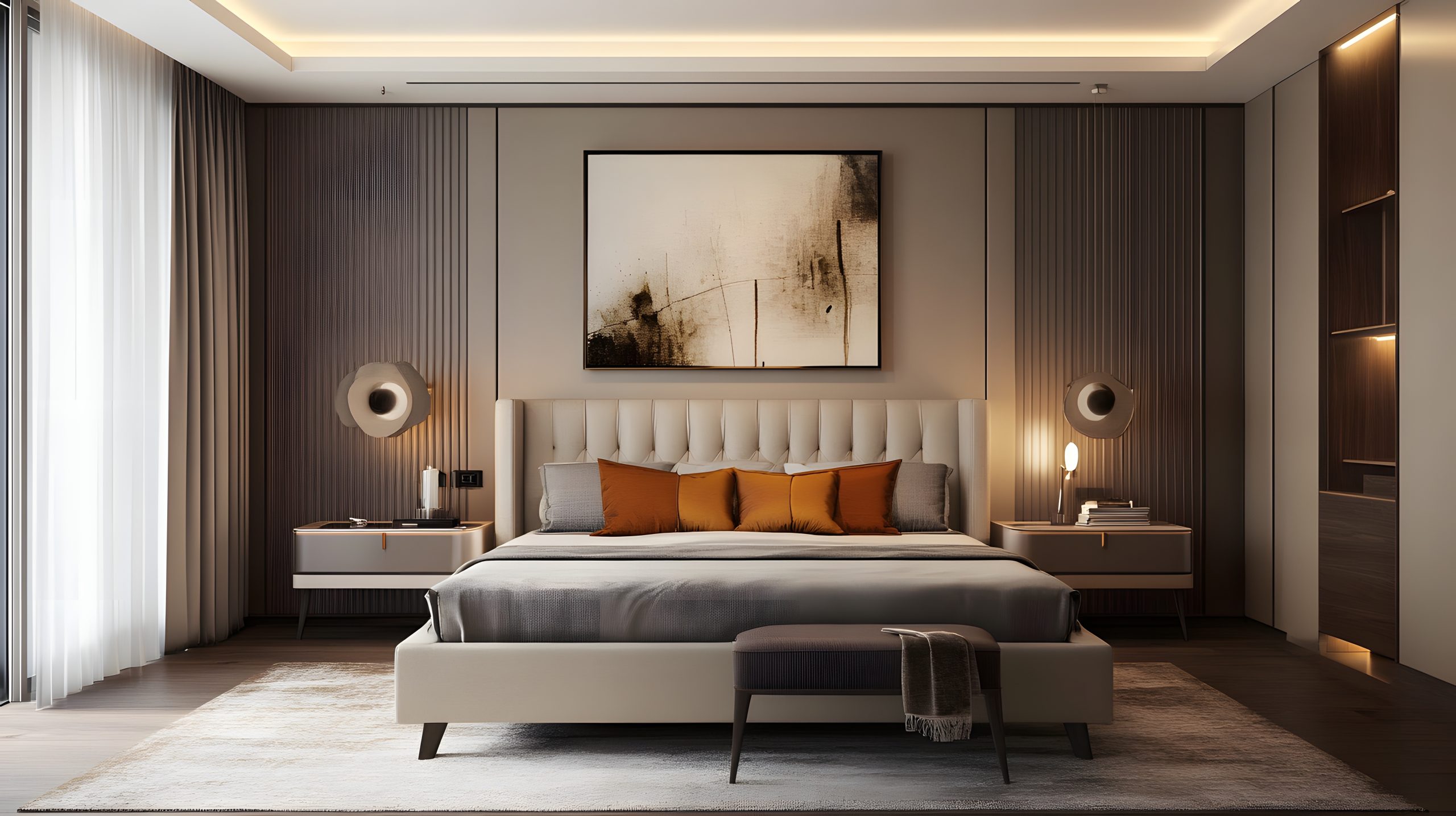
2: Crafting the Perfect Colour Scheme
The Psychology of Colour in Your Master Suite
Colour plays a pivotal role in setting the mood and ambience of your master suite design. Understanding the psychology of colour can help you create a space that reflects your desired atmosphere. Soft, muted tones like blues and greens evoke a sense of calm and tranquillity, perfect for promoting relaxation and sleep. On the contrary, warmer hues like yellows and oranges can create a more energetic and uplifting environment. For a luxurious master suite design, consider incorporating rich jewel tones like emerald green, sapphire blue, or ruby red as accent colours to add depth and sophistication.
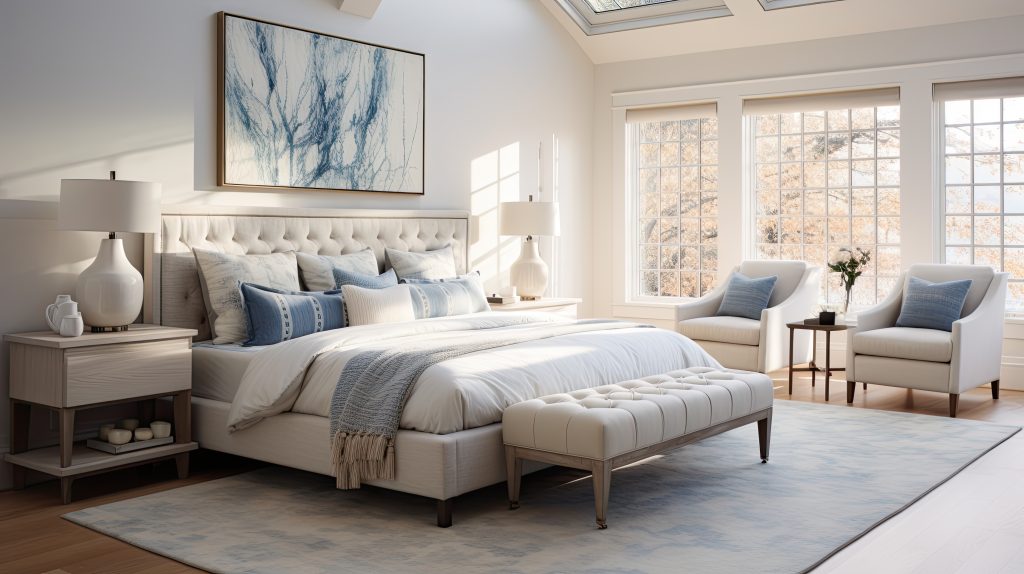
Luxurious Colour Palette Ideas
Creating a cohesive and luxurious colour palette is essential for a successful master suite design. Consider starting with a neutral base of whites, creams, or soft greys. These versatile hues create a sense of airiness and provide a blank canvas for layering in other colours and textures. For a touch of drama, incorporate rich jewel tones or deep, saturated colours as accents. A popular choice for master suite design is a monochromatic scheme, using varying shades of a single colour to create a sophisticated and harmonious look. For example, layering different shades of blue, from pale sky blue to deep navy, can create a calming and luxurious atmosphere. Don’t be afraid to experiment with different colour combinations to find the perfect palette that reflects your personal style and enhances your master suite design.
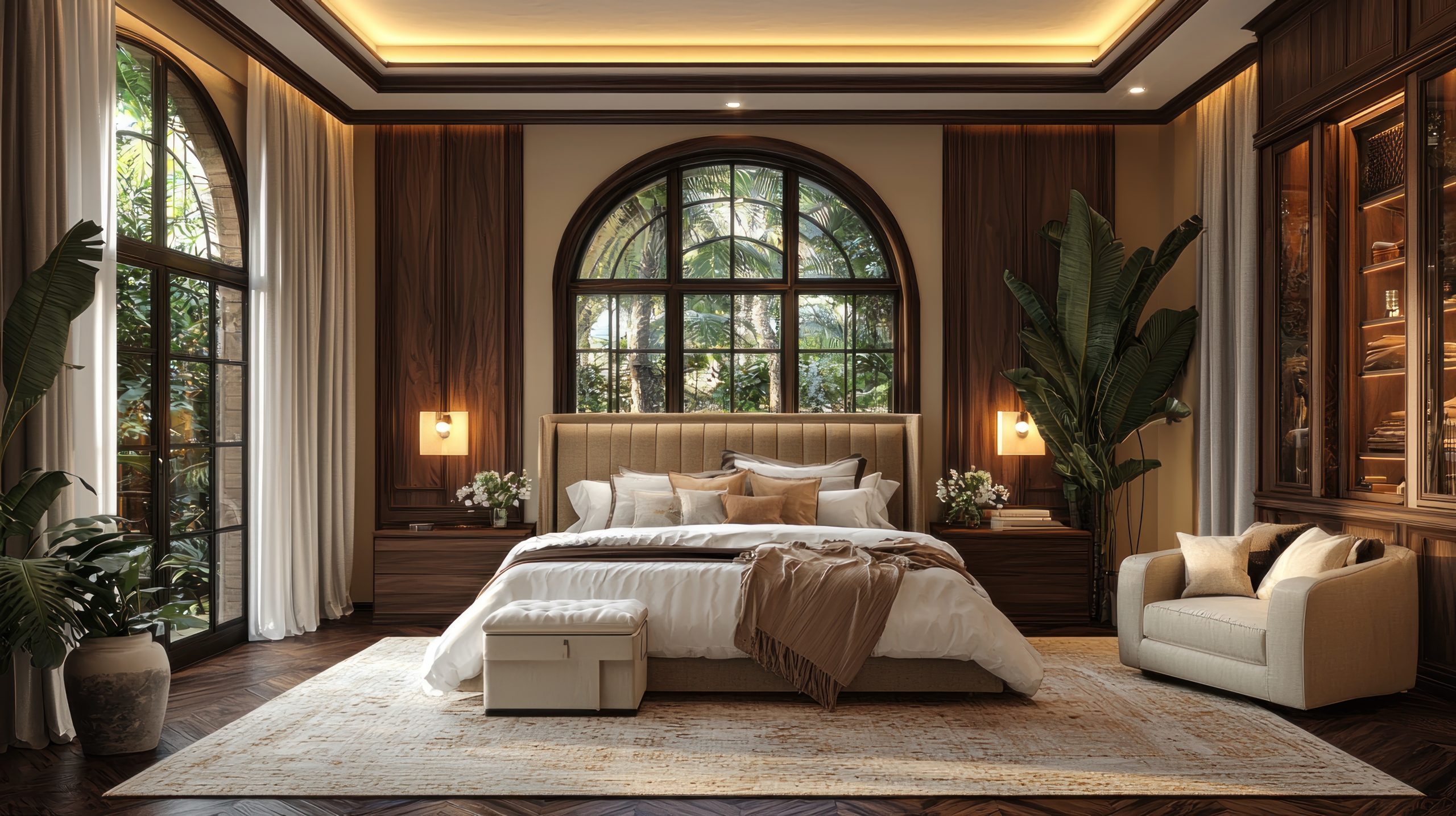
3: Luxurious Materials: Textures and Finishes
Indulge in Tactile Luxury
Elevating your master suite design goes beyond just colour; it’s about incorporating luxurious textures and finishes that create a truly indulgent experience. Introduce lavish fabrics like velvet, silk, and linen for bedding, curtains, and upholstery. A plush velvet headboard or a silk throw draped across the bed instantly adds a touch of luxury. Incorporating natural materials like wood, stone, and marble can further enhance the luxurious feel of your master suite design. A beautifully crafted wooden bed frame or a marble-topped nightstand adds a touch of sophistication and timeless elegance. Layering different textures creates visual interest and depth, making your master suite a feast for the senses. Consider a faux fur rug for a touch of warmth and glamour, or woven baskets for storage that add a natural and organic element.
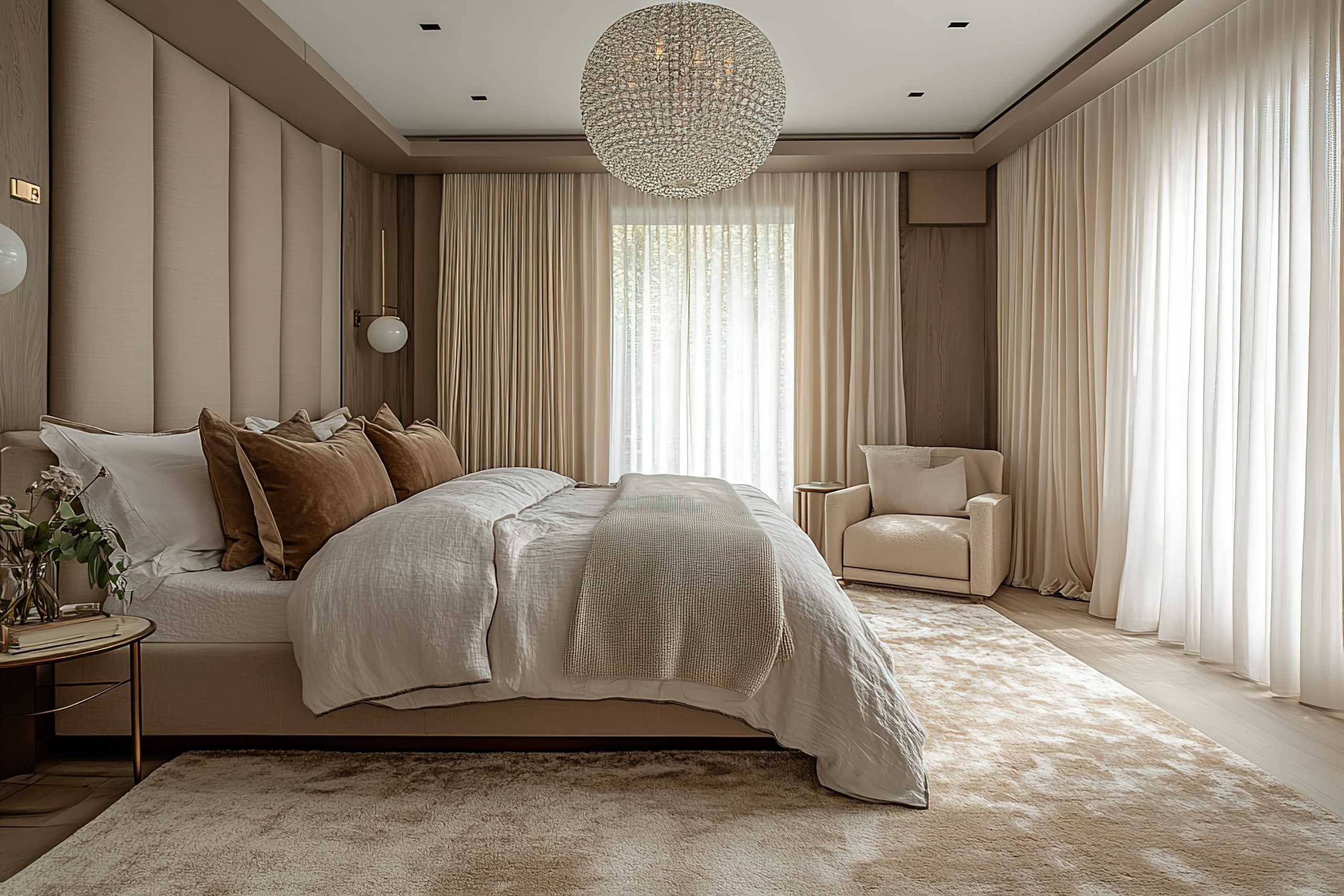
The Gleam of Metallic Accents
Metallic finishes play a crucial role in adding a touch of glamour and sophistication to your master suite design. Incorporate shimmering accents of gold, silver, brass, or copper through lighting fixtures, hardware, and decorative accessories. A stunning brass chandelier can serve as a focal point, while sleek silver drawer pulls add a subtle touch of elegance. Consider incorporating metallic accents through decorative trays, mirrors, or picture frames. The key is to use metallics strategically, avoiding overuse, to create a sense of refined luxury within your master suite design.
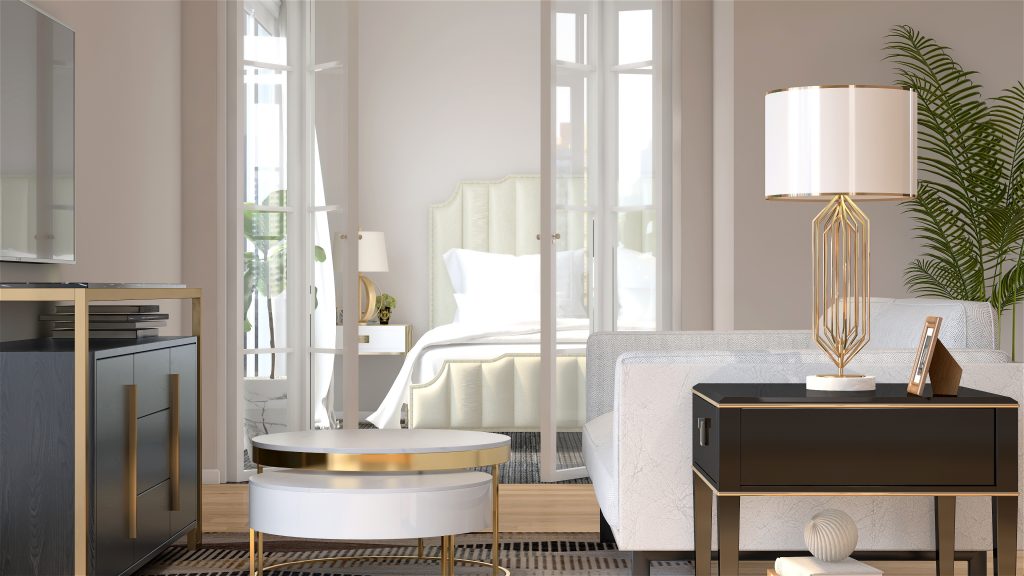
4: Furniture Selection for a Luxurious Master Suite Design
The Statement Bed: The Heart of Your Suite
The bed is undoubtedly the centrepiece of any master suite, and choosing the right one is paramount to achieving a luxurious design. Invest in a high-quality, statement bed that radiates both comfort and style. Consider an upholstered bed frame in a rich velvet or linen fabric for a touch of elegance. A four-poster bed or a canopy bed can create a dramatic and romantic focal point, adding a sense of grandeur to your master suite design. Make sure the bed size is appropriate for the room’s scale, and choose a mattress and bedding that prioritise comfort and promote restful sleep.
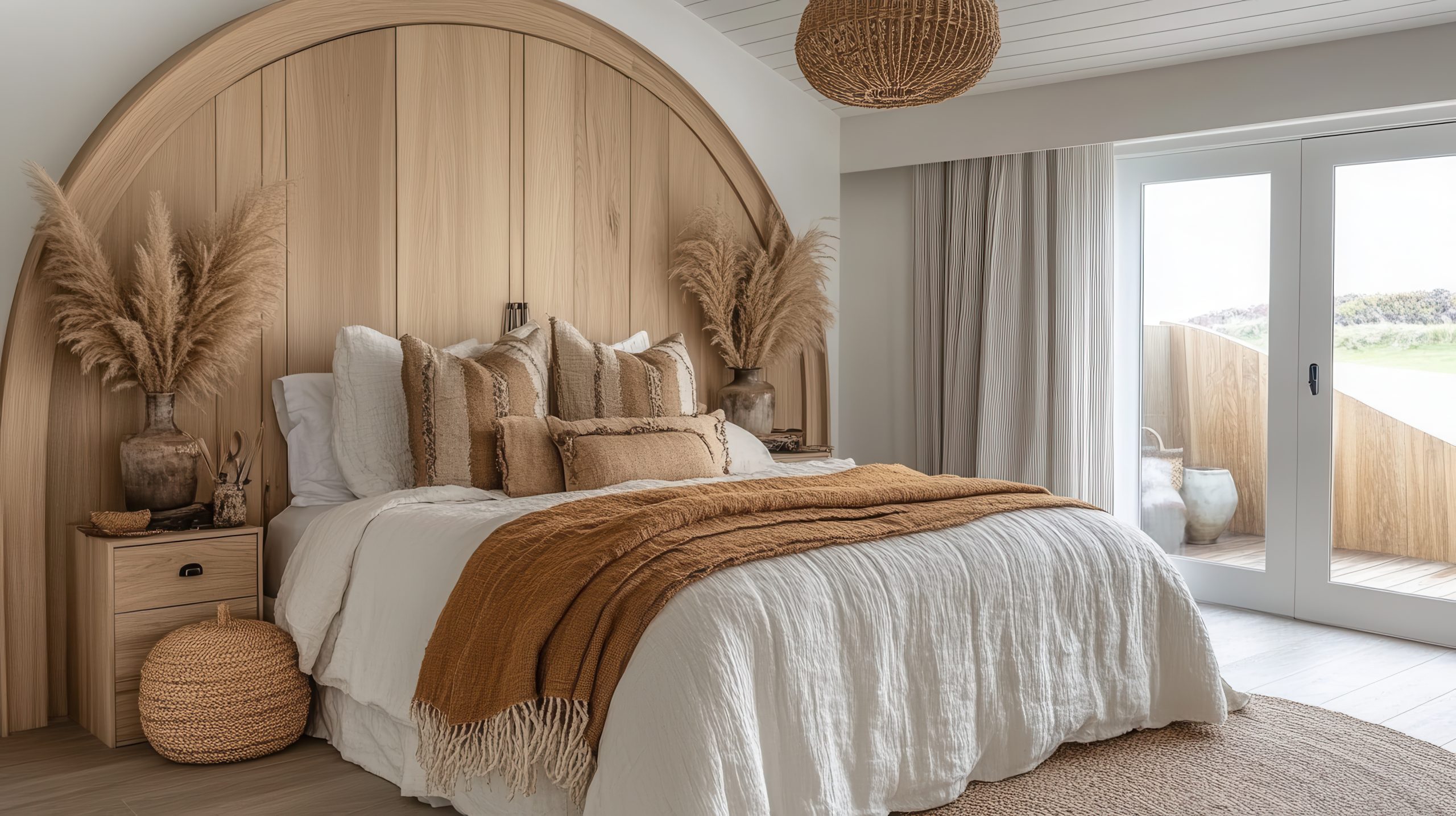
Creating a Relaxing Seating Area
Incorporating a dedicated seating area within your master suite design can transform it into a true retreat. This provides a comfortable space to unwind, read, or enjoy a morning cup of coffee. Consider adding a plush chaise lounge, a pair of elegant armchairs, or a small loveseat. Choose furniture that complements the overall design aesthetic of your master suite and provides ample comfort. A small table and a floor lamp can complete the seating area, creating a cozy and inviting space within your master suite design.
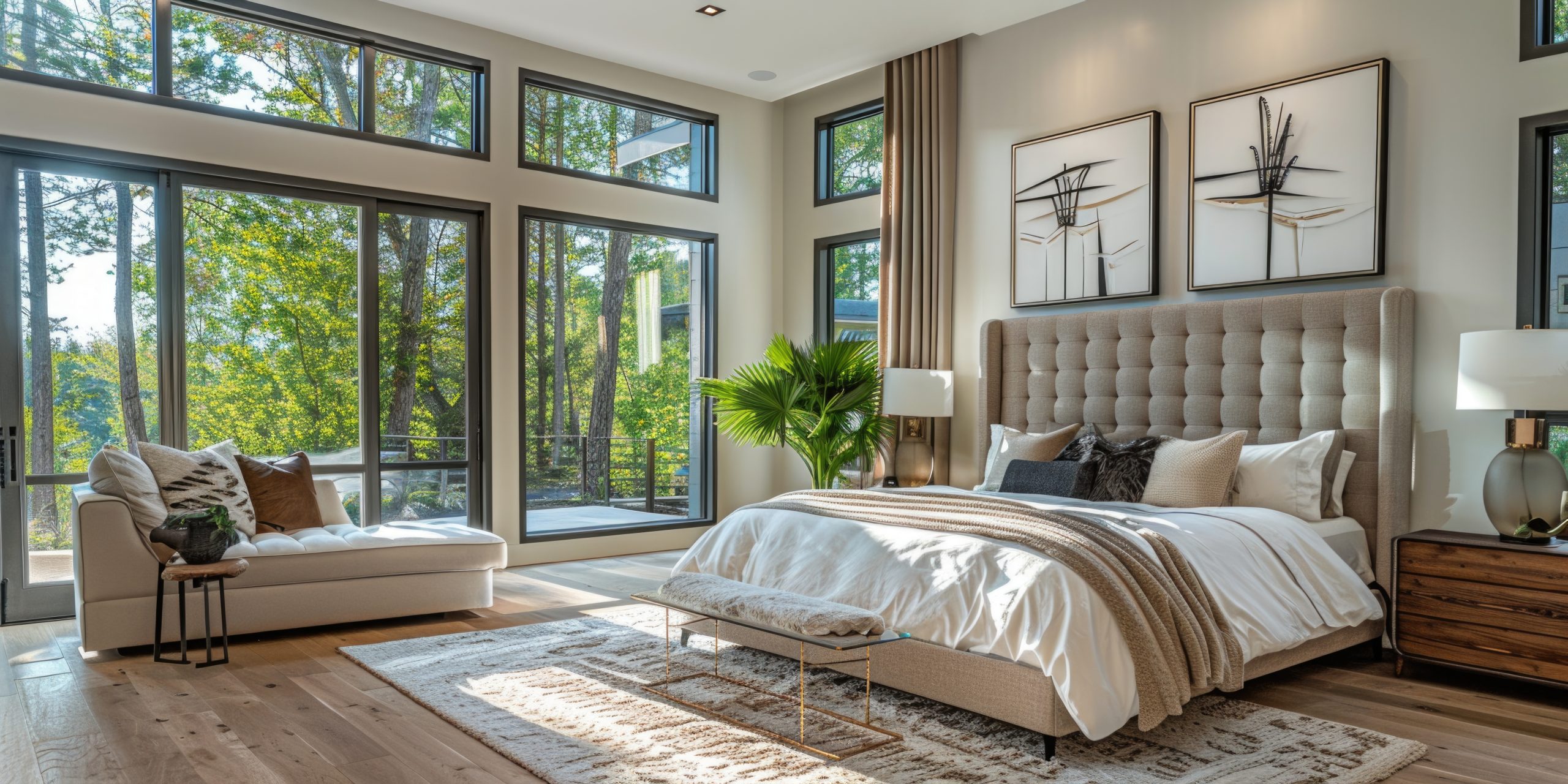
5: Lighting Design: Setting the Mood
Layered Lighting for a Luxurious Ambiance
Lighting plays a crucial role in creating the desired atmosphere in your master suite design. Implement a layered lighting approach to achieve both functionality and ambience.
- Ambient lighting provides overall illumination for the room and can be achieved through recessed lighting, a central chandelier, or wall sconces.
- Task lighting is essential for specific activities like reading or applying makeup and can be provided by bedside lamps or vanity lights.
- Accent lighting adds a touch of drama and highlights specific features within the room, such as artwork or architectural details.
Consider using dimmer switches to control the intensity of the lighting and create different moods throughout the day. A well-executed lighting plan is essential for enhancing the luxurious feel of your master suite design.
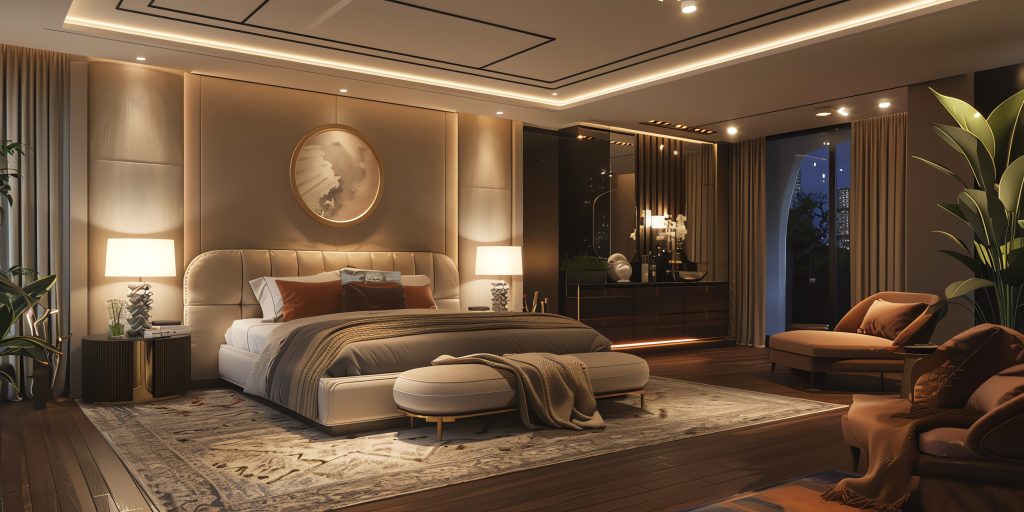
Section 6: The Finishing Touches: Accessories and Bathroom Integration
Luxurious Bedding and Linens: The Ultimate Indulgence
Investing in high-quality bedding and linens is a crucial step in creating a truly luxurious master suite design. Opt for soft, high-thread-count sheets made from Egyptian cotton, linen, or silk. A plush duvet and a selection of decorative pillows add layers of comfort and texture. Choose bedding that complements your chosen colour palette and adds a touch of elegance to your master suite design.
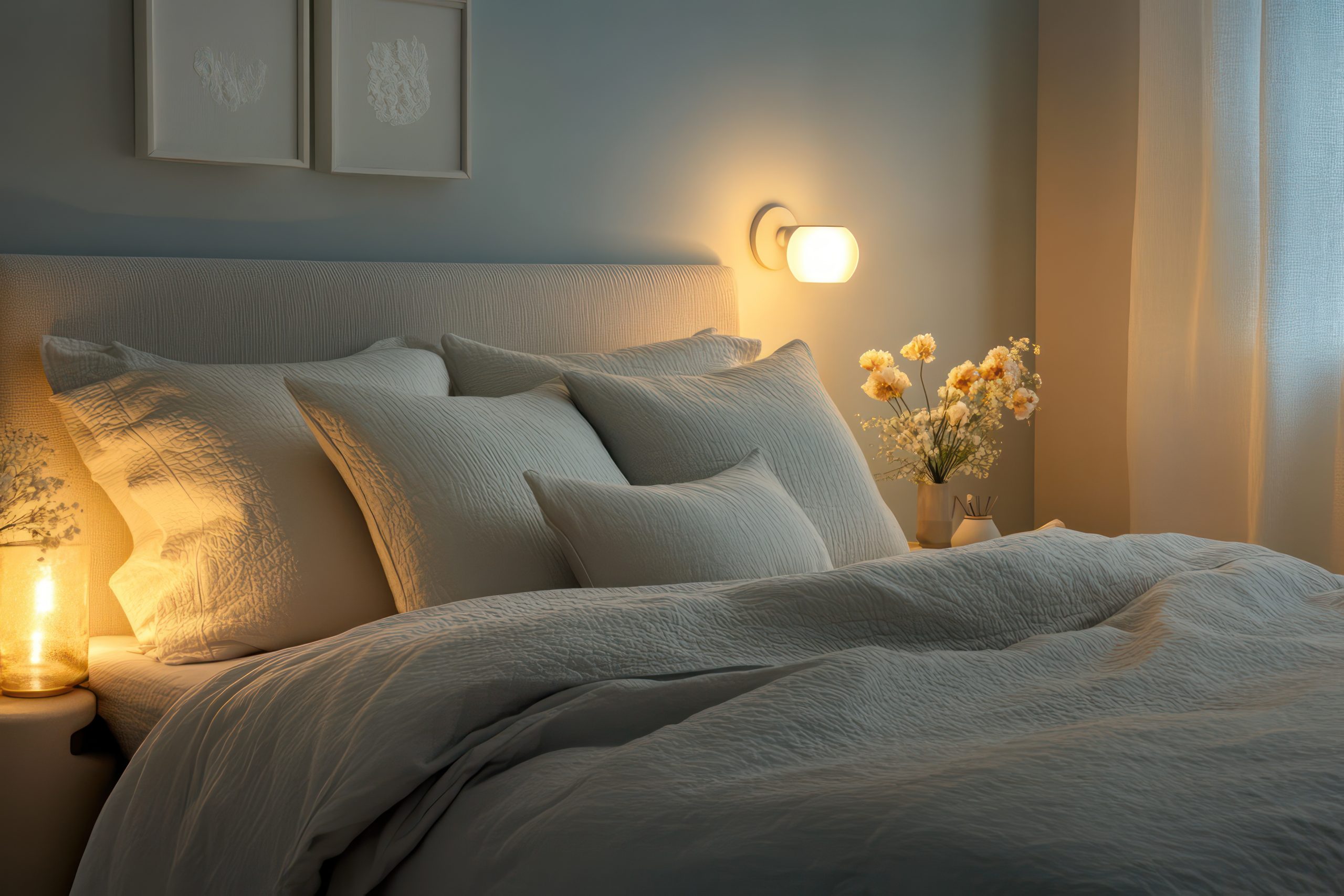
Accessorising with Elegance and Personality
Accessories are the finishing touches that complete your master suite design and infuse it with your personal style. Incorporate artwork, decorative objects, and personal mementos to create a space that feels curated and reflects your individuality. Consider adding a statement mirror, a collection of framed photographs, or a vase of fresh flowers. Choose accessories that complement the overall design aesthetic and add a touch of personality to your master suite design.
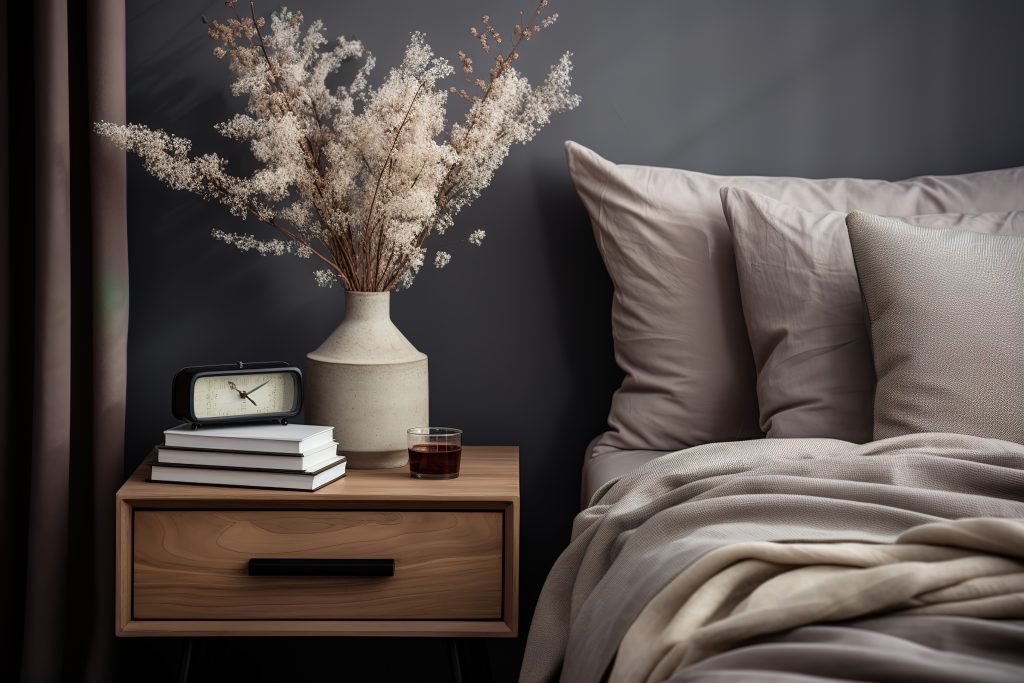
Extending Luxury to the Master Bathroom
Creating a seamless transition from your master suite to the master bathroom is key to achieving a cohesive and luxurious design. Extend the same design principles and colour palette to the bathroom to create a spa-like retreat. Consider incorporating luxurious features like a freestanding soaking tub, a rainfall showerhead, and high-end fixtures. Heated floors, plush towels, and elegant bathrobes can further enhance the luxurious experience within your master suite design.
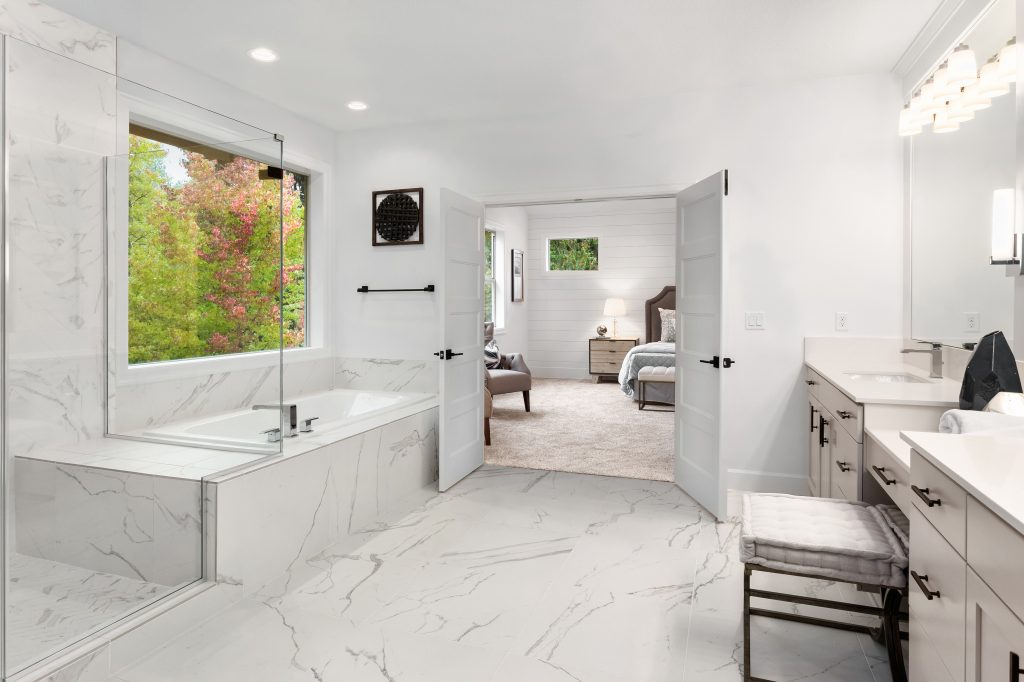
Creating a luxurious master suite design is more than just expensive furnishings; it’s about creating a personalised, comfortable, and indulgent space. By carefully considering the elements discussed in this post – from planning and colour palettes to materials, furniture, lighting, and accessories – you can transform your master suite into a true sanctuary.
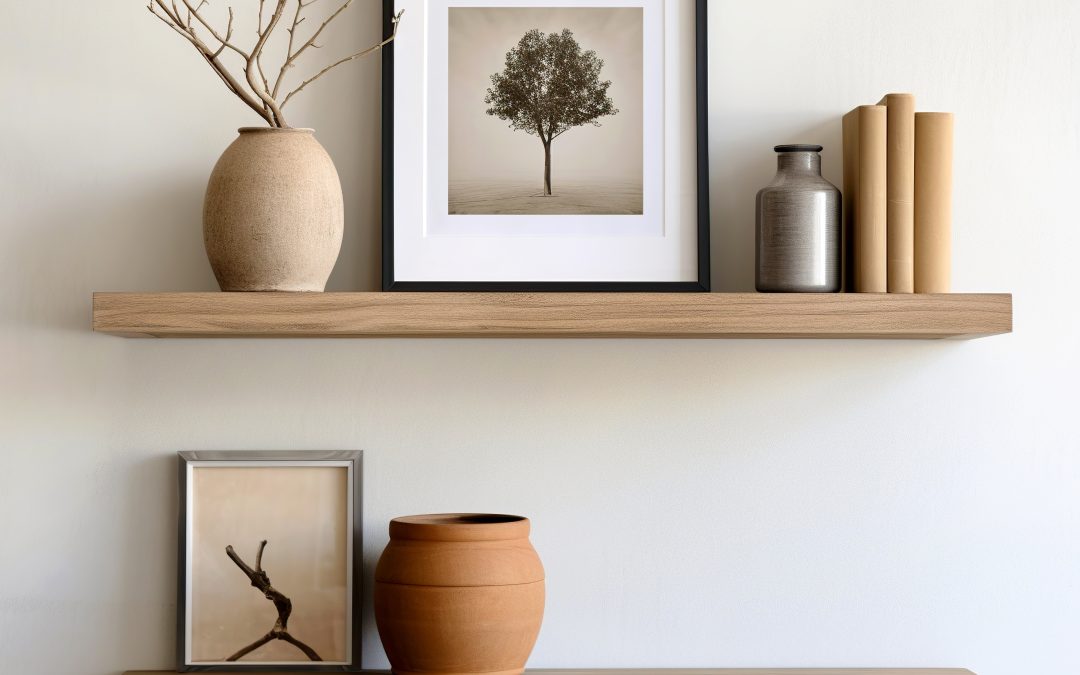
by Kesaa Interiors | DECOR & DIY, DESIGN GUIDES, How-To Guides
Learn how to style your shelf to elevate and transform your space. 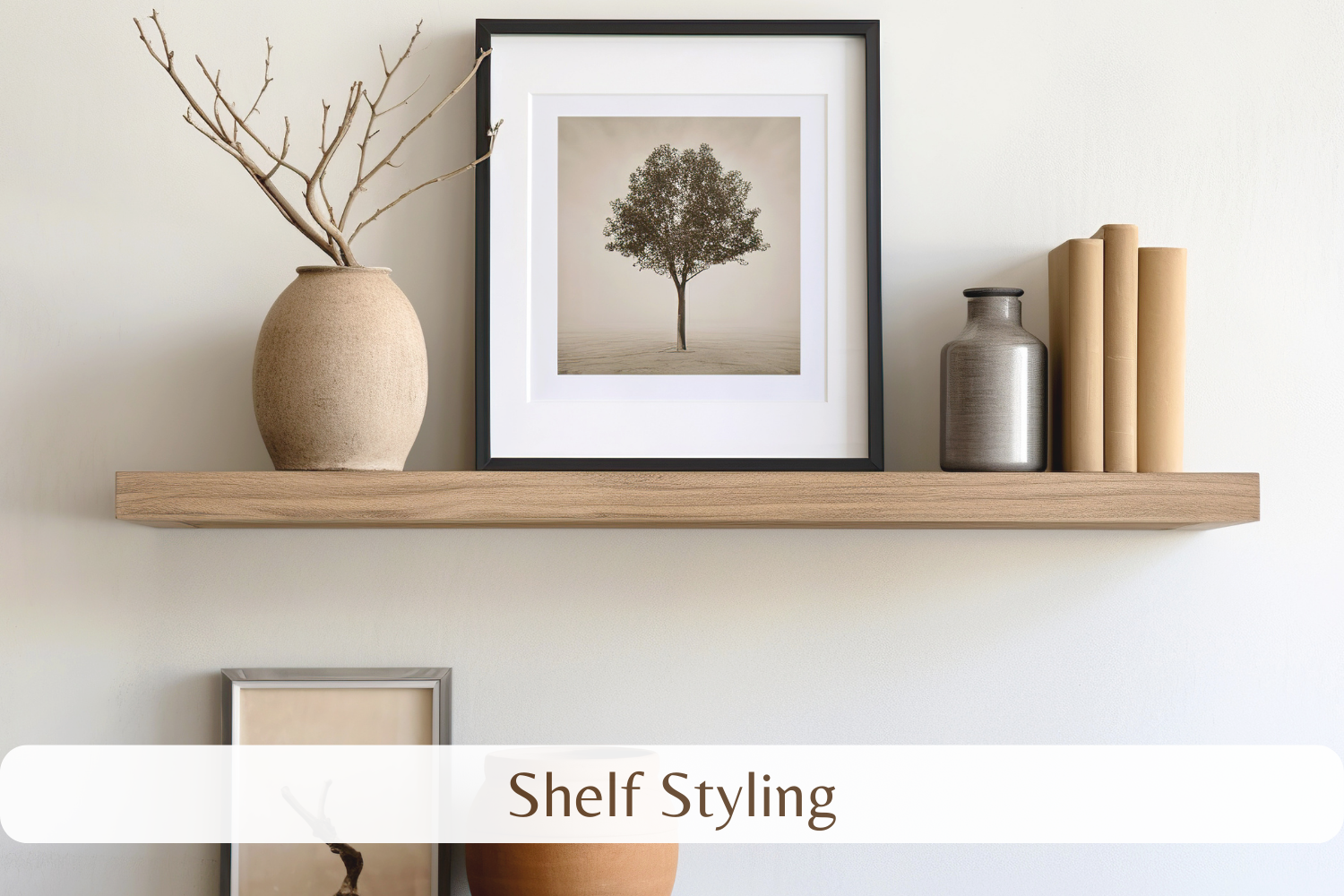
Tired of staring at bare shelves? Shelf styling can dramatically transform a room, taking it from bland to grand. It’s more than just placing objects on a surface; it’s about creating a visual story that reflects your personality and enhances your space.
This guide will equip you with expert shelf styling tips to help you curate stunning displays and elevate your interior design. Get ready to turn those empty shelves into captivating focal points!
Best Shelf Styling Tips and Tricks.
Know Your Canvas: Evaluating Your Shelf Space for Optimal Styling
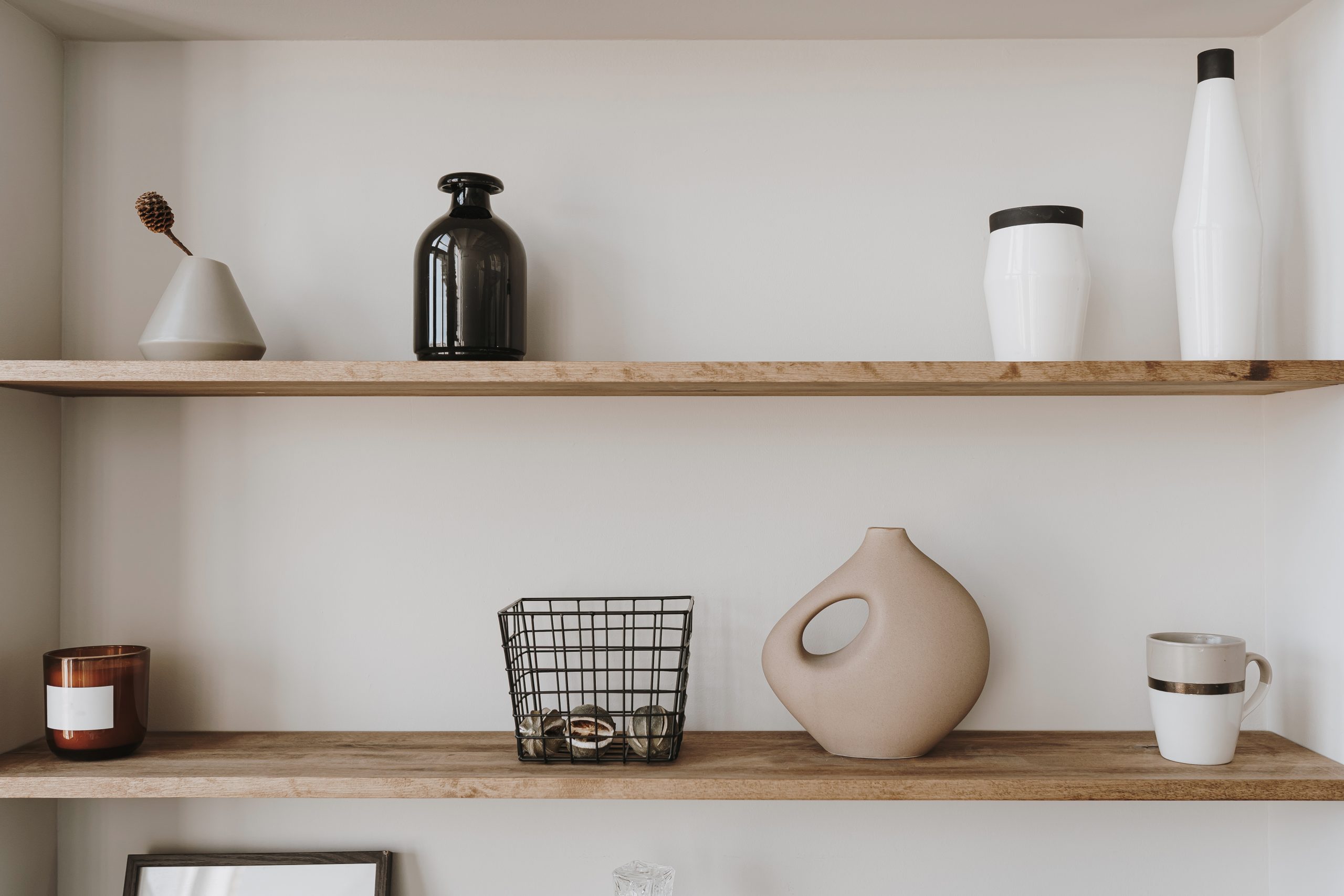
Before diving into the exciting world of shelf styling, take a moment to assess your “canvas.” Understanding your shelf space is crucial for creating a successful display. Effective shelf styling starts with knowing the dimensions and characteristics of your shelves. Consider the following:
- Size and Shape: Are your shelves long and narrow, or short and wide? Are they square, rectangular, or a unique shape? The size and shape will dictate the types and number of items you can display. Large shelves offer more flexibility, while smaller shelves require a more curated approach to shelf styling.
- Depth: How deep are your shelves? This will determine how far forward you can place items and how much layering you can achieve. Deep shelves allow for more dynamic arrangements, while shallow shelves benefit from a more streamlined shelf styling approach.
- Height: Are your shelves tall enough to accommodate larger items, or are they better suited for smaller objects? The height of your shelves will influence the overall visual balance of your shelf styling. Taller shelves can handle taller objects and create a sense of grandeur, while shorter shelves require careful consideration of height variations.
- Location and Surroundings: Where are your shelves located in the room? Are they in a prominent spot or a more secluded corner? Consider the surrounding décor and how your shelf styling can complement the overall aesthetic. Shelf styling should integrate seamlessly with the rest of your room’s design.
By carefully considering these factors, you’ll be well-equipped to make informed decisions about the types of items you choose and how you arrange them. This initial assessment is the foundation for effective shelf styling, ensuring a cohesive and visually appealing display.
Styling with Intention: Defining Your Design Goal
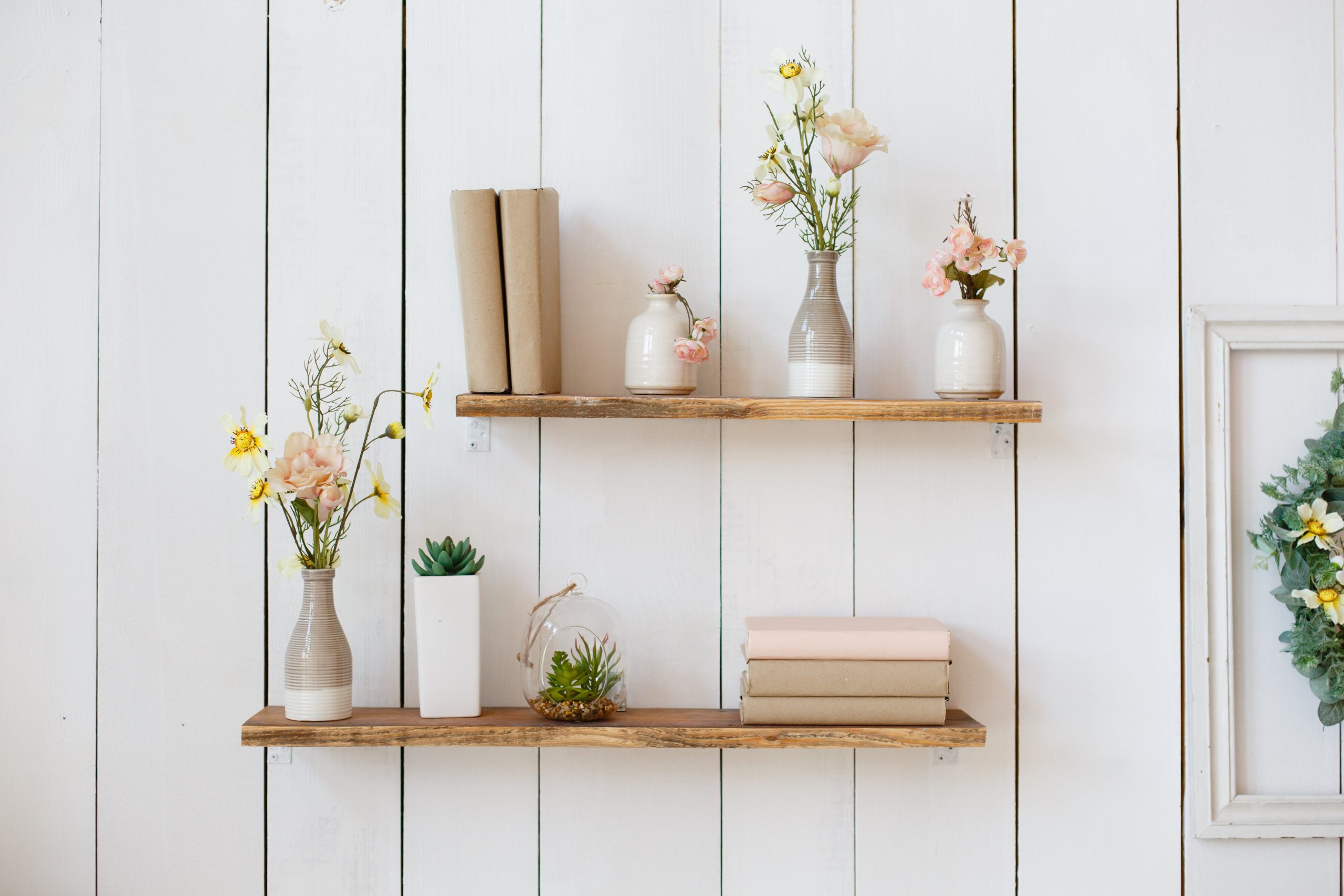
Now that you’ve assessed your shelves, it’s time to define your shelf styling vision. Just like any design project, having a clear goal in mind is essential for achieving a cohesive and impactful result. Shelf styling shouldn’t be a random assortment of objects; it should tell a story and reflect your personal style. Ask yourself:
- What overall mood or atmosphere do I want to create? Do you envision a calming and serene space, a vibrant and energetic display, or a cosy and inviting corner? Your shelf styling should contribute to the overall ambiance of the room.
- What is the existing style of my room? Is it modern, minimalist, bohemian, farmhouse, or eclectic? Your shelf styling should complement the existing décor and enhance the overall aesthetic. Consider the colours, textures, and materials already present in the room. For example, if your room has a minimalist design, your shelf styling should follow suit with clean lines and a limited colour palette.
- What specific style am I aiming for with my shelves? Do you want to create a minimalist display with a few carefully chosen objects, a maximalist arrangement with a curated collection of treasures, or something in between? Defining your shelf styling style will guide your choices and ensure a cohesive look. Some popular shelf styling themes include:
- Minimalist: Clean lines, simple objects, limited colour palette.
- Bohemian: Eclectic mix of textures, patterns, and global influences.
- Maximalist: Layered and abundant displays, showcasing collections and personal items.
- Rustic: Natural materials, earthy tones, vintage or antique accents.
- Modern: Sleek and contemporary, with a focus on geometric shapes and bold colors.
By defining your shelf styling vision, you’ll create a roadmap for your project. This will help you choose the right items and arrange them in a way that reflects your personal style and enhances your space. Effective shelf styling is about creating a cohesive and intentional display that adds personality and visual interest to your room.
The Art of Curation: Selecting Items that Tell a Story
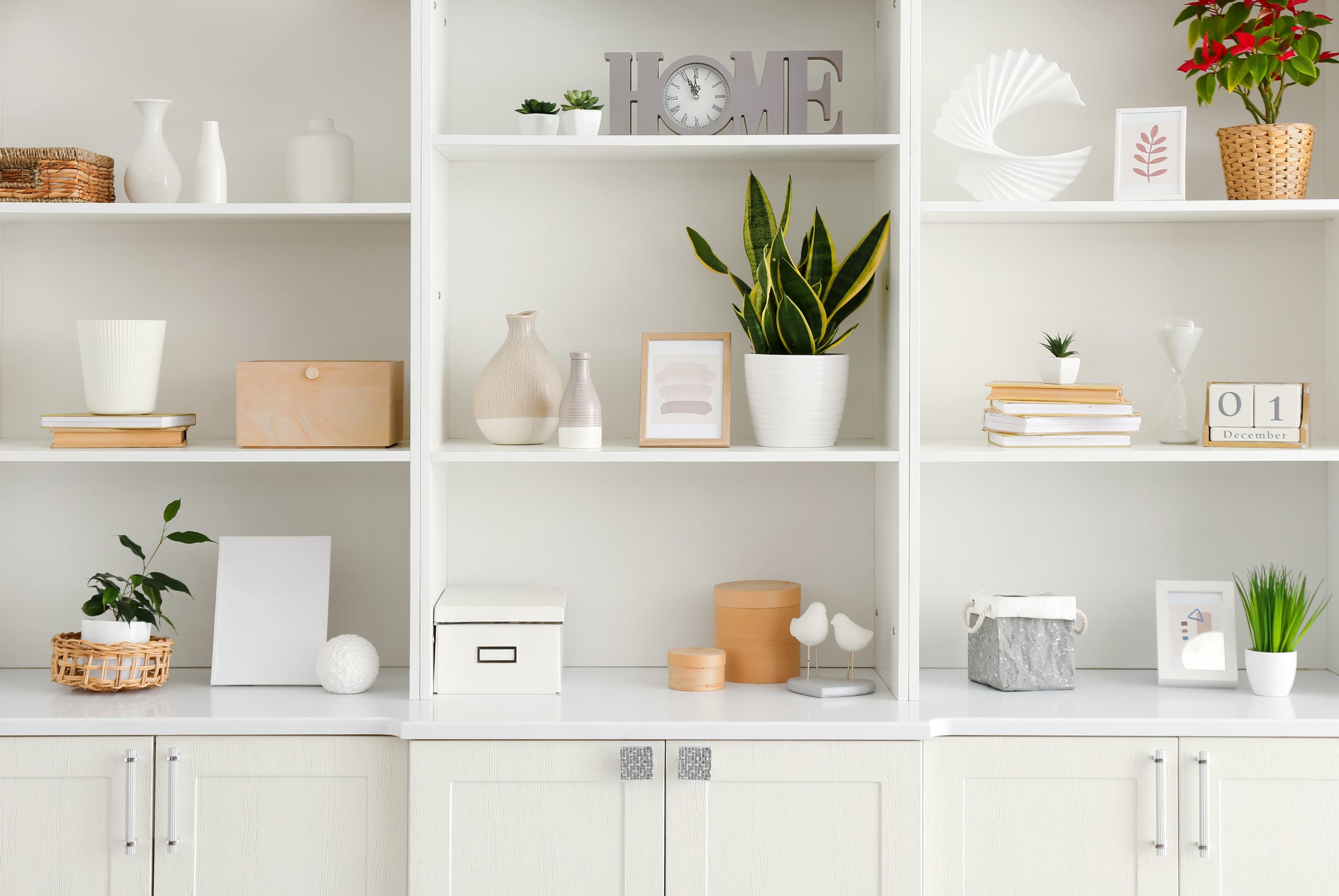
With your shelf styling vision in mind, it’s time to gather the items that will bring your shelves to life. This is where the fun begins! Curation is key to successful shelf styling. It’s not about randomly placing objects on a shelf; it’s about carefully selecting items that reflect your personality, interests, and style. Think of your shelves as a mini-gallery where you can showcase your favorite treasures and create a visual narrative.
Consider incorporating a variety of items to add depth and interest to your shelf styling:
- Books: Books are a staple in shelf styling. They add height, texture, and personality. Arrange them both vertically and horizontally to create visual interest. Choose books with covers that complement your color scheme or showcase your interests. Don’t be afraid to use books as decorative elements, even if you haven’t read them all!
- Decorative Objects: Vases, sculptures, bowls, candlesticks, and other decorative objects can add personality and visual appeal to your shelves. Choose items that complement your chosen style and colour palette. Look for unique pieces that spark joy and tell a story.
- Plants: Greenery adds life and vibrancy to any space, including your shelves. Incorporate small potted plants, trailing vines, or dried botanicals to add a touch of nature. Choose plants that thrive in the lighting conditions of your shelves.
- Personal Mementos: Shelf styling is a great opportunity to display cherished mementos and travel souvenirs. These items add a personal touch and tell a story about your life and experiences. Frame photos, display travel trinkets, or showcase handmade items.
- Art and Prints: Framed art prints, photographs, or even small canvases can add a pop of color and personality to your shelves. Choose pieces that complement your overall style and colour scheme.
Remember, thoughtful curation is key to successful shelf styling. Don’t be afraid to experiment with different combinations of items until you find an arrangement that you love. The goal is to create a display that reflects your unique style and enhances your space.
Texture Play: Incorporating a Variety of Materials for Visual Interest
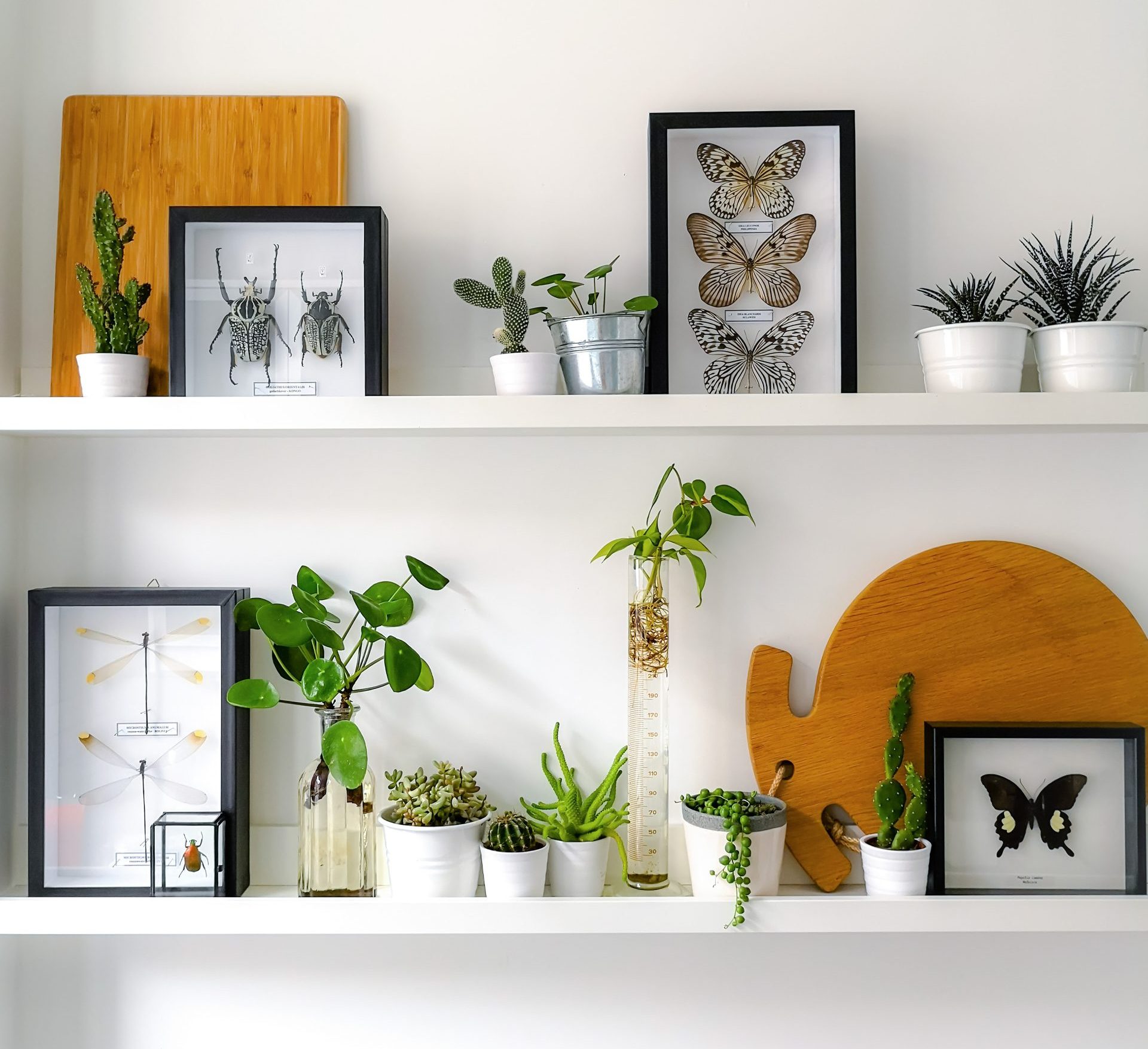
Once you’ve gathered your shelf styling treasures, it’s time to start thinking about how to arrange them. One of the key elements of successful shelf styling is incorporating a variety of textures and materials. This adds depth, dimension, and visual interest to your shelves, preventing them from looking flat or one-dimensional.
Consider the following textures and materials when styling your shelves:
- Wood: Wood adds warmth and natural beauty to your shelves. Incorporate wooden boxes, trays, bowls, or sculptures. Different types of wood, such as light oak, dark walnut, or rustic reclaimed wood, can create different moods and styles.
- Metal: Metallics add a touch of glamour and shine. Incorporate brass, copper, silver, or gold accents through candle holders, frames, or decorative objects. Metallics can also create a modern or industrial feel.
- Ceramic: Ceramic pieces, such as vases, bowls, or figurines, add a touch of artistry and craftsmanship. Consider using ceramics with different glazes and finishes to add variety.
- Glass: Glass adds a touch of elegance and reflectivity. Incorporate glass vases, jars, or decorative objects. Clear glass can create a sense of airiness, while colored glass can add a pop of color.
- Textiles: Textiles add softness and warmth. Incorporate woven baskets, small rugs, or decorative pillows. Textiles can also add pattern and colour to your shelves.
- Natural Elements: Incorporate natural elements such as shells, stones, or driftwood to add an organic touch. These elements can create a calming and grounding effect.
By mixing and matching different textures and materials, you’ll create a visually dynamic and engaging display. Don’t be afraid to experiment with different combinations until you find a balance that you love. Effective shelf styling is about creating a layered and textured look that draws the eye and adds personality to your space. Remember, the goal is to enhance your shelf styling by creating a visually rich and tactile experience.
Size Matters: Creating Visual Dynamics with Varying Heights and Scales
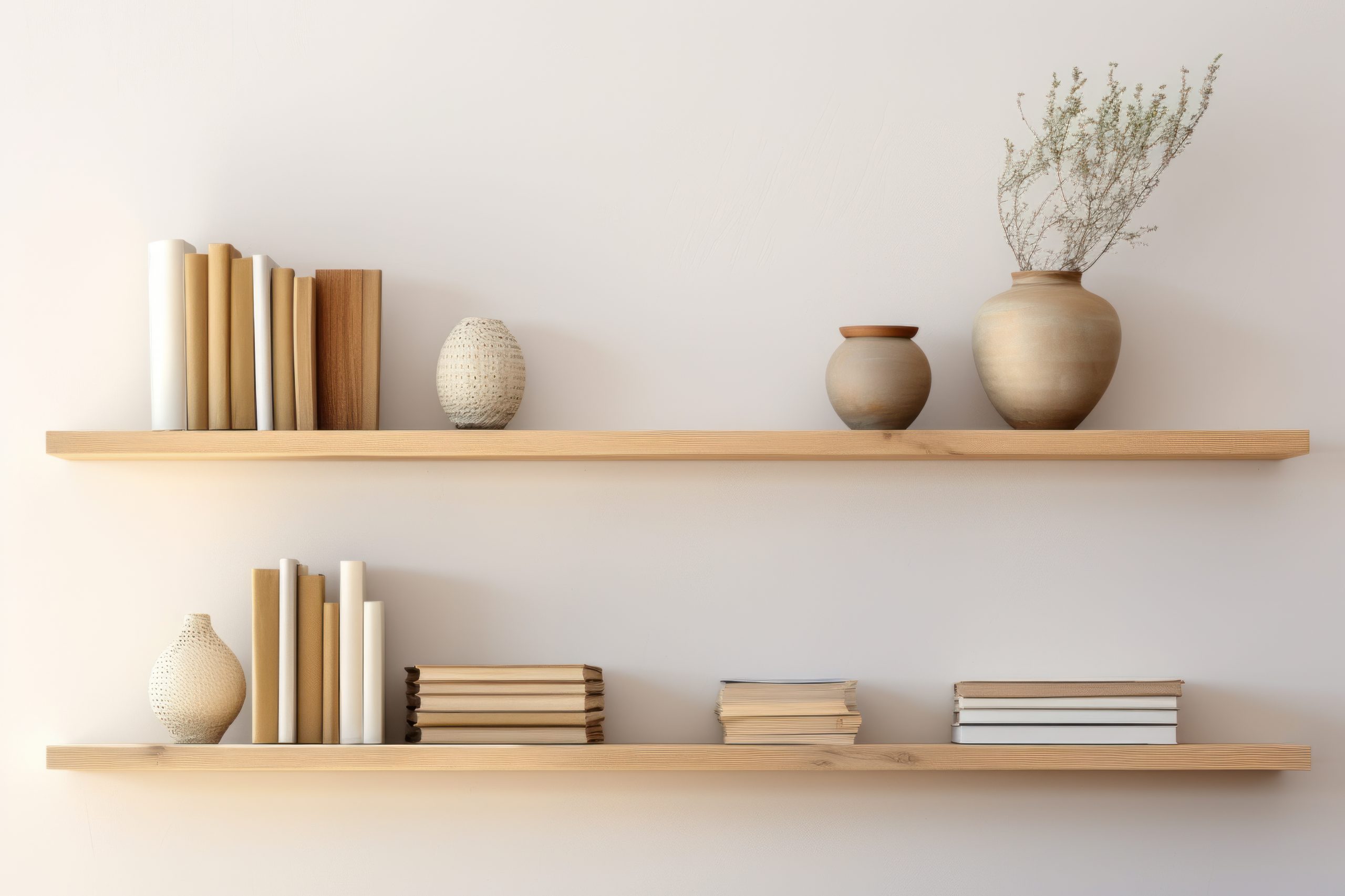
Varying the heights and sizes of your objects is another crucial element of successful shelf styling. A monotonous display of similarly sized items can look static and uninteresting. By incorporating objects of different heights and scales, you create visual interest, depth, and a sense of movement. Here’s how to play with heights and sizes for impactful shelf styling:
- Stacking: Stack books both vertically and horizontally to create different levels and add height. You can also stack boxes or other decorative objects to achieve a similar effect. Stacking adds visual weight and creates a sense of stability.
- Using Risers: Use books, boxes, or small stands as risers to elevate smaller objects and create varying heights. This allows smaller items to be seen and prevents them from getting lost among larger items. Risers also add depth and dimension to your shelf styling.
- Visual Triangles: Imagine drawing invisible triangles connecting the tallest items on your shelves. This technique, known as creating visual triangles, helps to guide the eye and create a sense of balance and harmony. Vary the heights of the triangle peaks to keep the display dynamic.
- Layering: Place smaller items in front of larger ones to create depth and layers. This prevents the display from looking flat and adds visual interest. Layering also allows you to showcase a greater number of items without overcrowding the shelves.
- Balancing Act: Avoid placing all the tall items on one side and all the short items on the other. Distribute heights and sizes evenly across your shelves to create visual balance. This prevents the display from feeling lopsided or unbalanced.
By playing with heights and sizes, you can transform your shelves from static displays into dynamic and engaging focal points. This technique adds visual interest, depth, and a sense of movement to your shelf styling, making it more appealing and captivating. Remember, effective shelf styling is about creating a visually balanced and harmonious display that draws the eye and enhances your space.
Styling Secrets: Techniques to Transform Your Shelves
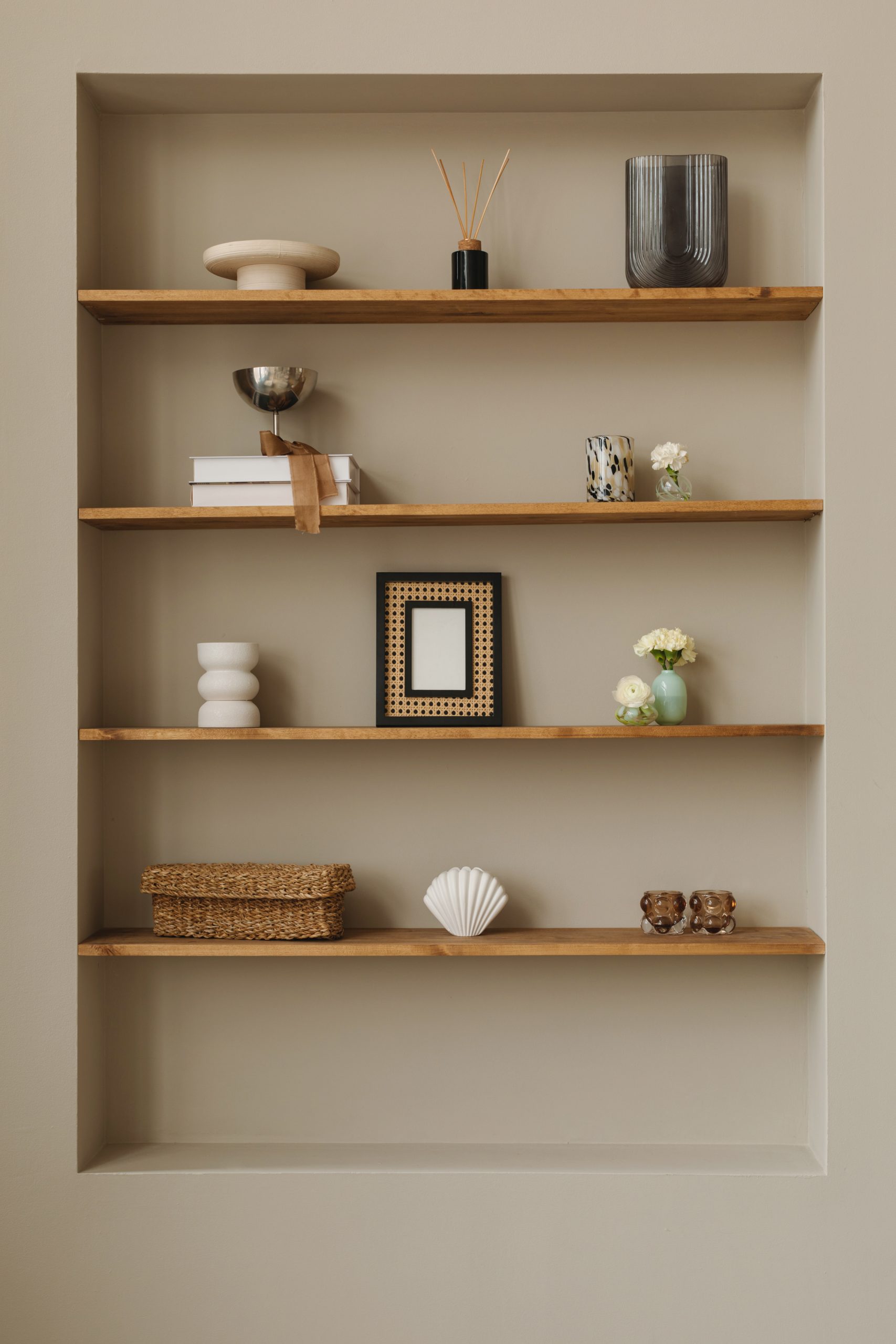
Now that you understand the importance of texture, height, and scale, let’s delve into some specific styling techniques that will bring your shelves to life. These shelf styling tips will help you arrange your curated collection in a way that is both visually appealing and reflects your personal style.
- The Rule of Thirds: Just like in photography, the rule of thirds can be applied to shelf styling. Imagine dividing your shelf into thirds both horizontally and vertically. Placing objects at the intersection of these lines creates a more visually appealing and balanced arrangement. This technique helps to avoid placing items directly in the center, which can look static.
- Visual Balance: Strive for visual balance by distributing visual weight evenly across your shelves. Balance can be achieved through symmetry, asymmetry, or radial balance. Symmetrical arrangements create a formal and traditional look, while asymmetrical arrangements are more dynamic and modern. Radial balance involves arranging items around a central point.
- Creating Depth and Layers: Layering objects adds depth and dimension to your shelves. Place smaller items in front of larger ones, and use books or boxes to create different levels. This technique prevents the display from looking flat and adds visual interest. Layering also allows you to showcase a greater number of items without overcrowding the shelves.
- Incorporating Greenery: Plants add life and vibrancy to any space, including your shelves. Incorporate small potted plants, trailing vines, or dried botanicals to add a touch of nature and freshness. Choose plants that thrive in the lighting conditions of your shelves and complement your overall style. Greenery softens the hard lines of shelves and adds a touch of organic beauty.
- Negative Space: Don’t be afraid to leave some empty space on your shelves. Negative space, also known as white space, is just as important as the objects themselves. It allows the eye to rest and prevents the display from looking cluttered. Negative space gives your curated items room to breathe and stand out.
By implementing these shelf styling techniques, you can create a display that is both visually appealing and reflects your personal style. Remember, shelf styling is an art form, so don’t be afraid to experiment and have fun with it! These techniques will help you achieve a polished and professional look, transforming your shelves into captivating focal points.
Styling Slip-Ups: Common Mistakes to Avoid
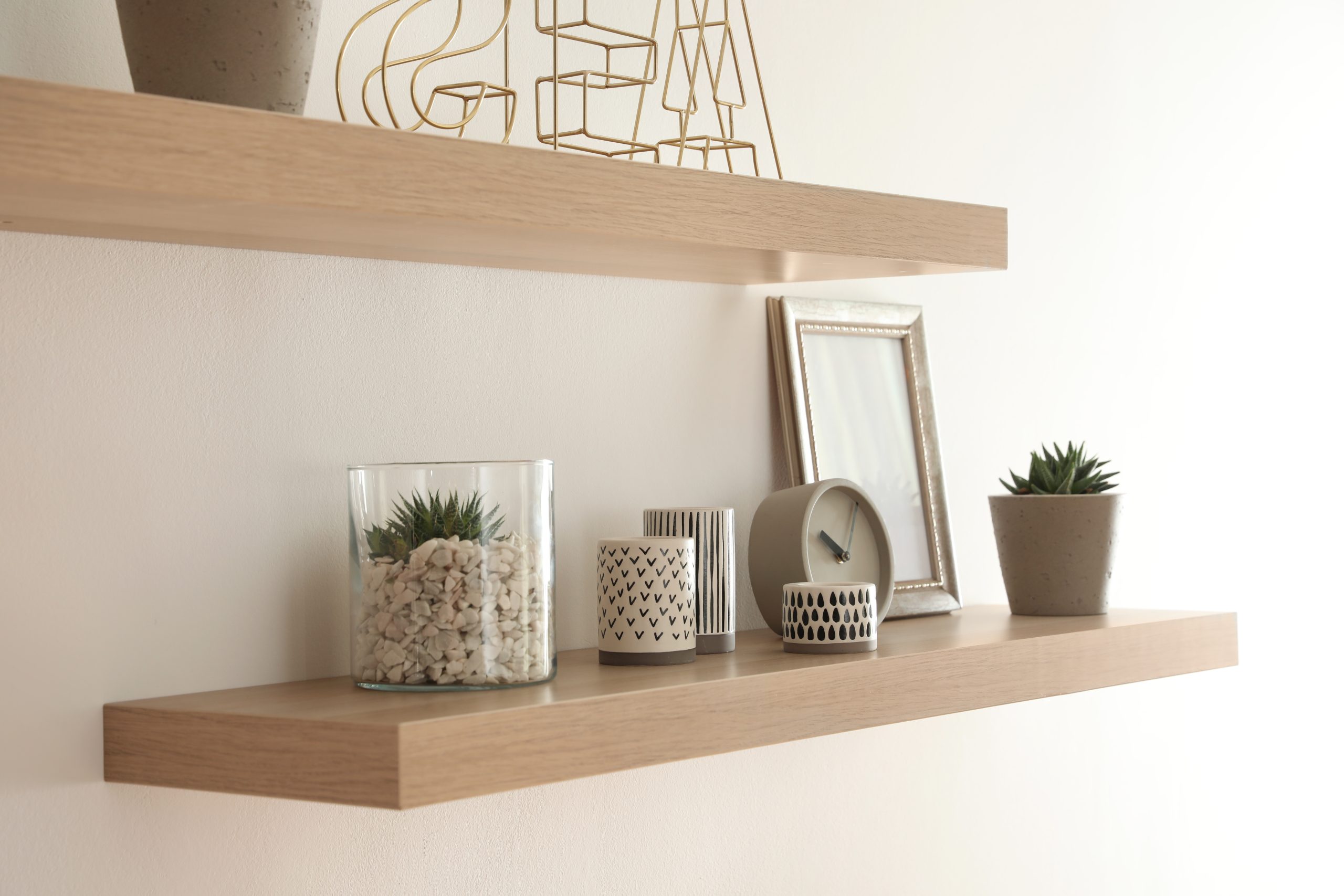
Even with the best intentions, it’s easy to make a few missteps when styling shelves. Being aware of these common shelf styling mistakes can help you avoid them and create a more polished and professional-looking display. Here are some pitfalls to watch out for:
- Overcrowding: One of the most common shelf styling mistakes is overcrowding. Too many items crammed onto a shelf can create a cluttered and chaotic look. Remember the importance of negative space. Give your objects room to breathe and allow the eye to rest. Edit ruthlessly and prioritise quality over quantity. A few well-chosen items will have a greater impact than a cluttered mess.
- Neglecting the Back of the Shelf: The back of the shelf is often overlooked, but it’s a valuable opportunity to add depth and visual interest. Consider painting the back of the shelf a contrasting colour, adding wallpaper, or using a mirrored back to create an illusion of depth. This simple step can elevate your shelf styling and make it more visually appealing.
- Lack of Cohesion and Theme: A cohesive look is essential for successful shelf styling. Avoid randomly placing items on the shelf without any thought to their relationship to each other. Choose a theme or colour palette to tie the items together and create a sense of unity. This could be a specific style, such as minimalist or bohemian, or a colour scheme that complements the room’s décor.
- Ignoring Scale and Proportion: Using items that are all the same size and scale can create a monotonous and uninteresting display. Vary the heights and sizes of your objects to create visual interest and depth. Use the visual triangle technique and incorporate risers to elevate smaller items.
- Forgetting Functionality: While aesthetics are important, don’t forget about functionality. If you’re styling shelves in a high-traffic area, make sure the items are arranged in a way that is practical and accessible. Avoid placing fragile items in unstable positions.
By avoiding these common shelf styling mistakes, you can create a display that is both beautiful and functional. Remember, shelf styling is about creating a cohesive and visually appealing arrangement that enhances your space and reflects your personal style. Avoiding these pitfalls will help you achieve a polished and professional look.
Style Showcase: Bringing Your Shelf Styling Vision to Reality
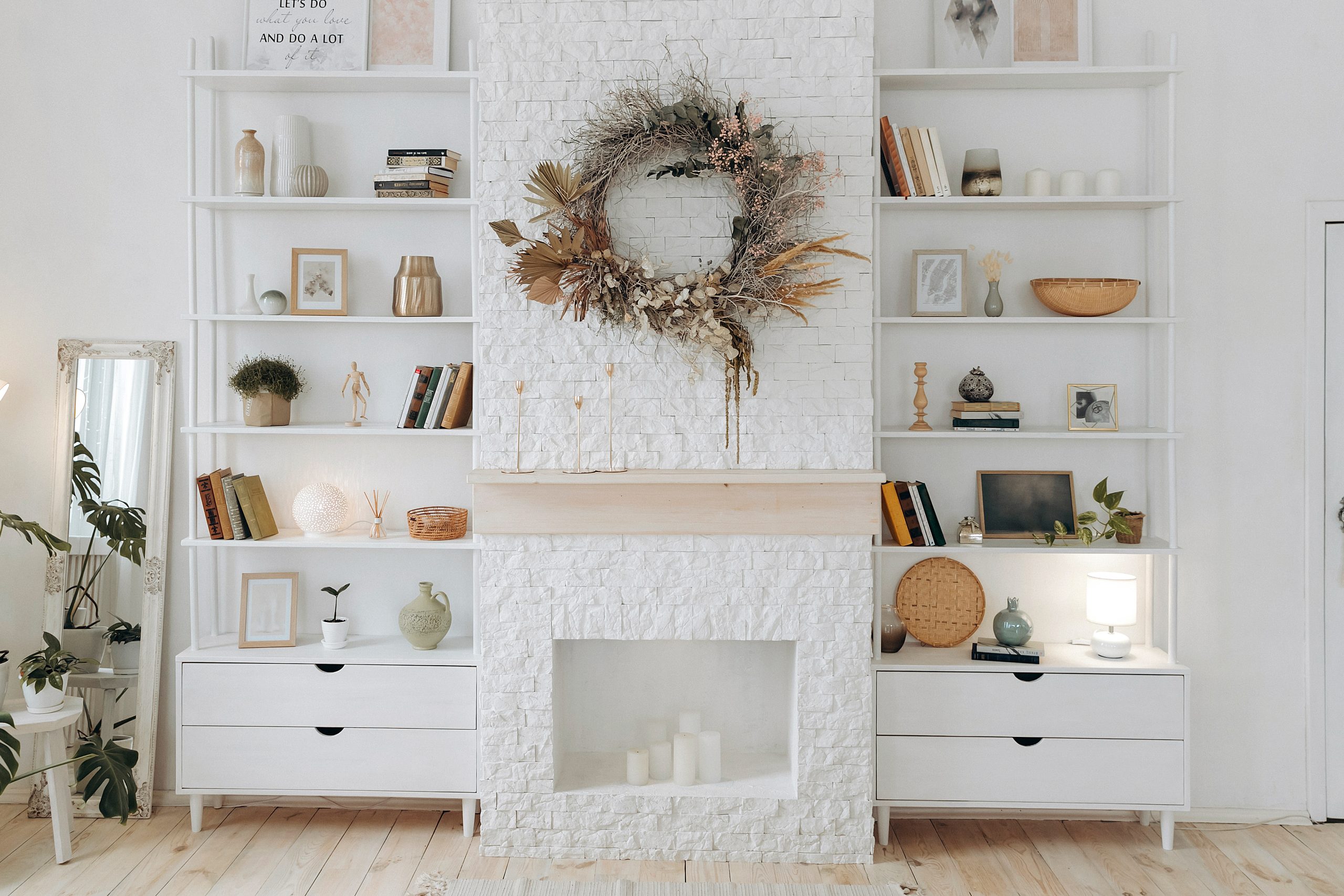
You’ve assessed your shelves, defined your vision, curated your collection, mastered styling techniques, and learned to avoid common mistakes. Now it’s time to put it all together and create a shelf styling masterpiece that truly reflects your personal style. This is where your creativity shines!
Here’s a recap of the key elements to keep in mind as you bring your shelf styling vision to reality:
- Balance: Strive for visual balance by distributing visual weight evenly across your shelves. Use the rule of thirds and visual triangle techniques to achieve a harmonious arrangement.
- Variety: Incorporate a variety of textures, materials, heights, and sizes to create a dynamic and visually interesting display. Mix and match different elements to add depth and dimension.
- Cohesion: Choose a theme or colour palette to tie the items together and create a sense of unity. This will ensure that your shelves look cohesive and intentional, rather than random and cluttered.
- Personality: Don’t be afraid to inject your personality into your shelf styling. Display items that you love and that tell a story about you. This is your chance to showcase your unique style and create a space that truly feels like home.
- Experimentation: Shelf styling is an art form, so don’t be afraid to experiment and have fun with it! Try different arrangements, move things around, and see what works best for you. There’s no right or wrong way to style a shelf, as long as you love the result.
With these expert shelf styling tips, you’re well-equipped to transform your shelves into stunning focal points. Remember, shelf styling is an ongoing process. As your style evolves and you acquire new treasures, don’t be afraid to refresh your shelves and create new displays. Embrace the opportunity to express your creativity and make your space truly your own.
Transforming your living space with stylish shelves is an achievable goal with the right guidance. From assessing your shelf space and curating a captivating collection to mastering styling techniques and avoiding common pitfalls, you now possess the knowledge to elevate your home décor. Remember, shelf styling is more than just placing objects on a surface; it’s an opportunity to express your personality, tell your story, and create a visually stunning focal point.
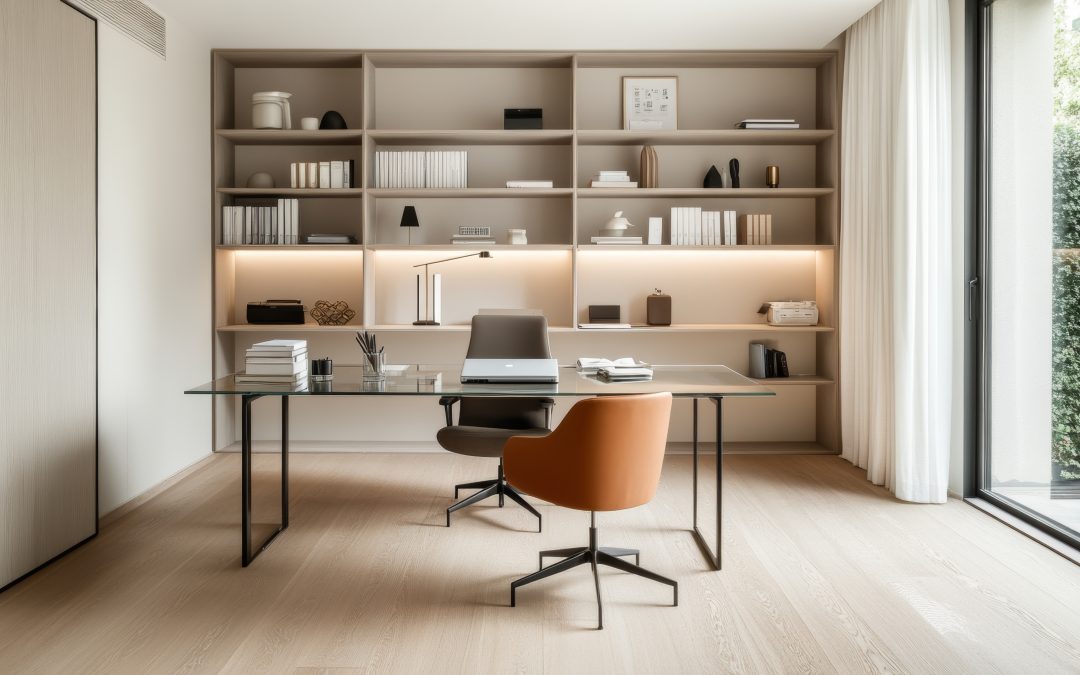
by Kesaa Interiors | DESIGN GUIDES, Home Office, How-To Guides, ROOMS
Want to know how the create the perfect productive home office? Read along for the best tips and tricks!
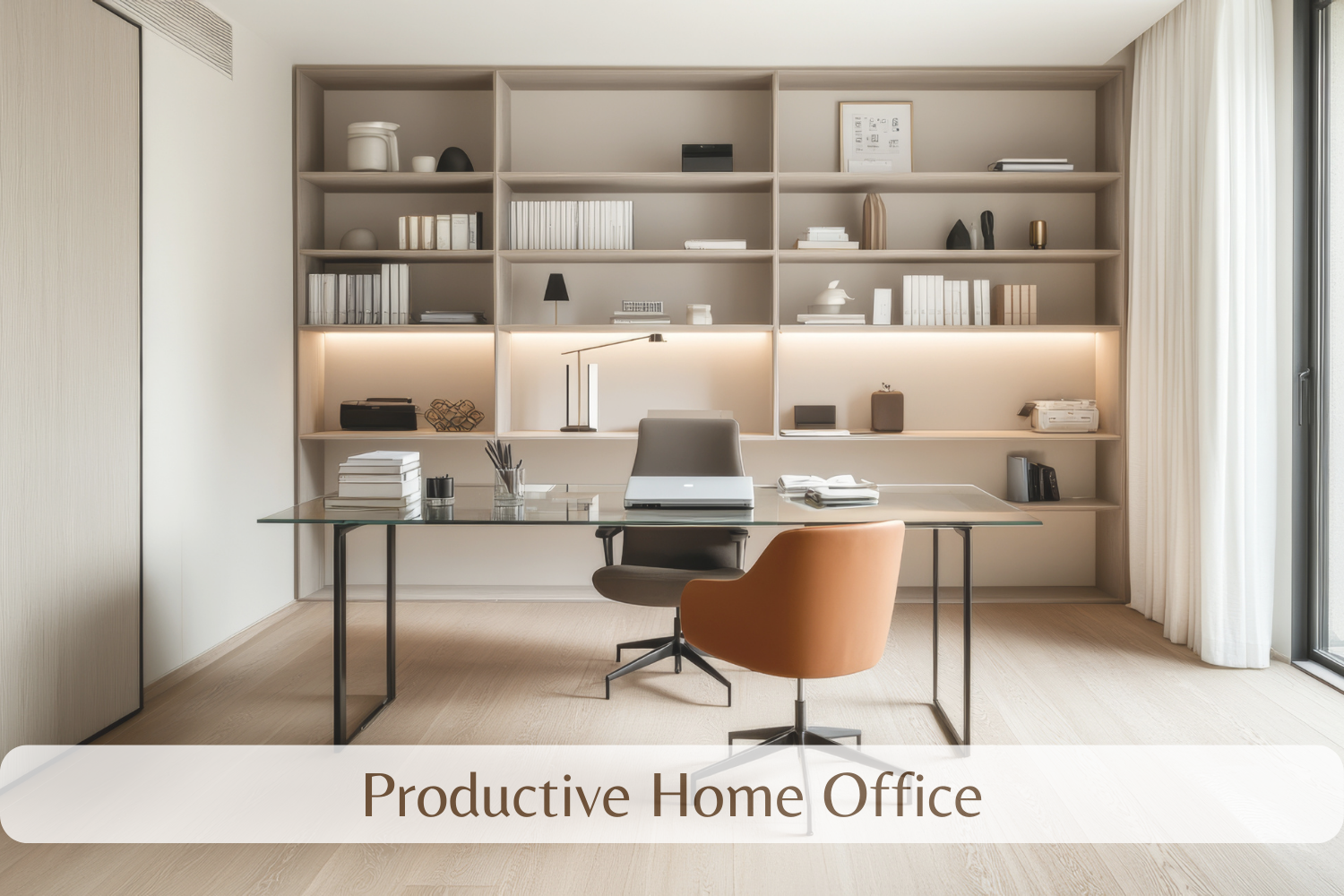
Working from home offers flexibility, but a poorly designed workspace can quickly kill productivity. Creating a productive home office requires more than just slapping a desk in a spare room.
This post delves into proven expert strategies to optimise your home office for focus, efficiency, and overall well-being. Whether you’re a seasoned remote worker or new to the home office scene, these insights will help you transform your space into a hub of productivity and comfort.
Best Productive Home Office Tips.
Assessing Your Needs for a Productive Home Office
Before diving into the world of office furniture and gadgets, it’s crucial to start by realistically assessing the available space in your home. A lack of spatial awareness can significantly hinder the development of your potential in a productive home office. Understanding the dimensions and limitations of your space will guide you in making informed decisions that enhance productivity rather than detract from it.
Begin by asking yourself some essential questions: How much space do you realistically need? Can you dedicate an entire room, or will you need to carve out a section of a shared space? Assessing the room’s shape and identifying any limitations will help you navigate challenges and create a more productive home office. For instance, if your space is narrow, consider vertical storage solutions to maximise efficiency. By thoughtfully evaluating your space, you can lay the foundation for a home office that supports your work habits and boosts your productivity.
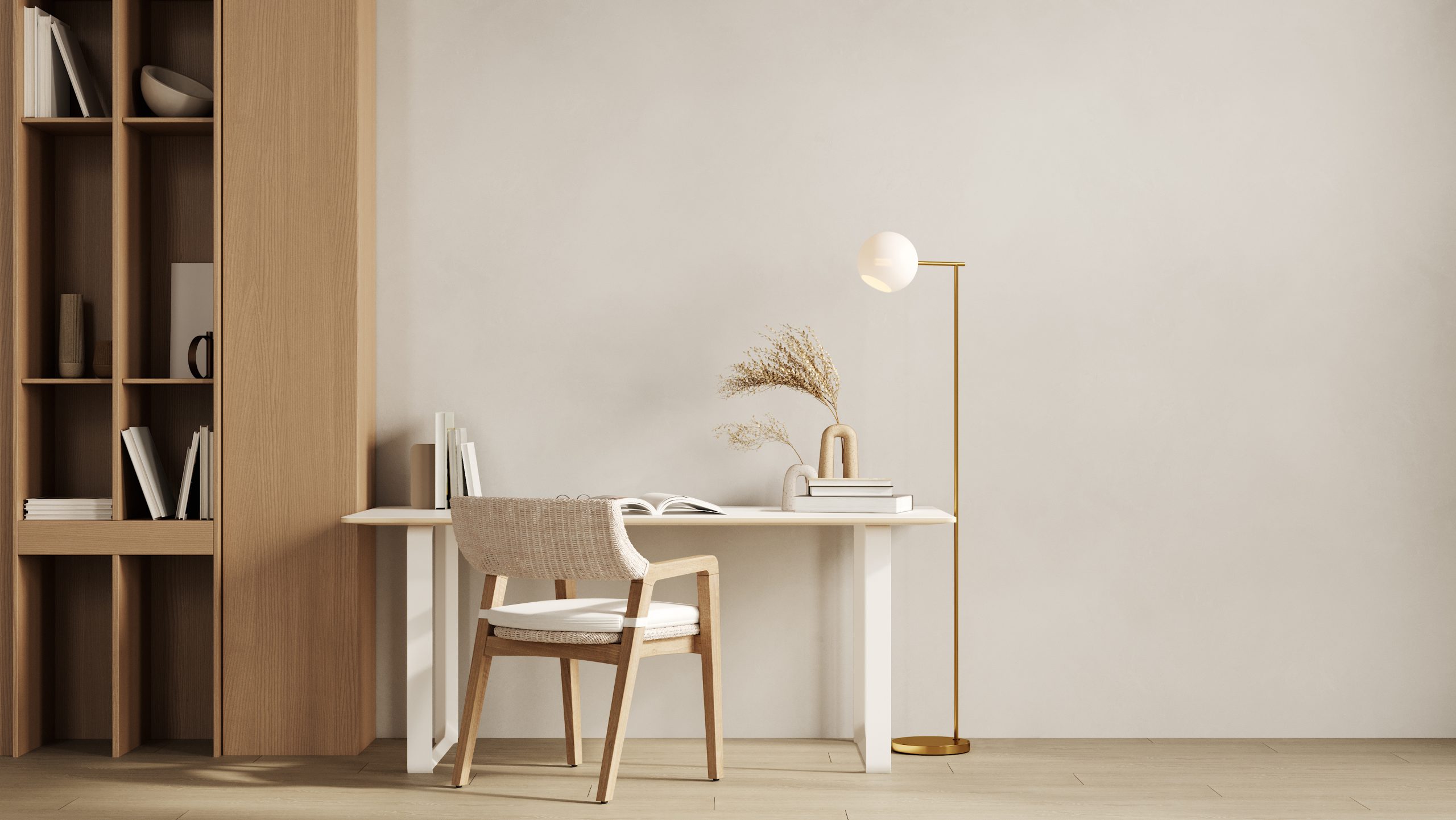
Harnessing Natural Light
Natural light is a powerful ally in creating a productive home office. Research has shown that exposure to natural light can significantly enhance mood, focus, and overall well-being. A workspace bathed in natural light not only feels more inviting but also helps reduce eye strain and fatigue, making it easier to maintain concentration throughout the day. Conversely, a lack of natural light can diminish the potential of your productive home office, leading to a less energised and more lethargic work environment.
To maximise natural light access, consider the placement of your desk and other key elements in your office. Position your workspace near windows to take full advantage of daylight. Use light, airy window treatments that allow sunlight to filter through while minimising glare. Additionally, choose paint colours and furnishings that reflect light, such as whites and light pastels, to brighten the space. If natural light is limited, consider incorporating smart additions like mirrors to reflect light or using full-spectrum white lights to mimic daylight. These strategies can help you achieve optimal lighting conditions, enhancing the productivity and ambience of your home office.
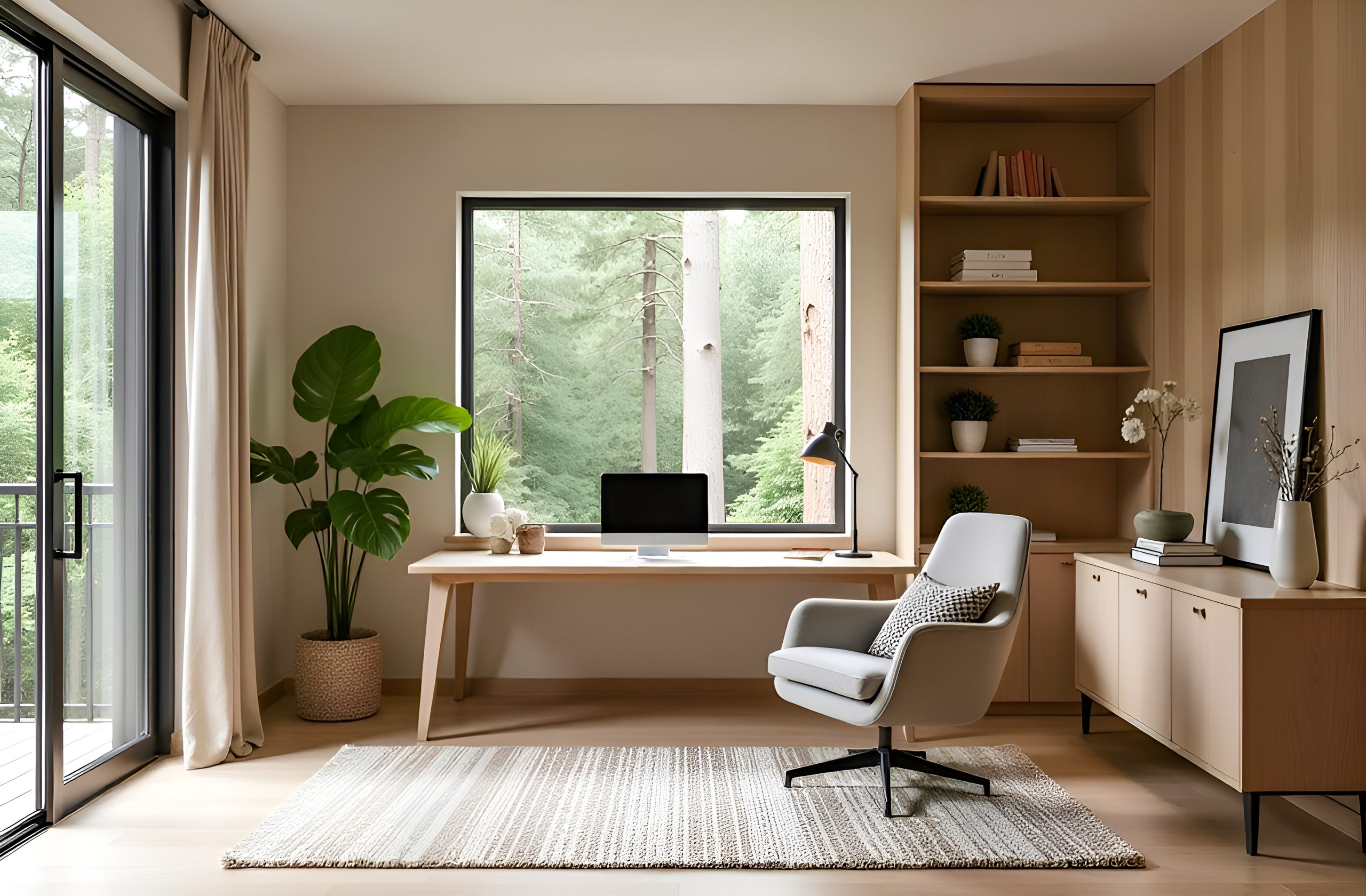
Choosing the Right Chair
A good chair is more than just a piece of furniture; it’s a critical component of a productive home office. The right chair supports your body, enhances comfort, and helps prevent long-term health problems such as back pain and poor posture. Ergonomic issues can significantly hinder the development of a positive and efficient workspace, making it essential to invest in a chair that meets your needs.
When selecting an ergonomic chair, look for key features that promote comfort and support. Adjustable lumbar support is crucial for maintaining the natural curve of your spine, while armrests can help reduce strain on your shoulders and neck. The ability to adjust seat height ensures that your feet rest flat on the floor, promoting better circulation and posture. Consider reputable brands known for their ergonomic designs, as these often offer high-quality options that can optimise your productive home office. By prioritising ergonomics, you create a workspace that not only supports your physical health but also enhances your ability to focus and perform at your best.
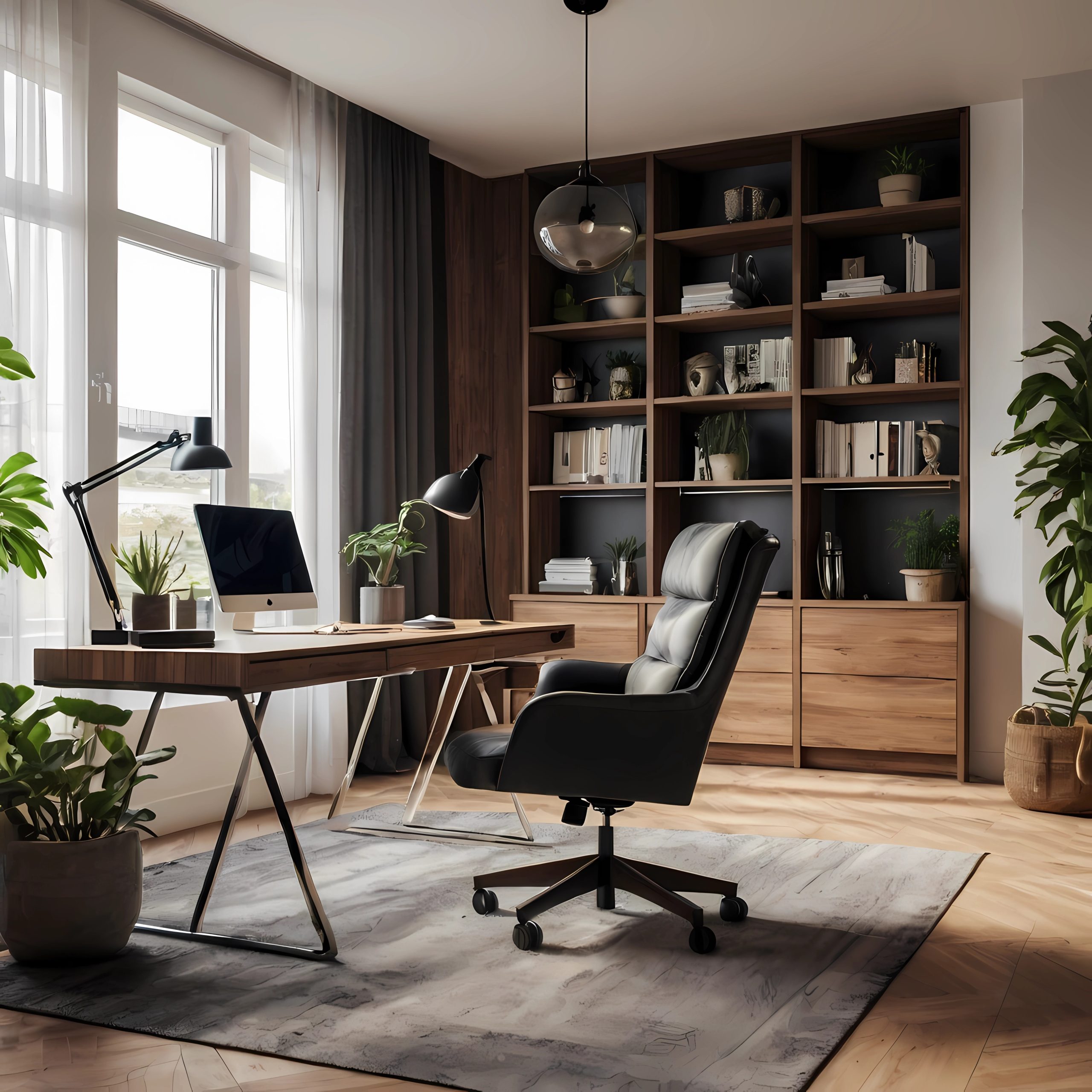
Proper Monitor Placement
Proper monitor placement is essential for preventing eye strain, neck pain, and poor posture, all of which can detract from the productivity of your home office. When your monitor is positioned correctly, it helps maintain a comfortable and healthy posture, allowing you to work more efficiently and with less discomfort. Poor posture and improper monitor placement can create a negative atmosphere in your workspace, undermining the potential of your productive home office.
To ensure optimal monitor placement, follow these recommendations: Position the top of your monitor at or slightly below eye level, so you can view the screen without tilting your head. The monitor should be about arm’s length away from your eyes, reducing the need to squint or lean forward. Additionally, angle the monitor to minimise glare from windows or overhead lighting. Consider using monitor stands or adjustable arms to achieve the ideal height and angle. By taking these steps, you create an environment that supports your vision and comfort, enhancing your productivity and focus.
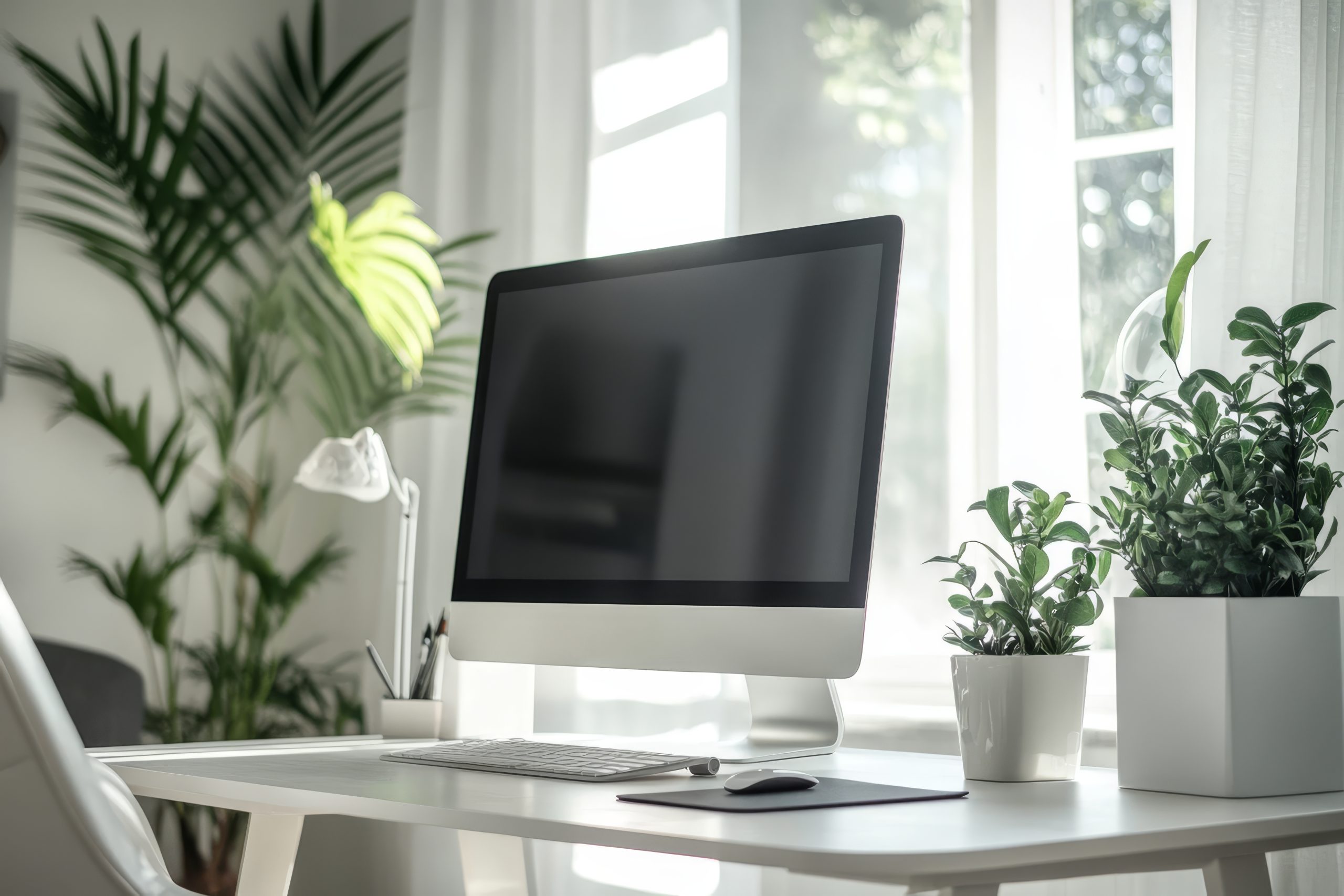
Reducing Visual Clutter
Visual clutter can have a profound impact on your ability to focus and maintain mental clarity. The adage “a cluttered desk equals a cluttered mind” holds true, as a disorganised workspace can lead to increased stress and decreased productivity. In a productive home office, it’s essential to keep your environment tidy and organised to foster a sense of calm and concentration.
To eliminate visual clutter, start by decluttering your workspace. Remove unnecessary items and keep only the essentials within reach. Implement effective file management systems to organise documents and reduce paper piles. Cable organisation is also crucial; use cable ties or sleeves to keep cords neatly arranged and out of sight. Additionally, consider digital file management to keep your computer desktop as organised as your physical one. By maintaining a clean and orderly workspace, you create a positive functional, productive home office that supports your mental well-being and work efficiency.
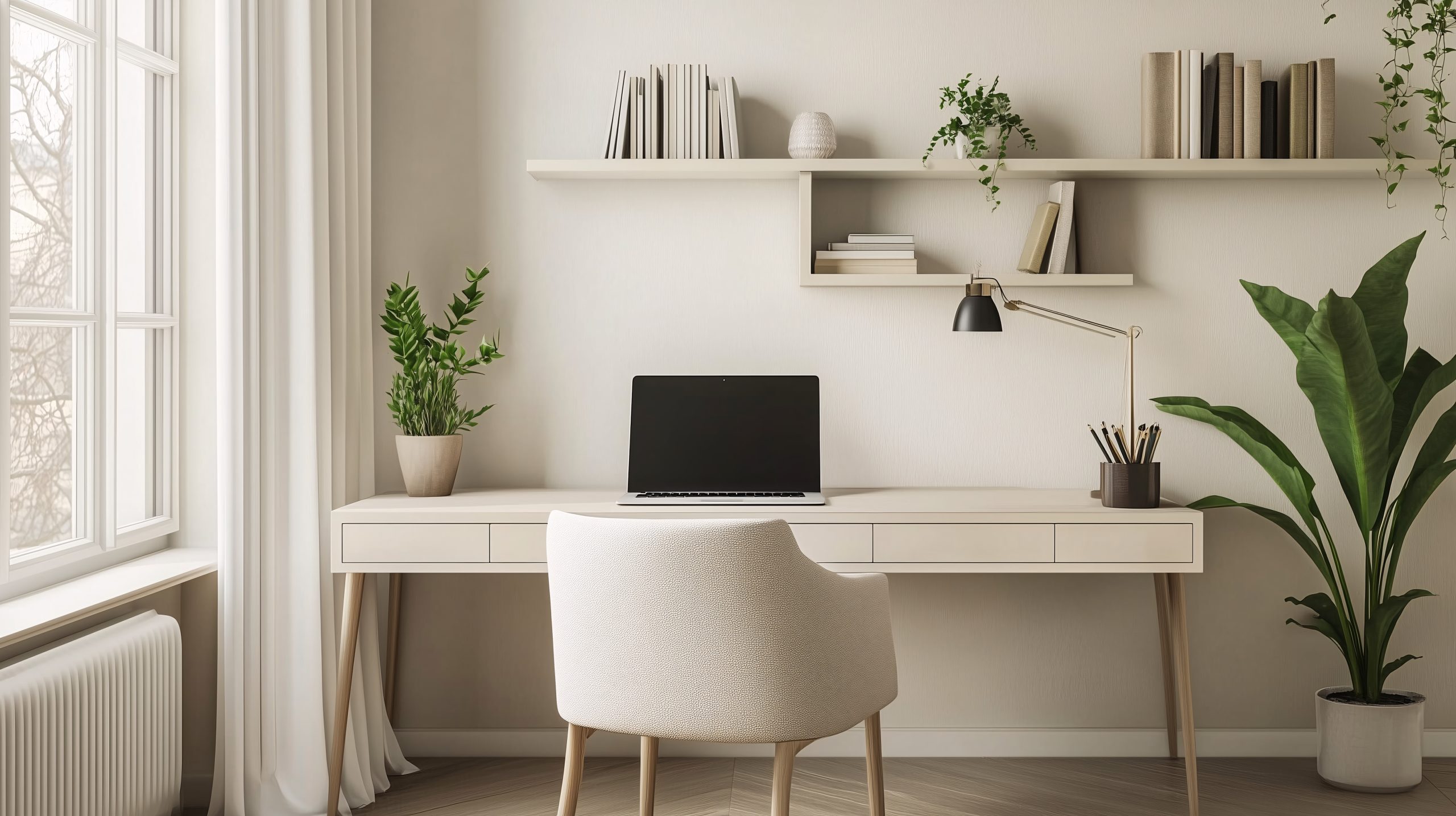
Maximising Vertical Storage
In a small office space, utilising vertical storage can be a game-changer, allowing you to make the most of your available area while maintaining a productive home office. By thinking vertically, you can free up valuable floor space and keep your workspace organised and efficient.
Consider installing wall shelves to store books, supplies, and decorative items without encroaching on your desk area. Hanging organisers can be used for smaller items like stationery, keeping them within easy reach but off your work surface. Tall storage cabinets are another excellent option, providing ample storage without taking up much floor space. By creatively using vertical storage solutions, you not only enhance the functionality of your office but also open up opportunities for innovative design. This approach not only boosts your productivity but also inspires creativity, making your home office a place where you can thrive.
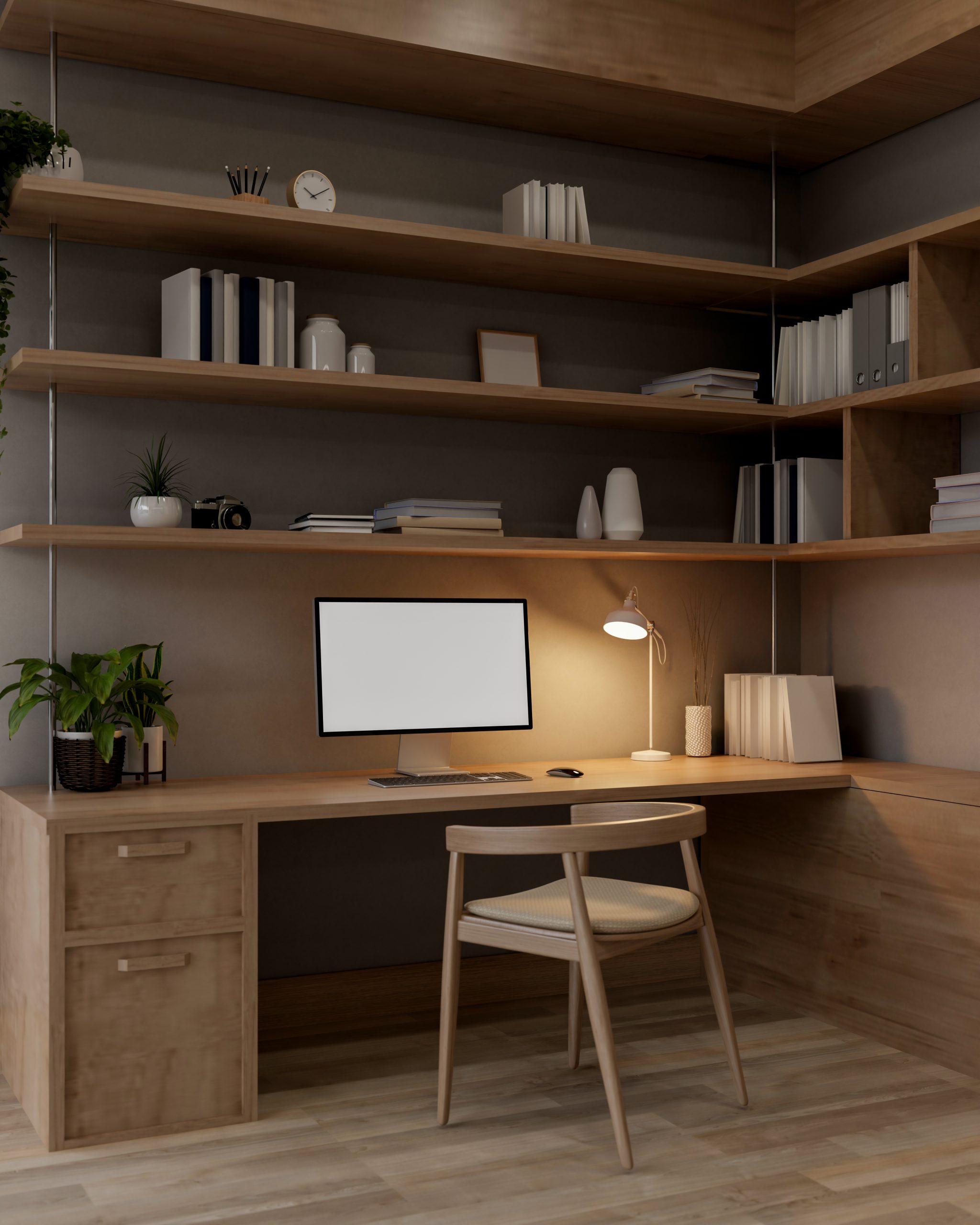
Plant Life
Incorporating plants into your home office can significantly enhance your work environment, contributing to both aesthetic appeal and improved mental well-being. Studies have shown that having plants in your workspace can reduce stress, increase productivity, and improve air quality, making them a valuable addition to any productive home office.
Plants bring a touch of nature indoors, creating a calming atmosphere that can boost your mood and focus. For those new to plant care, start with low-maintenance options like succulents or snake plants, which require minimal attention but still offer the benefits of greenery. For more experienced green thumbs, consider adding a variety of plants to create a lush, vibrant space. The presence of plants not only adds life to your office but also encourages a sense of growth and renewal, aligning with the goals of a productive home office. By integrating plant life into your workspace, you cultivate an environment that supports both your personal and professional development.
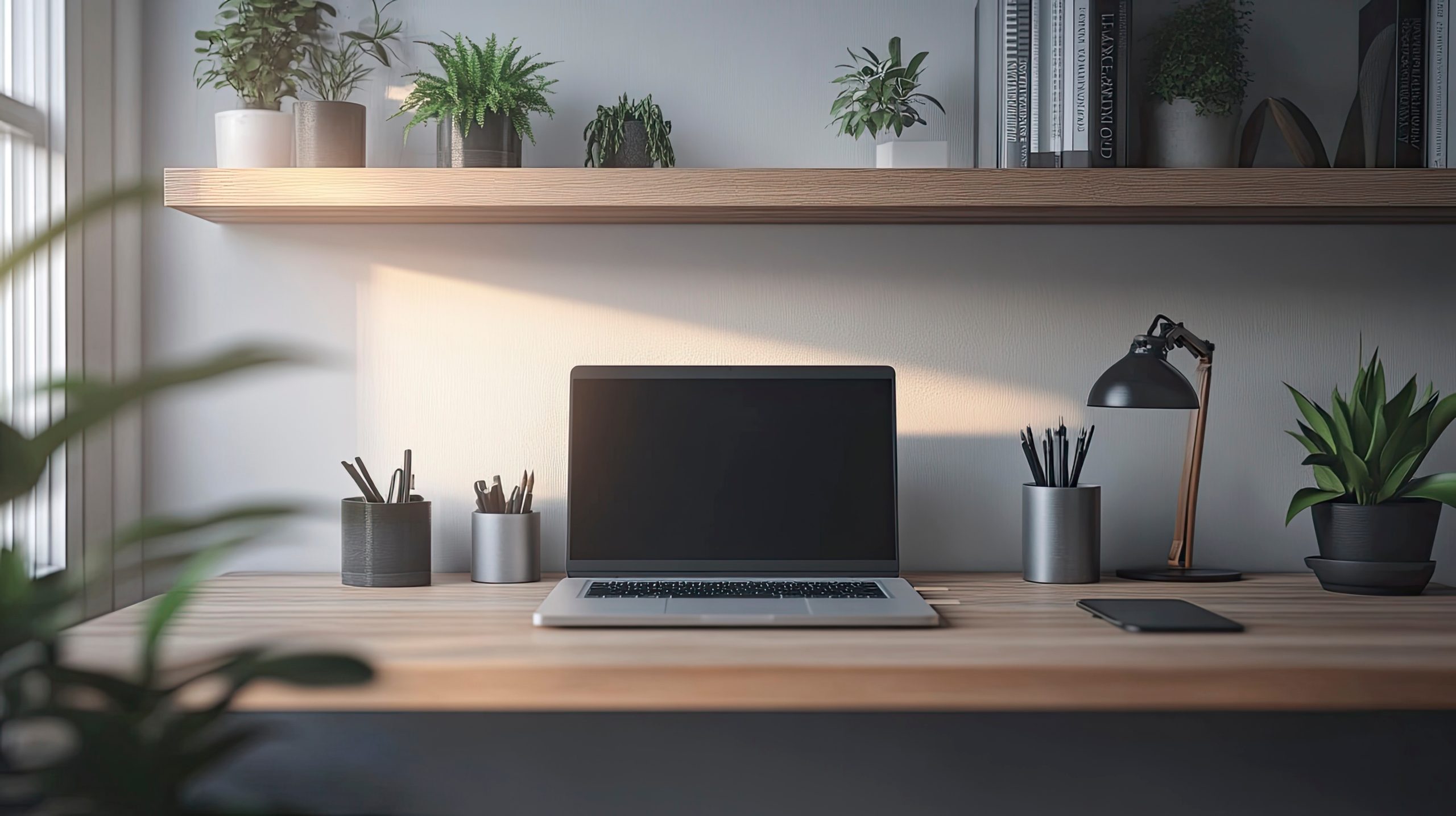
Develop Time Management Plans
Effective time management is a cornerstone of a productive home office. While a to-do list is a great starting point, developing a comprehensive schedule that includes both daily tasks and long-term goals can transform your work habits and boost productivity. By planning your time wisely, you can create a structured environment that fosters creativity and efficiency.
Consider implementing strategies like bullet journaling, which allows you to track tasks, goals, and progress in a visually appealing and organised manner. Time blocking is another effective technique, where you allocate specific time slots for different activities, ensuring that you focus on one task at a time. Additionally, adopting the “one task rule” can help you prioritise and complete tasks more effectively, reducing the overwhelm of multitasking. By developing these time management skills, you not only enhance your productivity but also create a more balanced and fulfilling work-life dynamic in your productive home office.
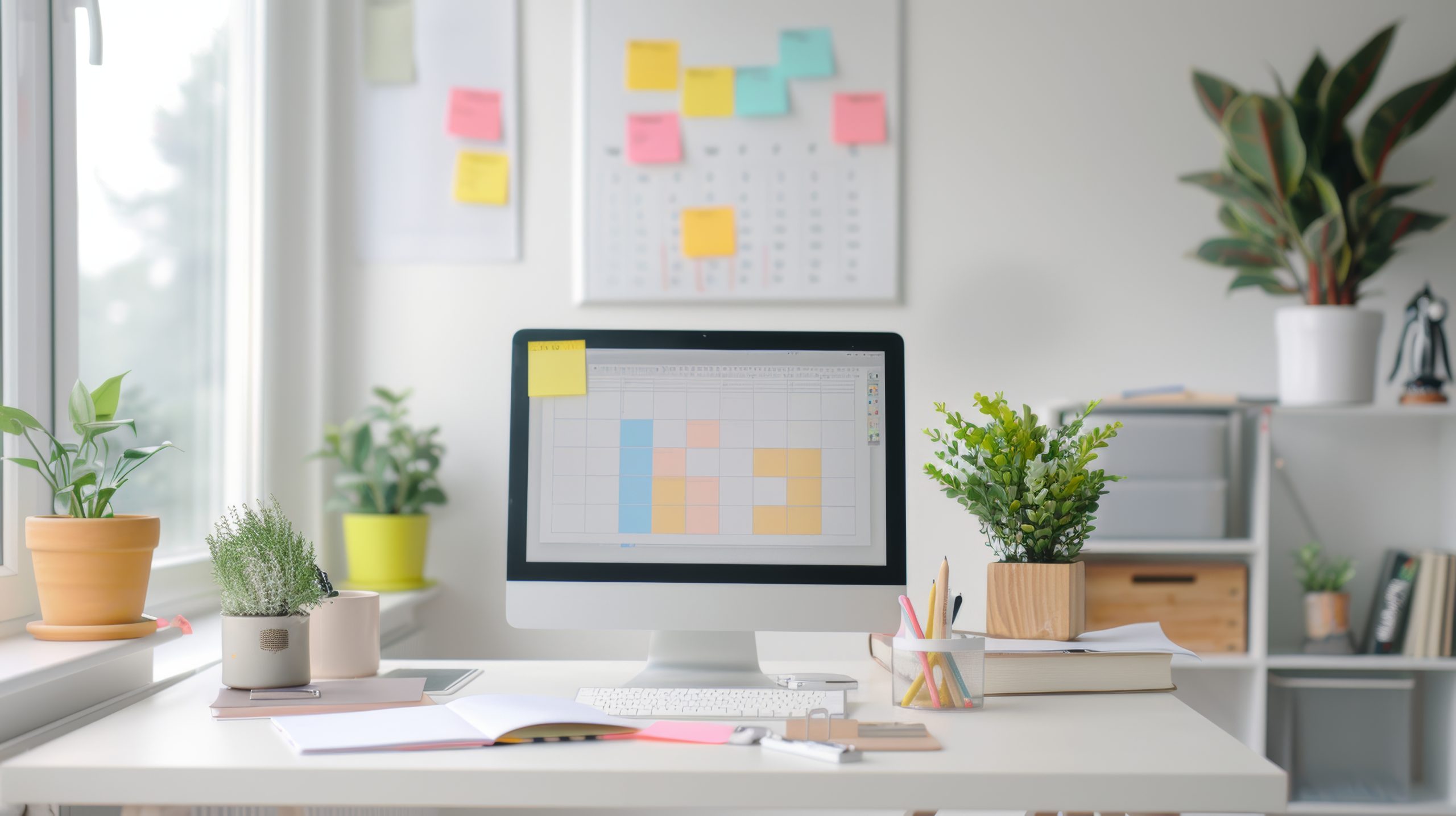
Barriers Between Chaos and Focus
Noise can be a significant distraction in a home office, disrupting your focus and reducing productivity. To create a truly productive home office, it’s essential to address both external and internal noise, ensuring a peaceful and conducive work environment.
Start by considering noise-cancelling headphones, which can help you maintain concentration by blocking out background sounds. For those who prefer a quieter space without wearing headphones, sound-absorbing panels can be installed on walls to dampen noise. Additionally, soft furnishings like rugs and curtains can help absorb sound and reduce echo, creating a more serene atmosphere. If your workspace is near a busy street or noisy area, consider using heavy drapes to block out both sound and harsh sunlight. By implementing these noise-reducing solutions, you create a sanctuary of focus and calm, allowing you to perform at your best in your productive home office.

Creating a productive home office involves more than just setting up a desk and chair; it requires thoughtful planning and attention to detail. By carefully considering the layout of your space, optimising lighting, prioritising ergonomics, and maintaining organisation, you can transform your home office into a hub of productivity and well-being. Mindful decoration, such as incorporating plants and managing noise levels, further enhances the environment, while effective time management strategies ensure you make the most of your work hours.



































































